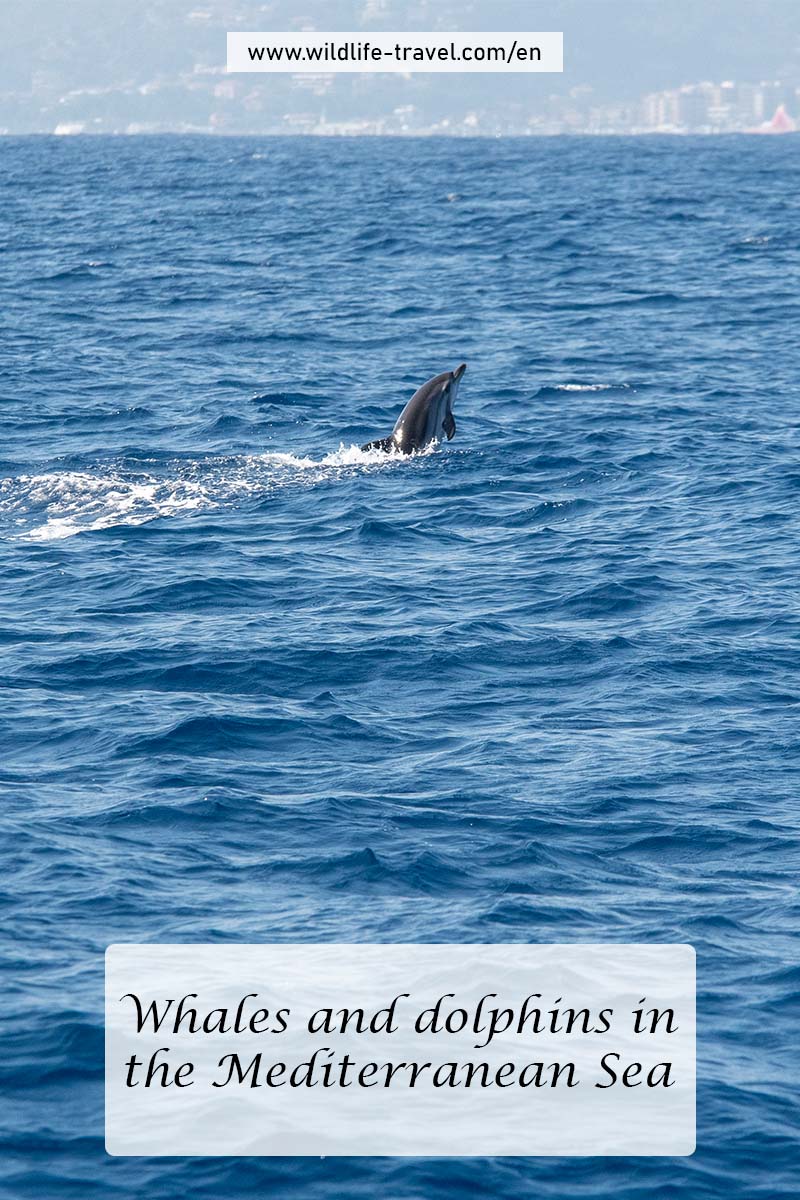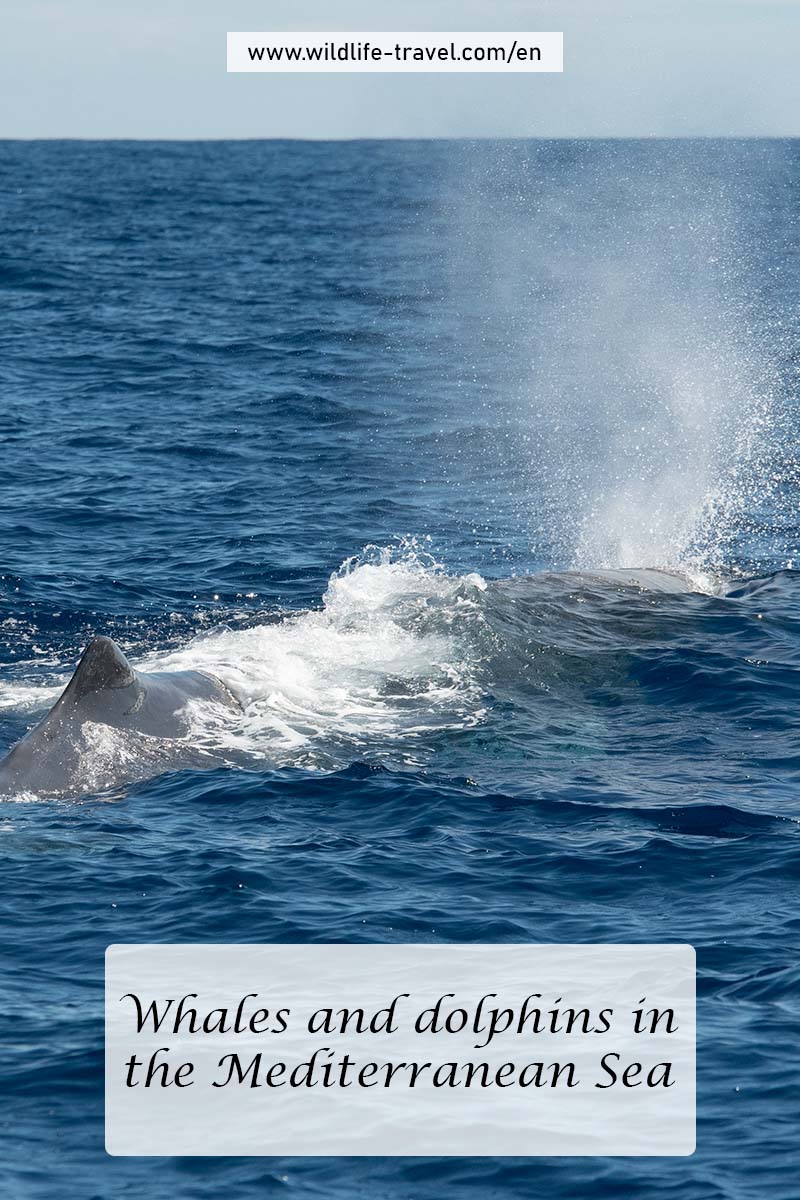Whales and dolphins in the Mediterranean Sea are a fascinating part of the region’s marine ecosystem. During my time in Sanremo, Italy, I joined a research excursion with the Tethys Institute to observe these impressive animals in their natural habitat. The warm and nutrient-rich waters of the Ligurian Sea attract several species throughout the year, making this area a great destination for marine wildlife watching. Experiencing whales and dolphins in the Mediterranean Sea offers unique insights into the region’s biodiversity and highlights the importance of preserving it. Read more about it in this blog post.
The Mediterranean Sea
Mediterranean food. Mediterranean climate. Spain, Italy, Greece – I don’t know anyone who doesn’t like the Mediterranean. Whether it’s the cuisine, the warm weather, the laid-back lifestyle, or the sea with all the leisure activities it offers – there’s something there for everyone.
Speaking of the sea: During my stay in Sanremo, in the northwest of Italy, I realized how little I actually knew about the Mediterranean Sea. It’s not far from Germany, where I live. I had already been to its shores in Spain and Greece. And the internet is overflowing with information about this vast body of water. But still, I had to admit: I knew surprisingly little about the Mediterranean Sea and the wildlife that calls it home.
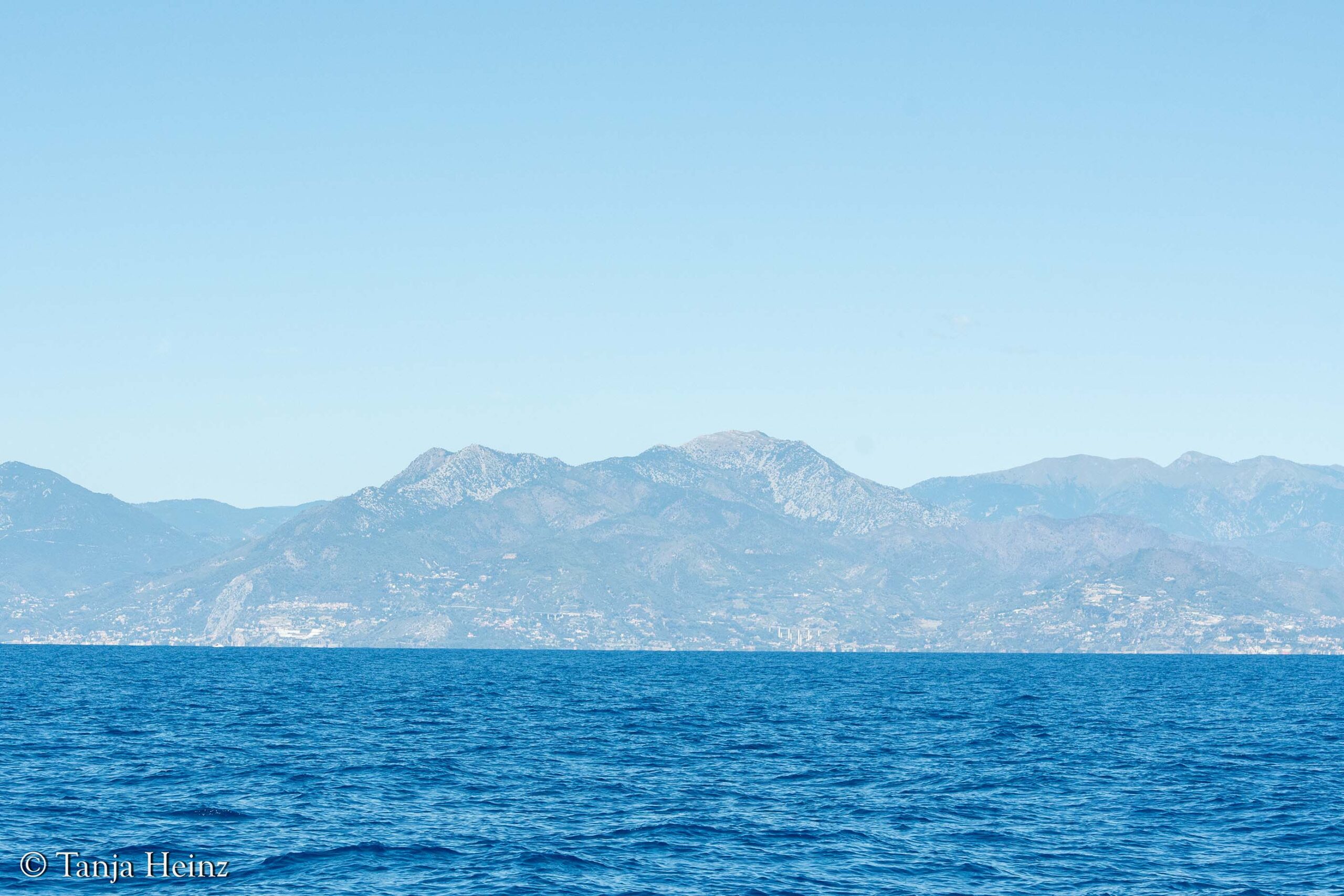
Have you ever thought about the narrow strait that connects the Mediterranean Sea to the Atlantic Ocean? It's called the Strait of Gibraltar, and at its narrowest point, it’s only about 13 to 14 kilometres wide.
And do you know how many countries border the Mediterranean? More than twenty!
Even more surprising: the Mediterranean is home to around 10,000 islands and islets – with Crete and Cyprus being the largest among them.
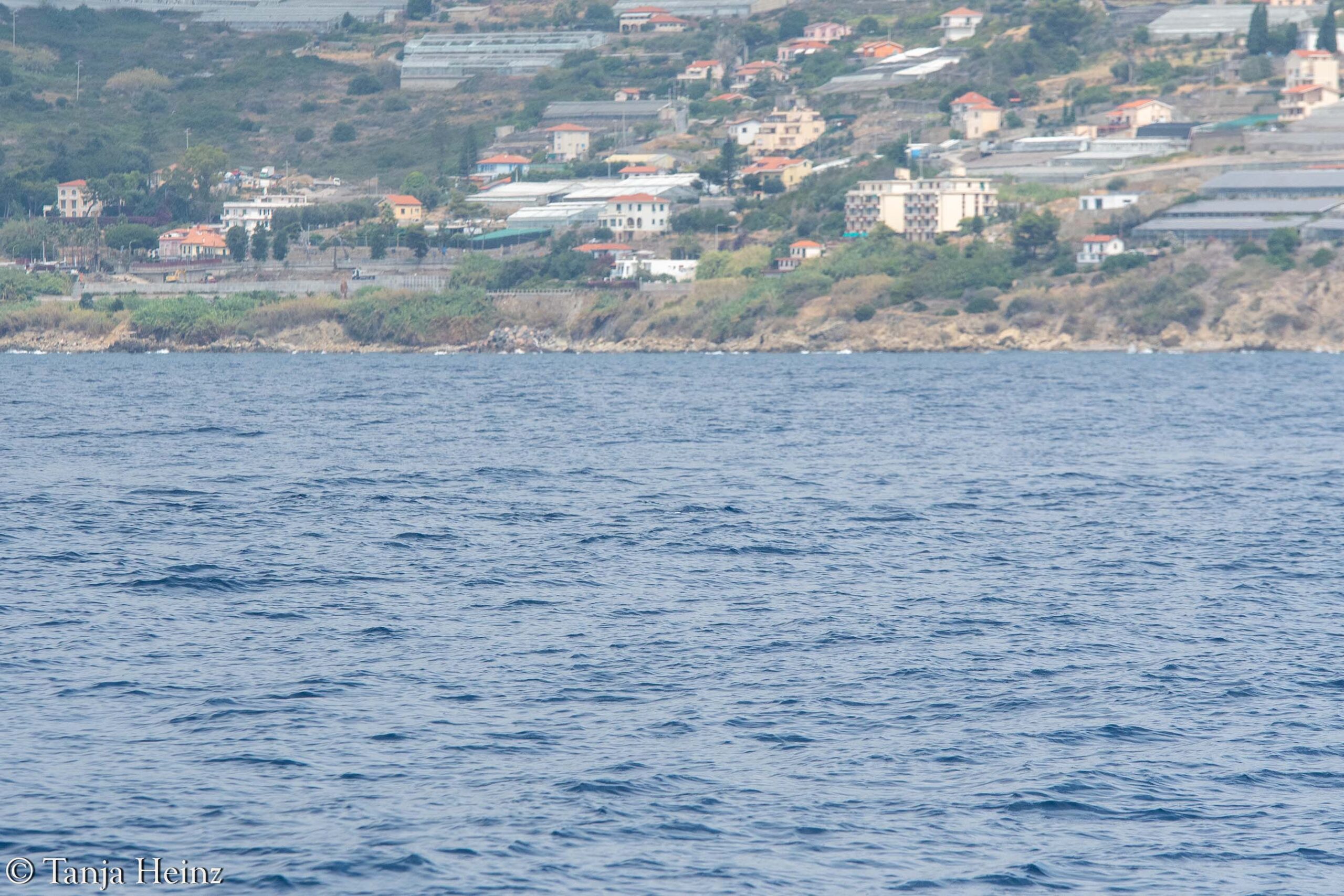
Information: According to the information I found, the following countries border the Mediterranean Sea: Albania, Algeria, Bosnia and Herzegovina, Croatia, Cyprus, Egypt, France, Greece, Israel, Italy, Lebanon, Libya, Malta, Monaco, Montenegro, Morocco, Northern Cyprus (disputed), Palestine, Slovenia, Spain, Syria, Tunisia, Turkey, and the United Kingdom – through its territories of Gibraltar and Akrotiri and Dhekeia.
Probably the most fascinating thing I learned was about the narrow strait that connects the Mediterranean Sea to the Atlantic Ocean – and just how essential it is for the sea’s survival. Without this connection – that is, without the net inflow of water from the Atlantic through the Strait of Gibraltar – the Mediterranean would lose so much water through evaporation that its sea level would drop by about one meter per year. Over time, this would cause the sea to largely dry out within a few thousand years.
Apparently, if the Strait of Gibraltar were closed, the Mediterranean’s sea level would decrease by roughly one meter per year due to the imbalance between high evaporation and relatively low precipitation and river inflow.
The water entering the Mediterranean through the Strait of Gibraltar is cooler and less salty than the water already in the sea. As it circulates eastward, it gradually warms up and increases in salinity. This denser water then sinks, especially in the eastern Mediterranean, and begins to move westward at deeper levels, eventually exiting the sea through the same strait.
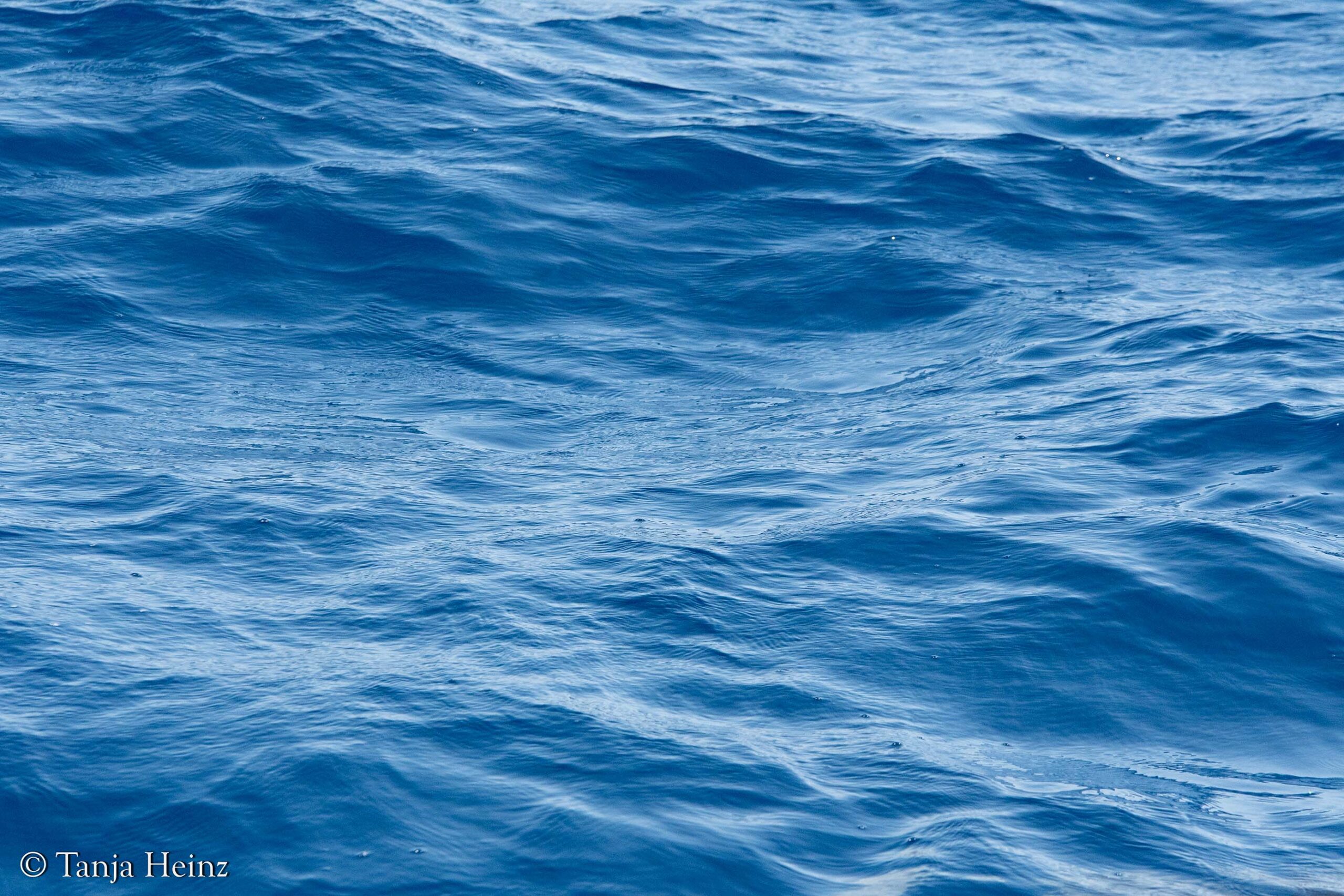
This is, of course, a simplified description of the complex water circulation system in the Mediterranean. But in general terms, it’s accurate to say that evaporation in the Mediterranean far exceeds precipitation and river inflow – which is why the inflow from the Atlantic is essential.
As for tides, they are relatively limited in the Mediterranean Sea due to the narrow connection with the Atlantic. Nevertheless, tidal forces still play a role in driving the water exchange between the two bodies of water.
Information: Because the Mediterranean Sea is almost entirely enclosed by land, the water within it tends to stay for a remarkably long time. Estimates of this residence time vary, but it is generally believed to be between 80 and 100 years. To the best of my knowledge, this range reflects the diversity of scientific assessments on how long water typically remains in the Mediterranean before being replaced.
The most alarming fact I discovered about the Mediterranean Sea is how significantly it has warmed in recent years. Data from the Copernicus Marine Service show that June 2025 was the warmest June ever recorded in the region, with an average sea surface temperature of 23.86°C. Moreover, 62% of the Mediterranean’s surface experienced marine heatwaves of strong or greater intensity.
A report from the European Environment Agency reveals that European seas—including the Mediterranean—have warmed significantly since 1870, with recent years ranking among the hottest on record. Under high-emission scenarios, sea surface temperatures are expected to rise by an additional 2 to 6°C by 2100, resulting in more frequent and intense marine heatwaves.
Statista features a chart displaying surface temperature anomalies of the Mediterranean Sea from 1994 to 2023, clearly illustrating the upward trend in sea surface temperatures over this period.
This is deeply concerning — not just for the incredible marine life of the Mediterranean Sea, but for all of us on this planet.
Before diving into the main topic of this blog post — whales and dolphins in the Mediterranean Sea — let’s take a moment to appreciate some key facts about this unique sea.
The Mediterranean Sea covers an area of approximately 2,500,000 km², making up about 0.7% of the world’s ocean surface.
That might seem like a small fraction, but for a semi-enclosed sea, it's truly remarkable — both in size and in ecological importance.
The Mediterranean Sea stretches approximately 4,000 kilometres from west to east, spanning from the Strait of Gibraltar to the Gulf of Iskenderun in southeastern Turkey. From north to south, its widest point—from the southern coast of Croatia to the shores of Libya—measures about 800 kilometres. To put that into perspective, that's roughly the distance from London to Cairo.
In the northeast, the Mediterranean Sea is connected to the Black Sea through the Bosporus Strait, and in the southeast, it links to the Red Sea via the Suez Canal.
When I travelled to Italy in the summer of 2023 to observe whales and dolphins in the Mediterranean Sea, I stopped in Sanremo, located along the Ligurian Sea.

Did you know? The Mediterranean Sea is divided into 15 marginal seas, each with its own distinct characteristics. One of them is the Ligurian Sea, where Sanremo is located. Others include the Ionian Sea, Tyrrhenian Sea, Balearic Sea, Adriatic Sea, and Aegean Sea — just to name a few.
Whales and dolphins in the Mediterranean Sea
There are many places where you can observe whales and dolphins in the Mediterranean Sea. So, why did I choose Sanremo?
Well, I decided on Sanremo because it's home to the Tethys Research Institute, a non-profit organization dedicated to the study and conservation of whales and dolphins in the Mediterranean Sea. What makes Tethys especially interesting is that it not only conducts scientific research, but also offers multi-day boat expeditions where participants can actively take part in fieldwork.
You don’t need to be a marine biologist, a student, or a specialist to join. Anyone with an interest in whales and dolphins in the Mediterranean Sea can take part, learn from experienced researchers, and gain first-hand insight into how marine scientists study large marine mammals at sea (left: bottlenose dolphins, right: sperm whale).


Just a quick note: Before heading to Sanremo to observe whales and dolphins in the Mediterranean Sea, I made a short stop in Nice (France) and also visited the Oceanographic Museum in Monaco. If you're interested in these two places, feel free to check out my previous blog post!
The study area of the Tethys Research Institute lies within the Pelagos Sanctuary for Mediterranean Marine Mammals — a vast marine protected area dedicated to species such as whales and dolphins in the Mediterranean Sea. It has also been officially designated a Specially Protected Area of Mediterranean Importance (SPAMI).
Covering an area of approximately 84,000 km², the sanctuary is located in the northwestern Mediterranean Sea, stretching between Italy, France, and the island of Sardinia, and encompassing Corsica and the Tuscan Archipelago.
Established in 1999 through an agreement between Italy, France, and the Principality of Monaco, the Pelagos Sanctuary is, to the best of my knowledge, the first — and currently still the only — international high seas protected area in the world.

Do you want to learn more about the Pelagos Sanctuary? I recommend visiting the website of the Tethys Research Institute. There, you'll find both short and in-depth information about this important marine protected area. For even more details, you can also check out the official website of the Pelagos Sanctuary, which offers comprehensive insights into its purpose, history, and conservation efforts.
The Pelagos Sanctuary is home to eight cetacean species:
- Fin whale (Balaenoptera physalus)
- Sperm whale (Physeter macrocephalus)
- Cuvier’s beaked whale (Ziphius cavirostris)
- Long-finned pilot whale (Globicephala melas)
- Risso’s dolphin (Grampus griseus)
- Bottlenose dolphin (Tursiops truncatus)
- Common dolphin (Delphinus delphis)
- Striped dolphin (Stenella coeruleoalba)
Well, from all of these eight species, I have already seen five species.
I have seen common dolphins in the Azores (photo on the left) and in South Africa (photo on the right).
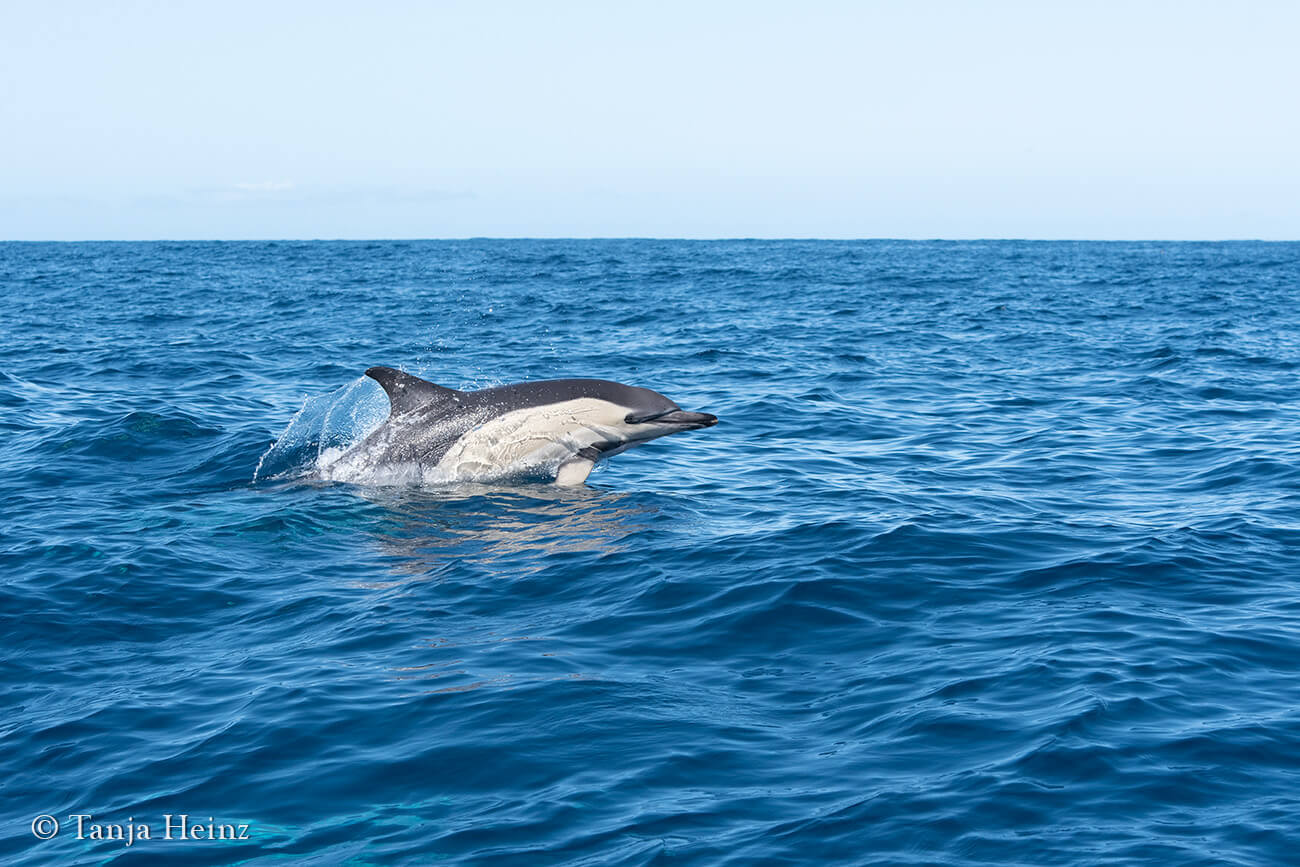
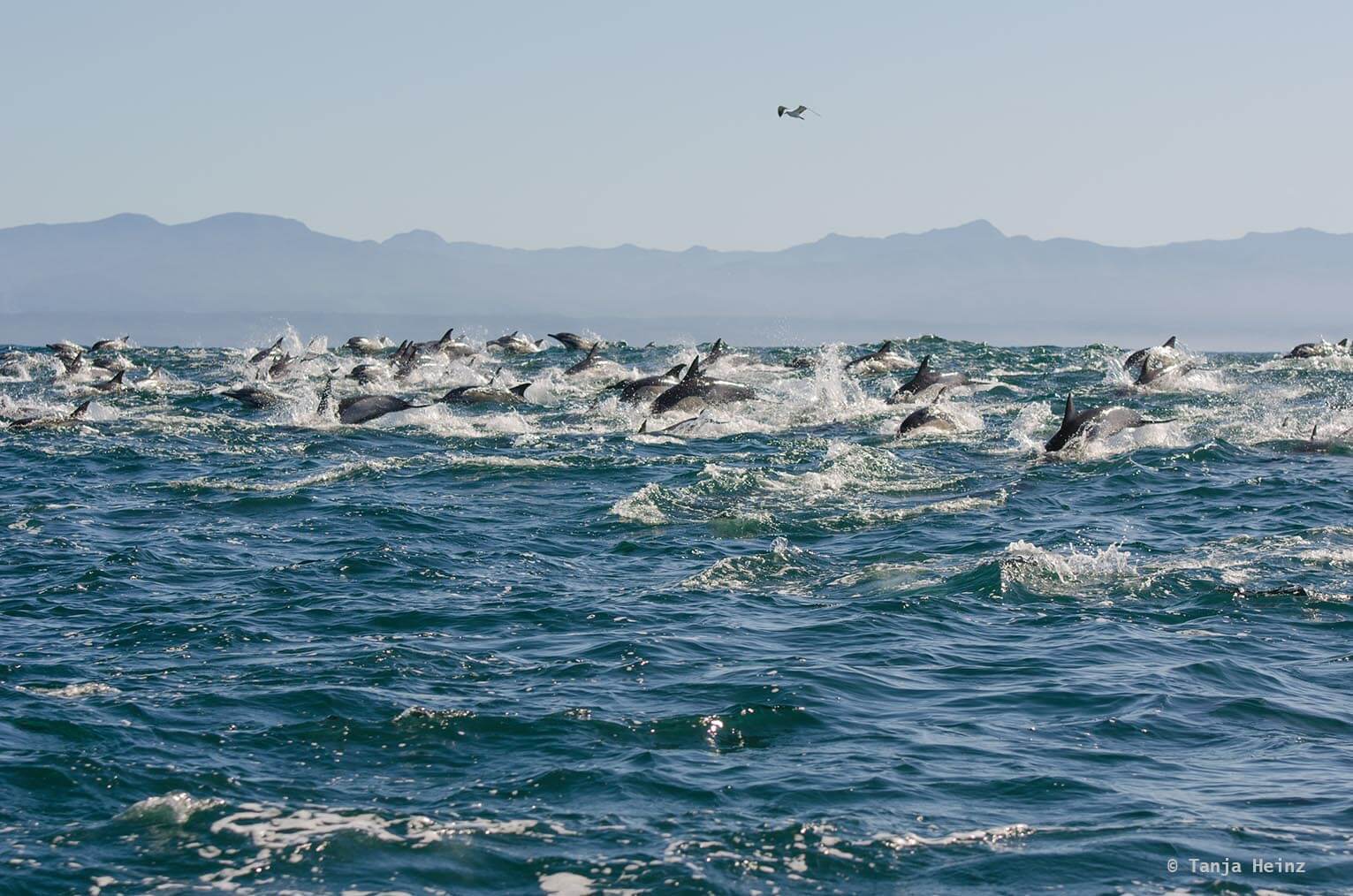
When I was in the Azores, I caught a brief glimpse of a striped dolphin in the distance.
In contrast, while out on the water near Barcelona, I had the chance to observe quite a few of striped dolphins up close.
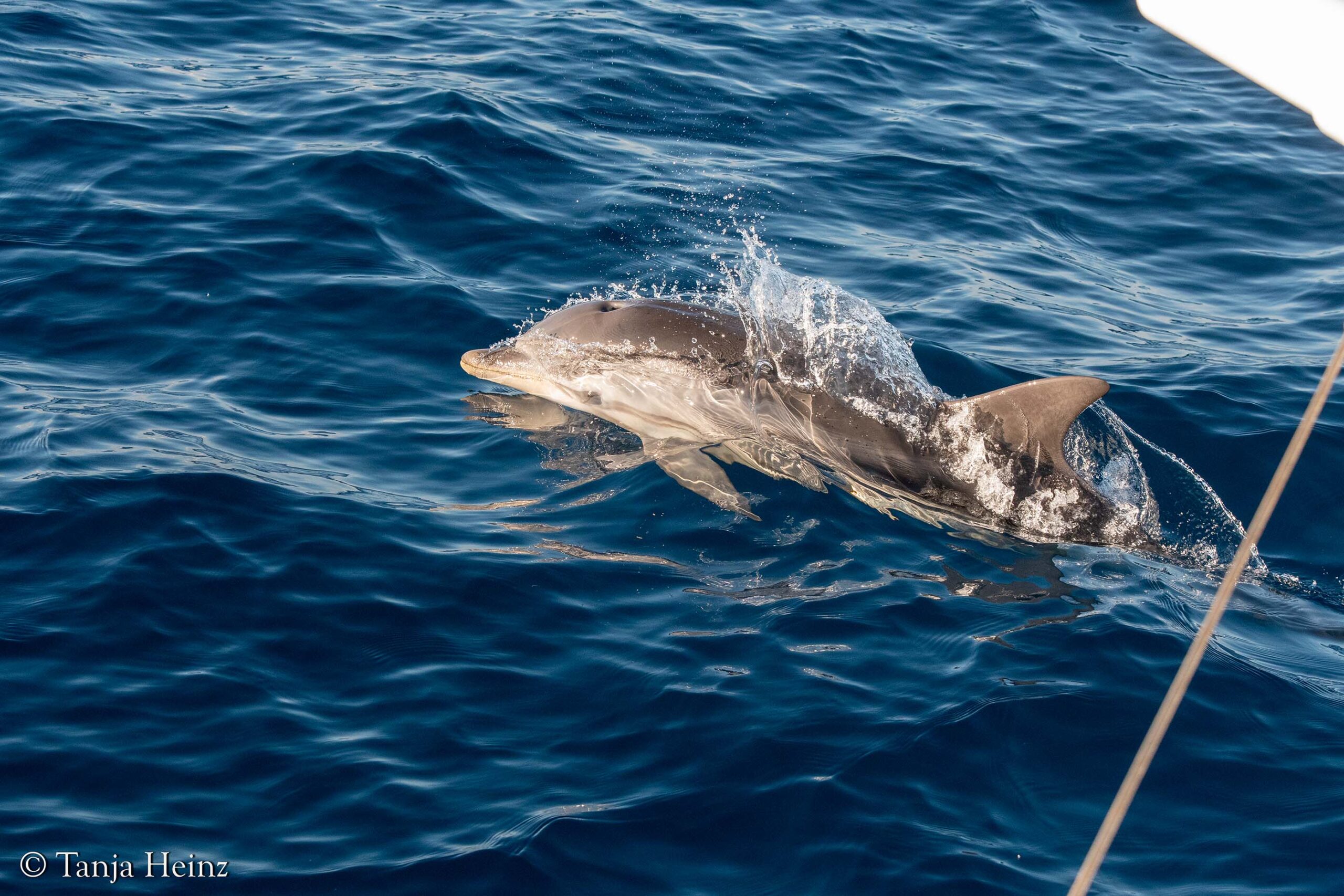
I’ve had the chance to observe bottlenose dolphins (photo on the left) in several places — including the Azores, South Africa, and Spain — as well as Risso’s dolphins (photo on the right), which I’ve seen in the Azores and Spain, though not in South Africa.
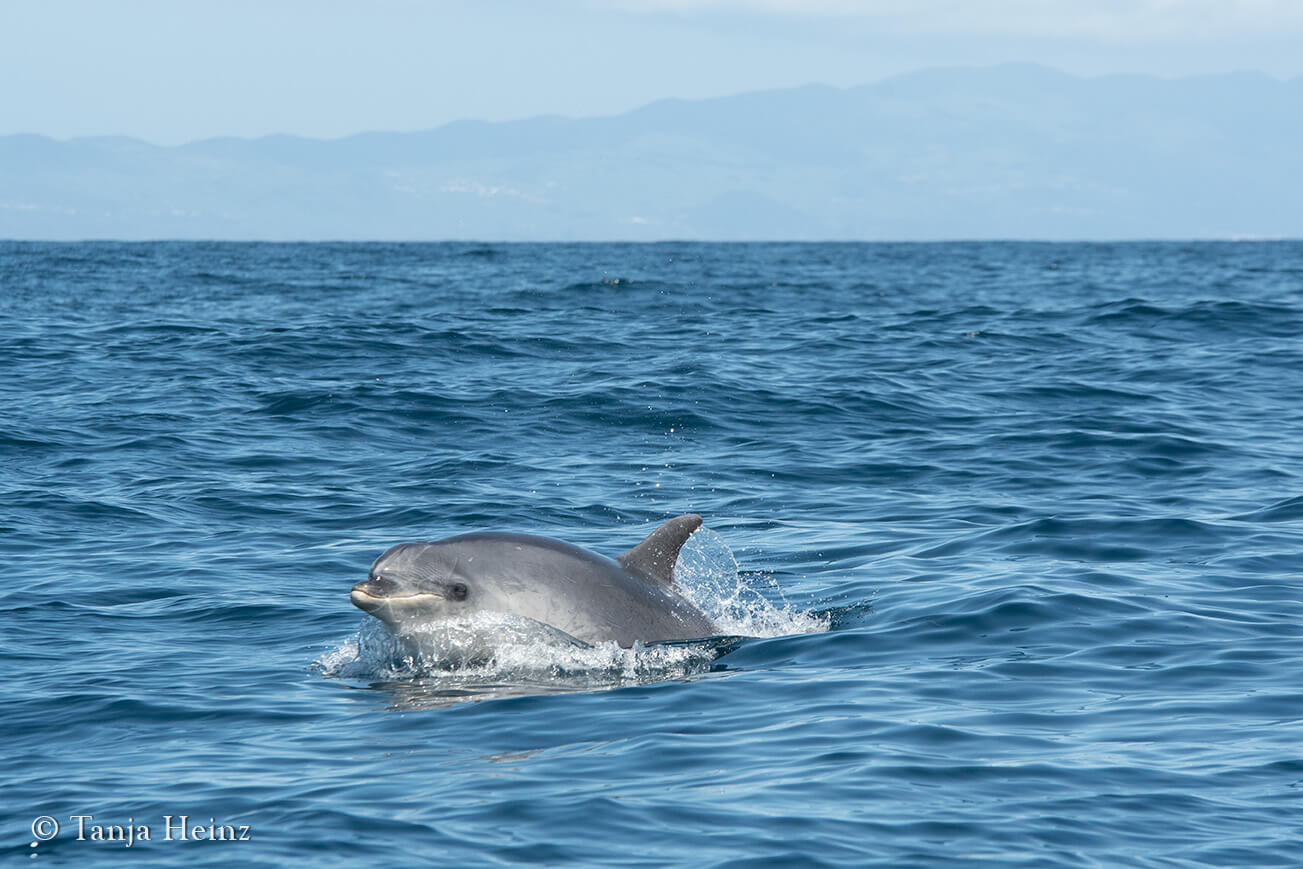
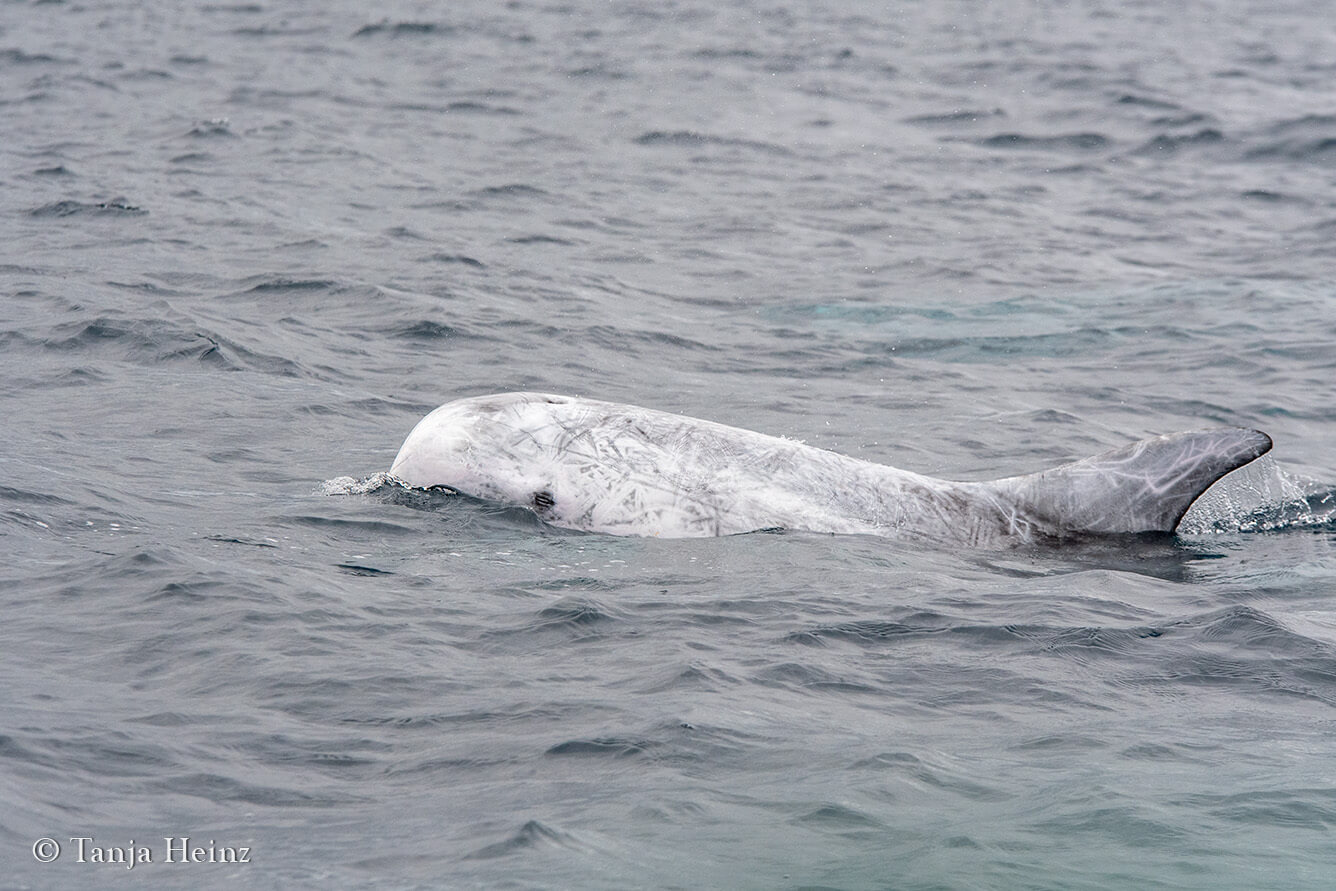
The Azores are an excellent place to observe whales and dolphins — and of course, it’s where I had the chance to see sperm whales (photo on the left).
Tenerife is also a fantastic destination for marine wildlife encounters. That’s where I came across short-finned pilot whales (photo on the right).
Long-finned pilot whales, however, are a species I haven’t had the chance to see — at least not yet.

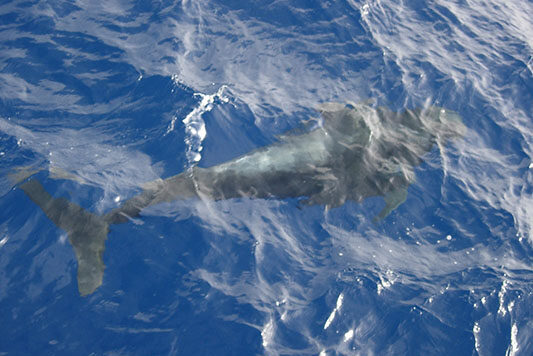
Regarding fin whales, I have actually seen them — but only from a very, very long distance, so I wouldn’t really count it as a proper sighting.
So, maybe, I can say that I’ve already spotted six species of whales and dolphins in the Mediterranean Sea. However, the Cuvier’s beaked whale remains a mysterious species to me, still waiting to be discovered.
Information: If you would like to learn more about these eight species, please visit the Pelagos Sanctuary website, where you can find detailed information, interesting facts, and additional resources about each species. By the way, in the Mediterranean Sea, you can also occasionally spot monk seals.
Sanremo: Day 1
On the very first day of my stay at the Tethys Research Institute, we were fortunate enough to head out to sea in search of whales and dolphins in the Mediterranean Sea. The weather was far from perfect, yet still calm enough to allow us to set off.
We remained close to the shore, scanning the Mediterranean waters for any signs of marine life. To our delight, luck was on our side right from the start: we encountered a group of graceful bottlenose dolphins.

Bottlenose dolphins are truly fascinating creatures. Although their appearance is rather simple, with their mostly grey coloration, I never tire of watching them.
I would say they are among the most popular dolphin species, as they often display playful behaviour and spend much time near the surface. On this occasion, however, we didn’t see them performing leaps or acrobatics. Instead, they were gathered around a fishing boat — most likely hoping to catch an easy meal.
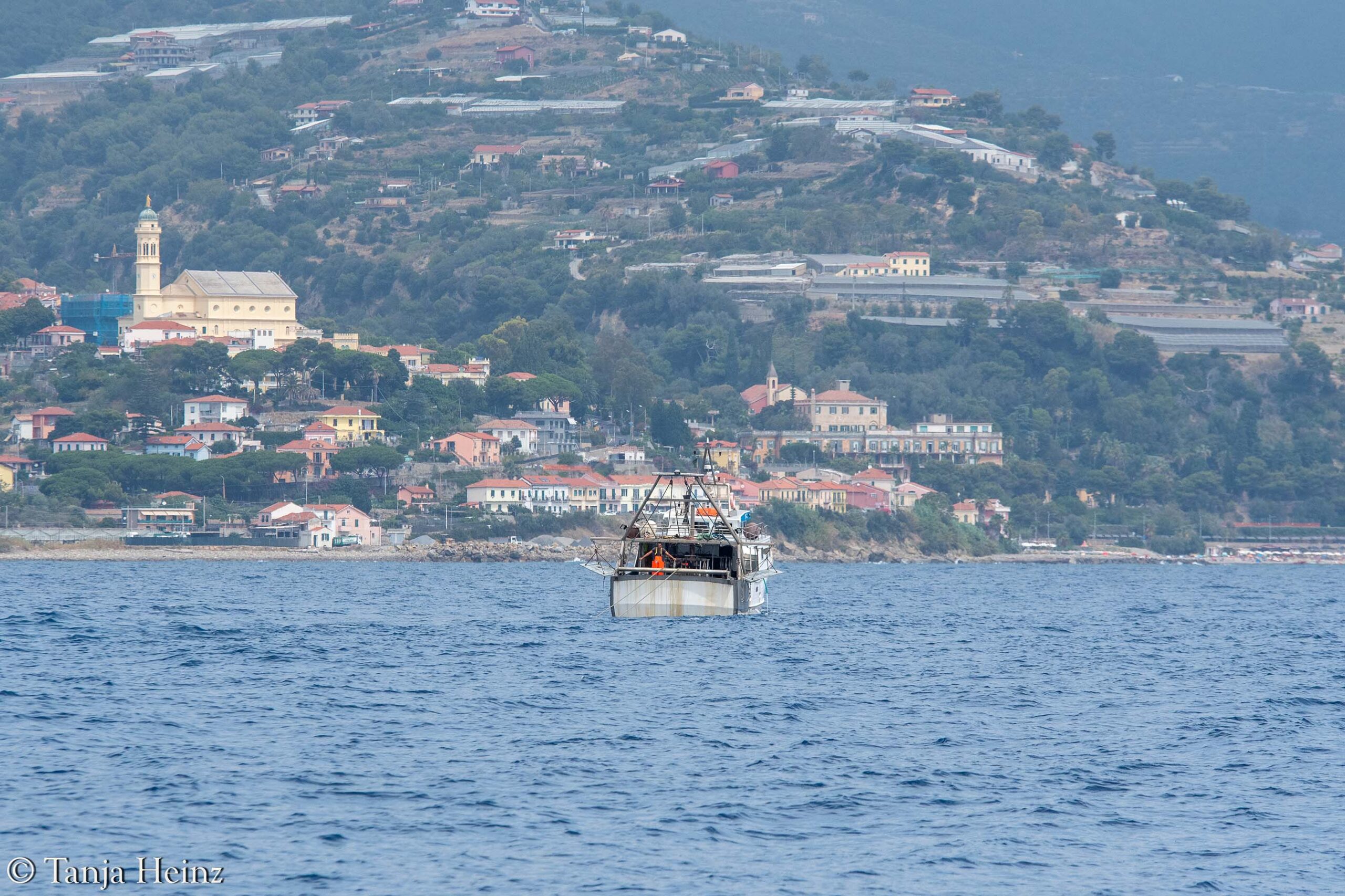

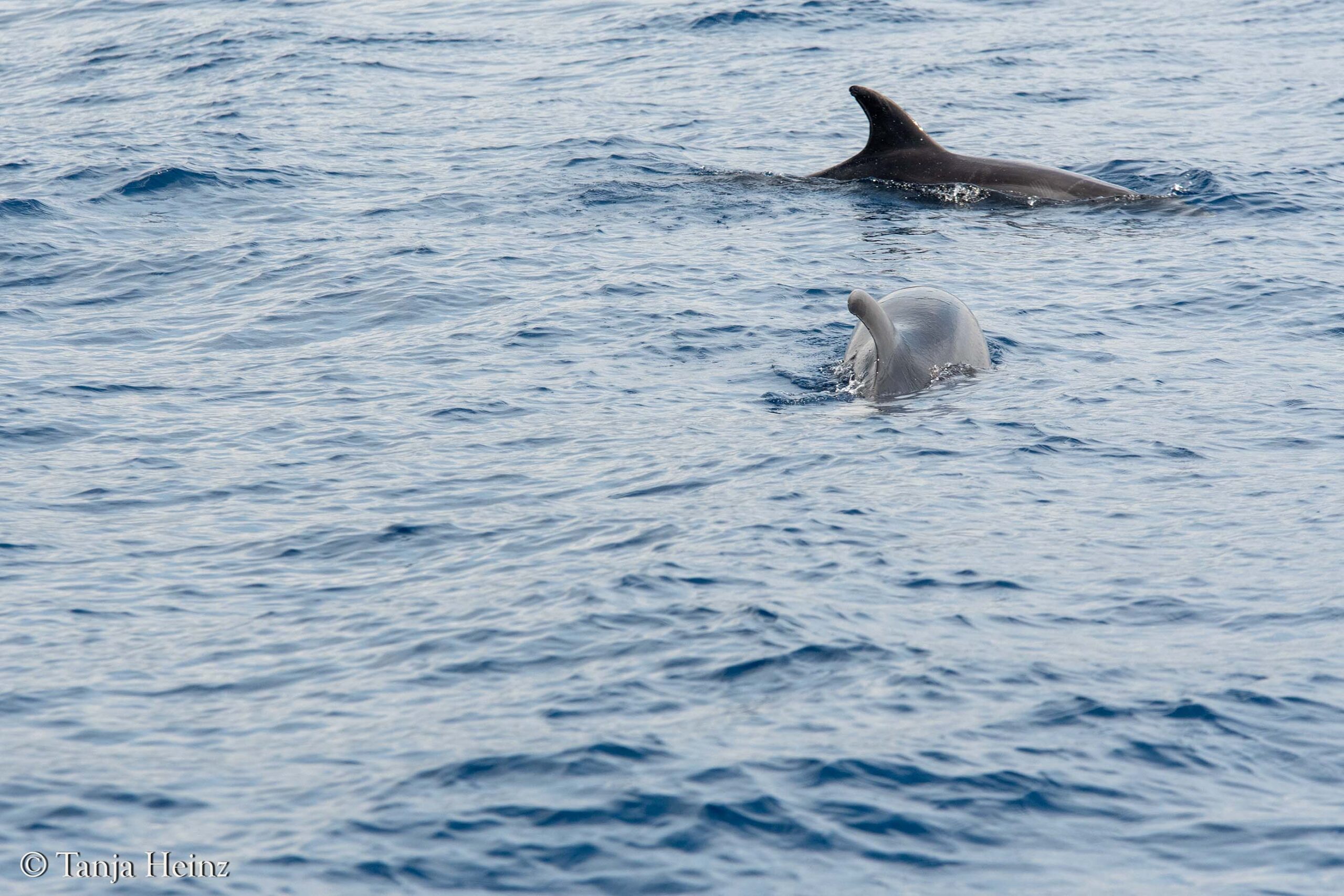
When we spotted the bottlenose dolphins, excitement quickly spread across the boat. Researchers and interns rushed to gather as much data as possible while the animals lingered at the surface.
At the Tethys Institute, one of the key methods used is photo-identification: by photographing the dolphins’ dorsal fins, researchers can recognize individual animals. This technique provides valuable insights into their distribution, social structures, and seasonal presence.
I also tried my hand at photographing the dolphins’ dorsal fins — which turned out to be quite a challenge! Afterwards, I was happy to share my pictures and contribute them to the ongoing research.
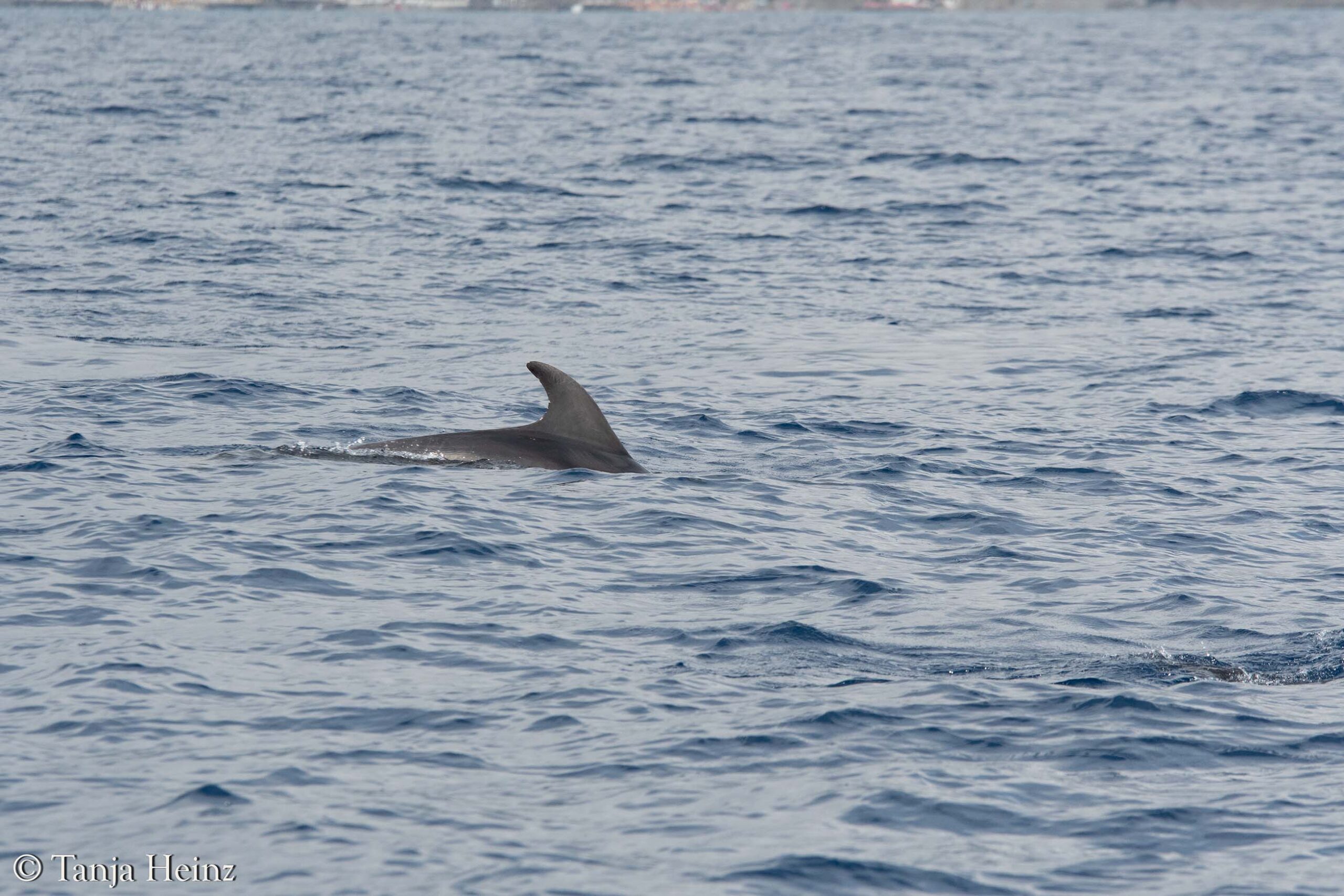
Information: If you are interested in citizen science, there are many ways to participate. For example, there is Happywhale, where you can contribute whale fluke photographs to help track whale movements. Another great option is iNaturalist — a platform where you can record and share observations of all kinds of plants and animals, contributing to real scientific research and biodiversity monitoring.
By the way, when taking photographs, it’s important to choose an angle that clearly shows the markings on a dolphin’s dorsal fin. For instance, these two particular photos wouldn’t be very useful for photo-identification purposes.
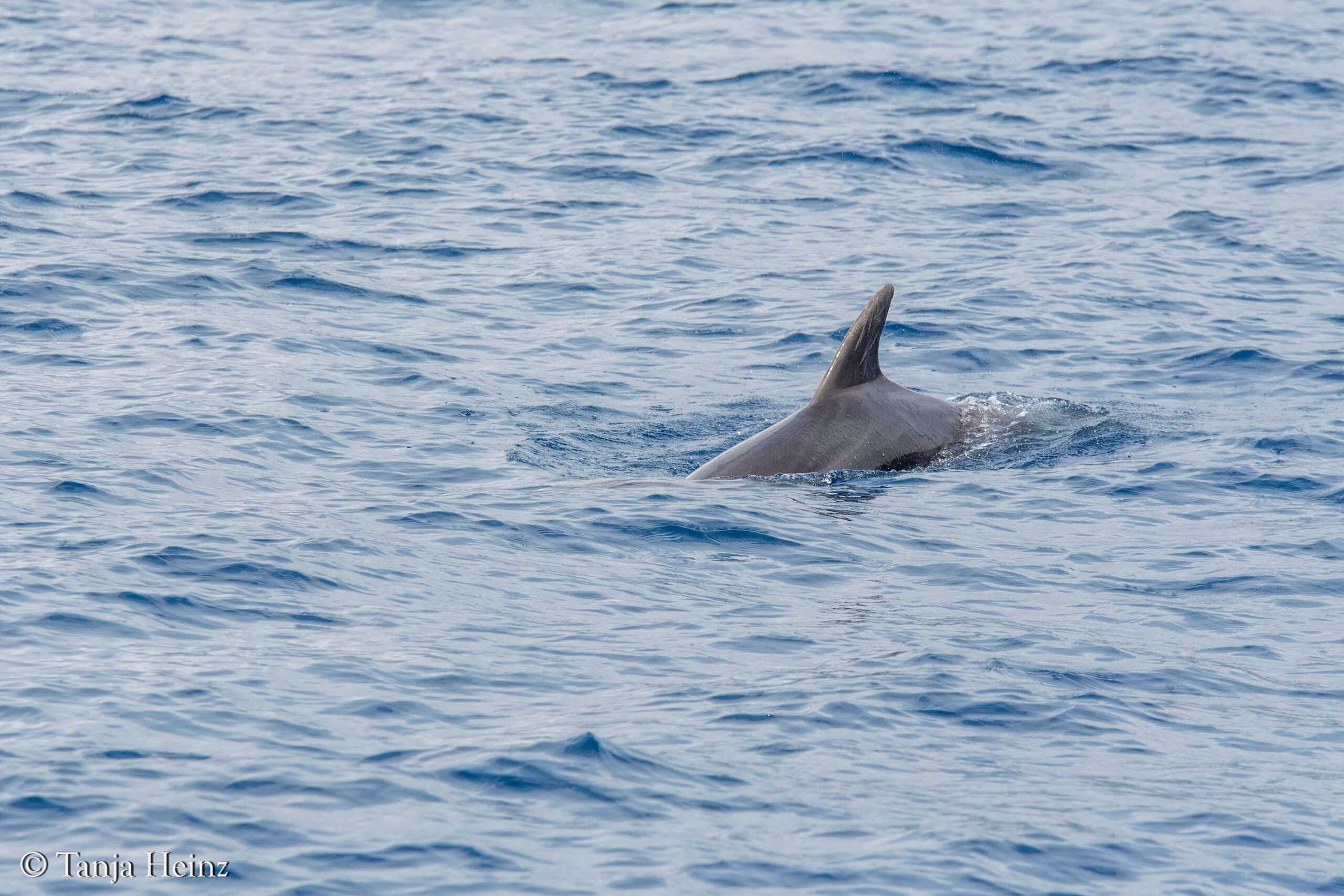

Although the Mediterranean Sea is home to many species of whales and dolphins, on that day we “only” saw bottlenose dolphins. The group we encountered was relatively small. Interestingly, some bottlenose dolphin groups can number up to 1,000 individuals (see Whales, Dolphins, and Seals – A Field Guide to the Marine Mammals of the World) — an impressive sight, though I have yet to witness anything of that scale myself.
The dolphins we observed seemed quite focused on feeding, so they probably paid little attention to our presence.
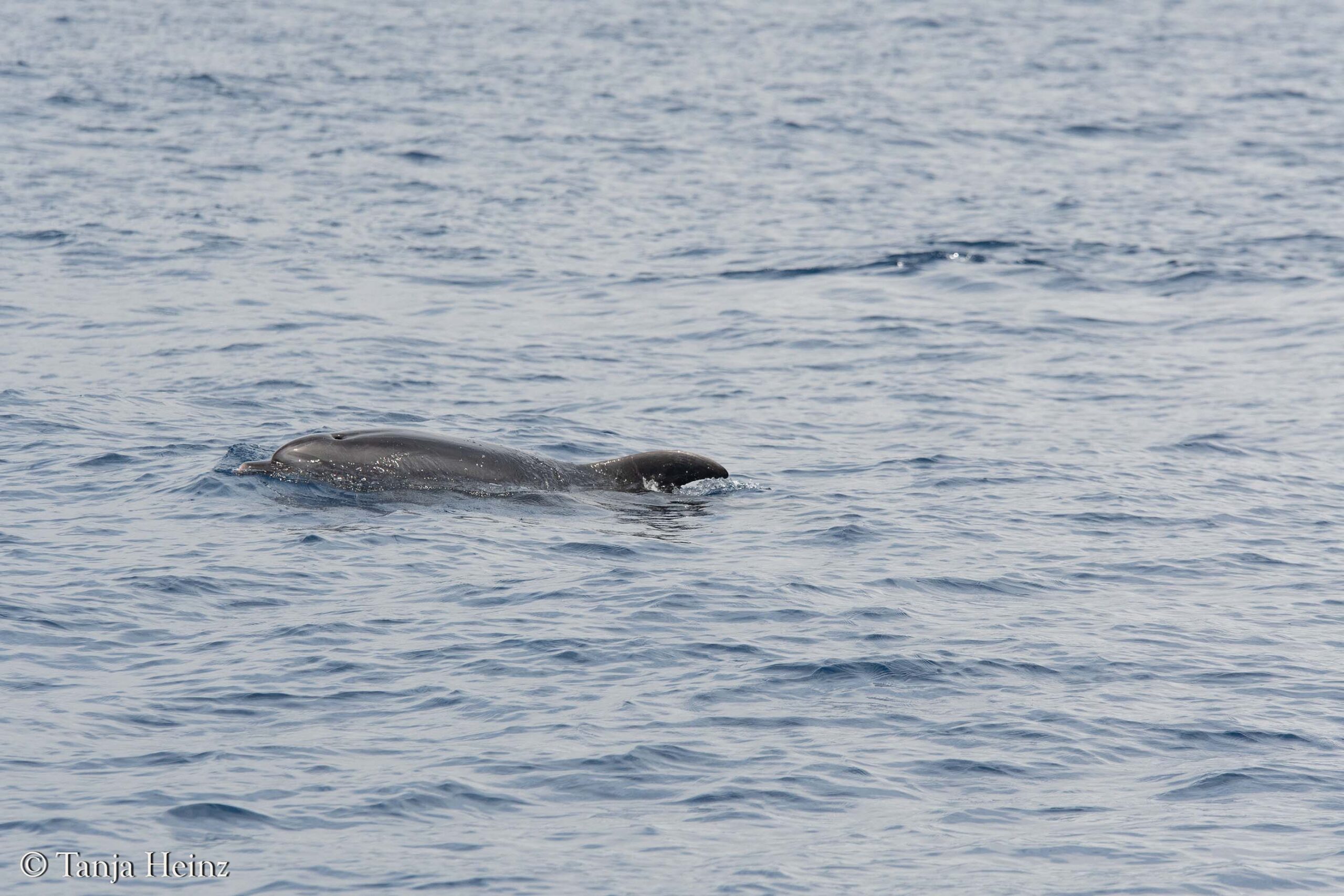
I was doing my best to capture a beautiful photograph, but it proved to be quite challenging. It wasn’t the moving boat that made it difficult — rather, it was the unpredictable behaviour of the dolphins. You never knew when or where the next one would appear.

And whenever I focused on a single dolphin, it usually swam so fast that I couldn’t capture its face. As a result, I often ended up with only a partial view — either half of the face or just the back.
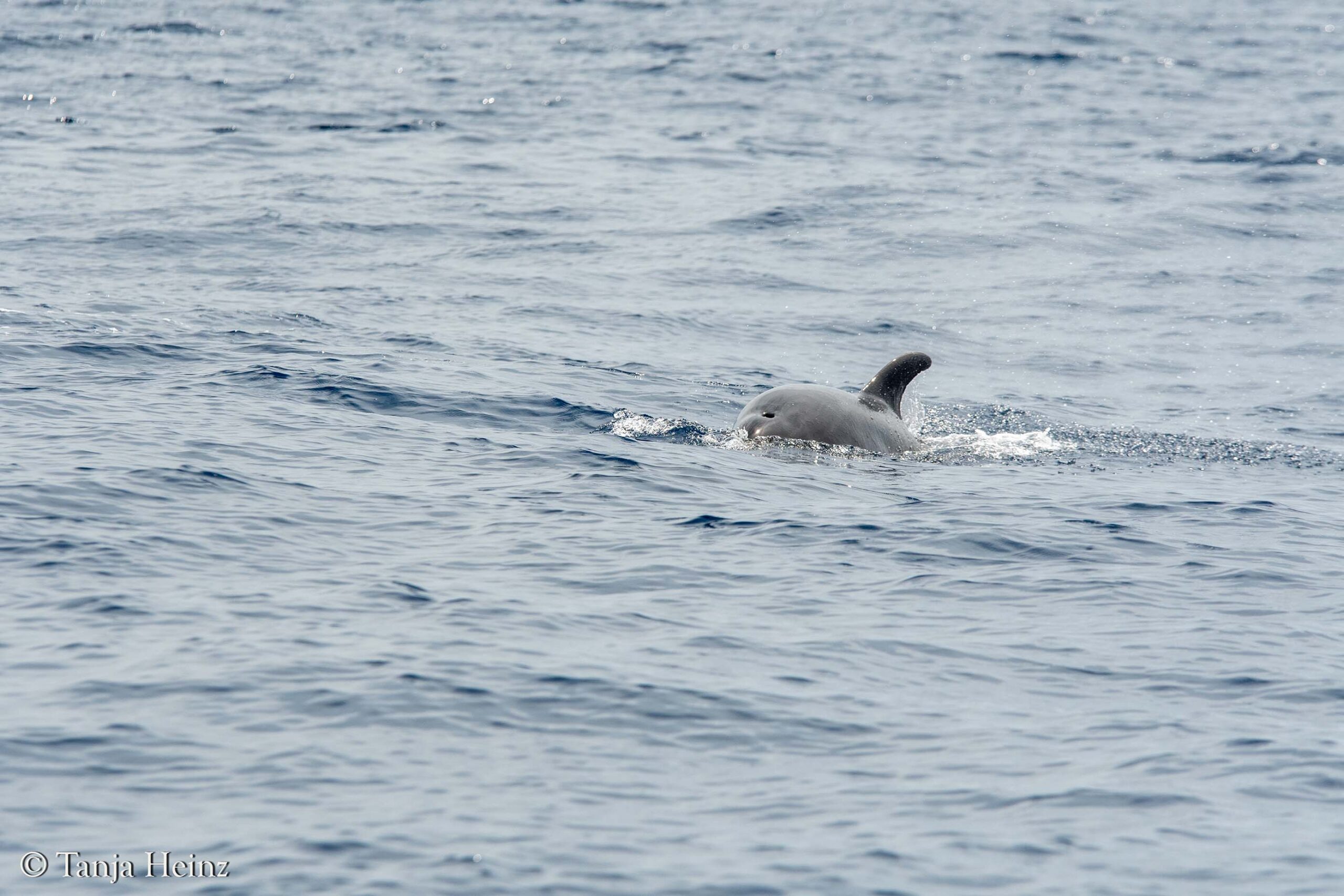
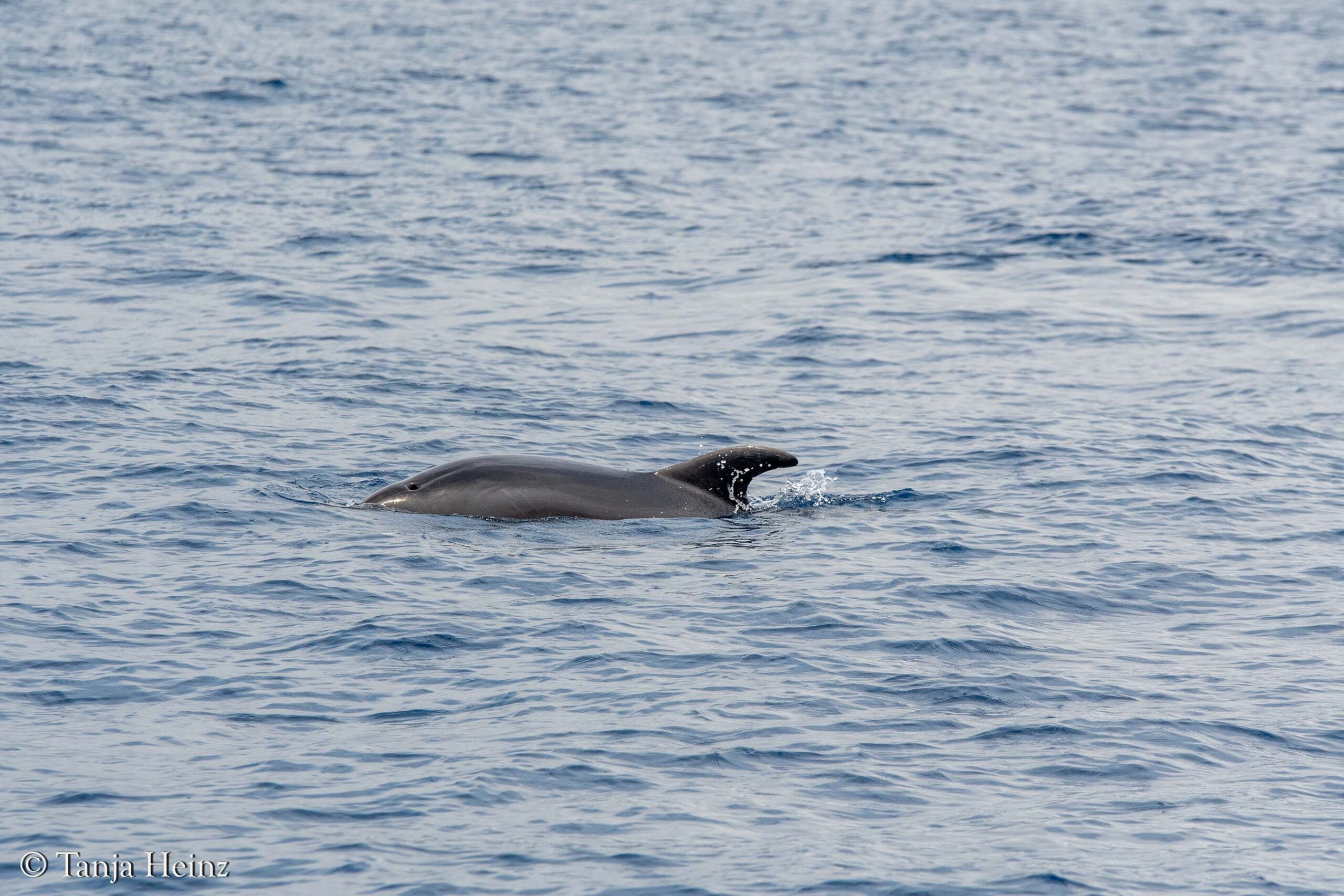
Our first trip out of the port took place in the morning, while in the afternoon we stayed docked because the wind had picked up. When it’s too windy, not only is it harder to spot dolphins due to the choppy waves, but it also raises safety concerns.
As a result, our first outing was relatively short, and we only saw one dolphin species. On the way back to the port, however, we were treated to a small delight: a group of glossy ibises flying overhead.
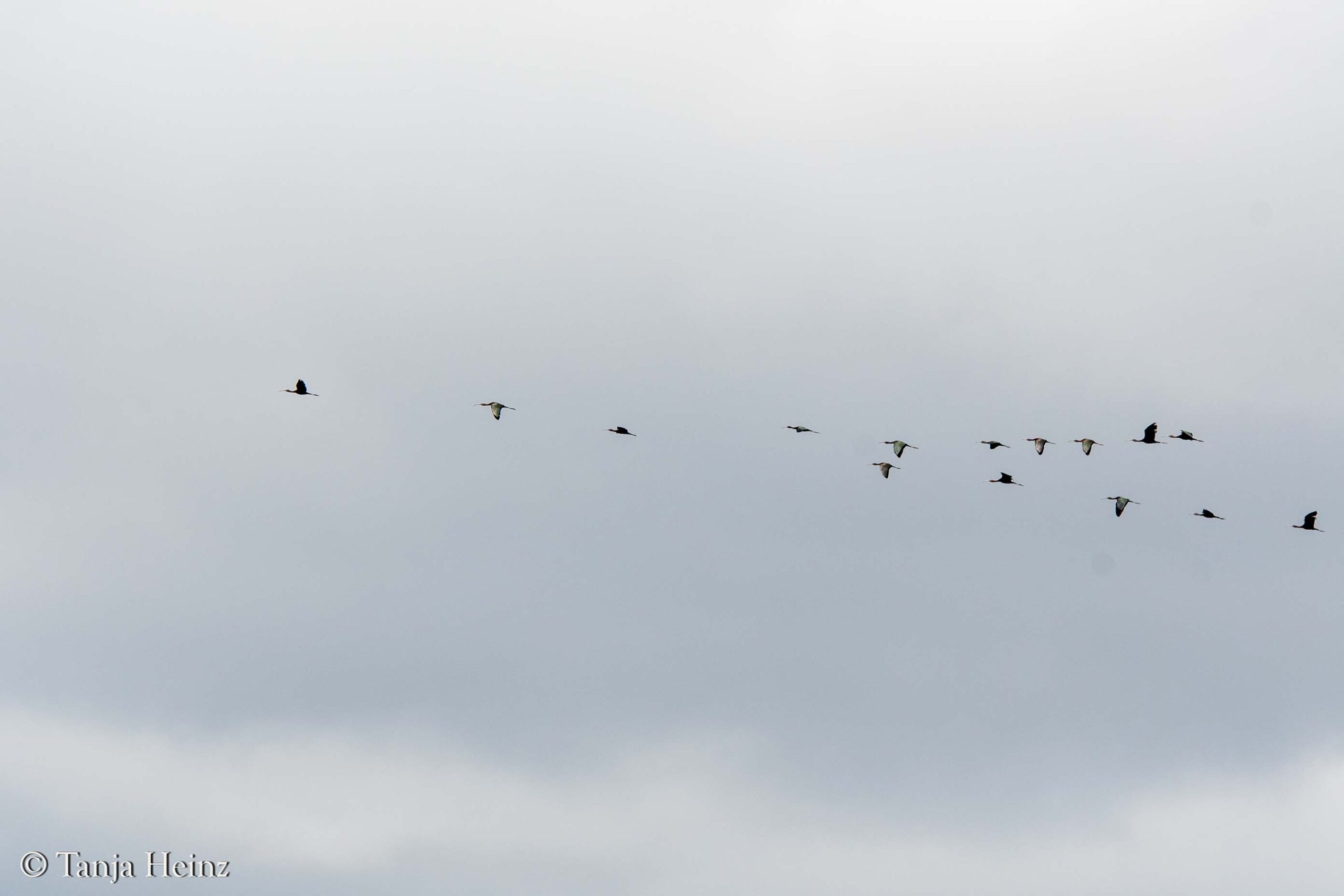
Information: If you want to know more about research methods at the Tethys Institute, please visit their website. You can also find information on ongoing projects and ways to get involved in marine conservation and citizen science initiatives.
Sanremo: Day 2
The next day, we were lucky enough to set out from the port once again. The researchers had already warned us that strong winds might keep us in port the following day, so I was determined to make the most of this second chance on the water. I felt genuinely excited and grateful that we could head out once more in search of dolphins — knowing that the weather could easily have put an end to our plans.
As we left the shore behind, the sea greeted us gently, and it didn’t take long before we spotted movement in the waves. Soon, a group of dolphins appeared, gracefully breaking through the surface. Once again, they were bottlenose dolphins, and watching them glide through the water felt just as magical as the first time.
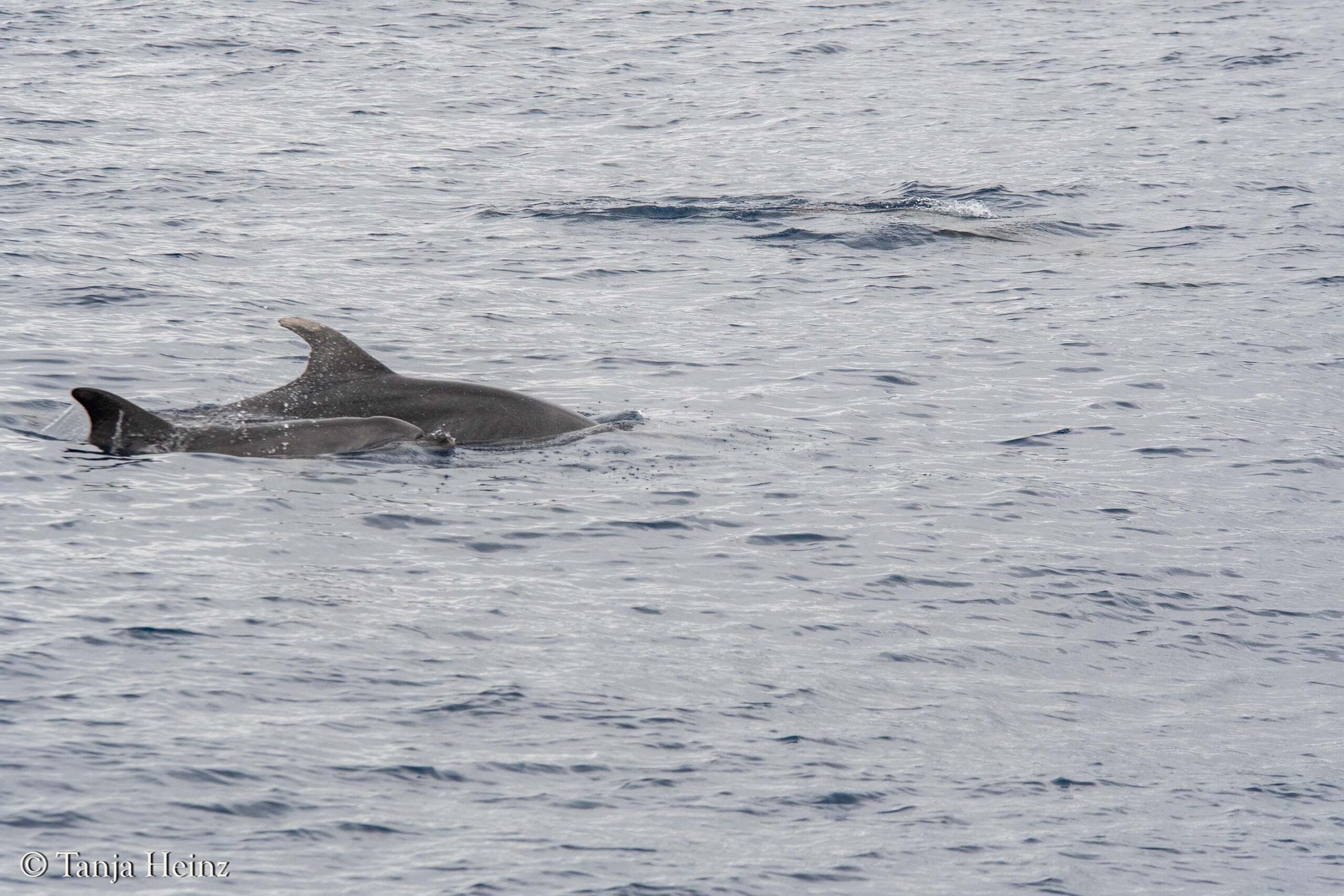

One of the dolphins had a striking white patch on its dorsal fin, while the others had grey fins that were far less distinctive — though some bore tiny markings that are hard to spot from a moving boat, especially for untrained eyes like mine. Out on the water, the most important task is to gather as much data and as many photos as possible. The real close-up work happens later, back at the desk.
Then, suddenly, a dolphin with a truly distinctive dorsal fin surfaced, instantly catching everyone’s attention.
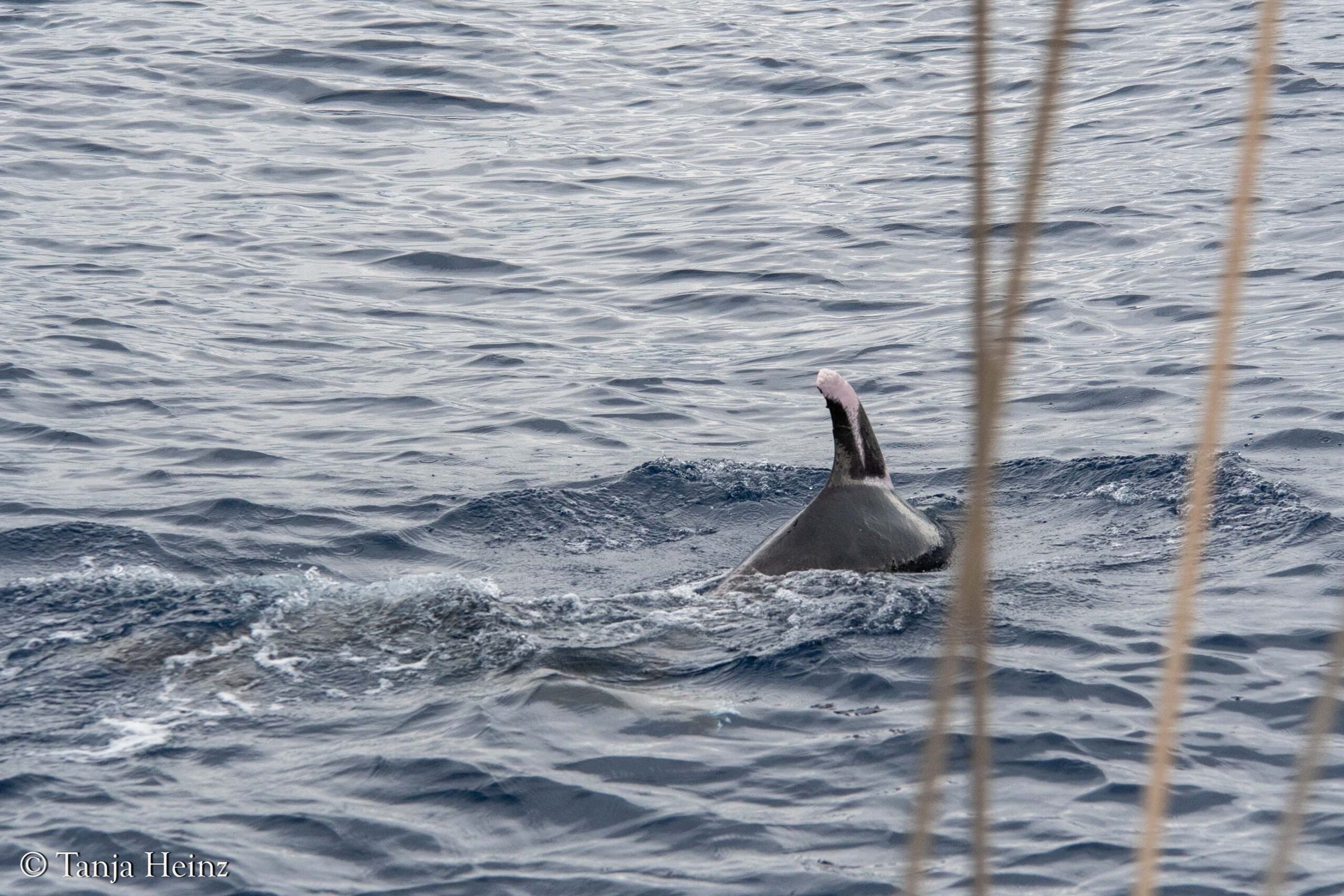
This dolphin wasn’t alone. Almost at the same moment, another one surfaced nearby. To my eyes, this dolphin also had a distinctive dorsal fin — not as striking as the first one, since it lacked the large rose-coloured patches, but it showed some fine lines near the tip of the fin that made it stand out in its own subtle way.
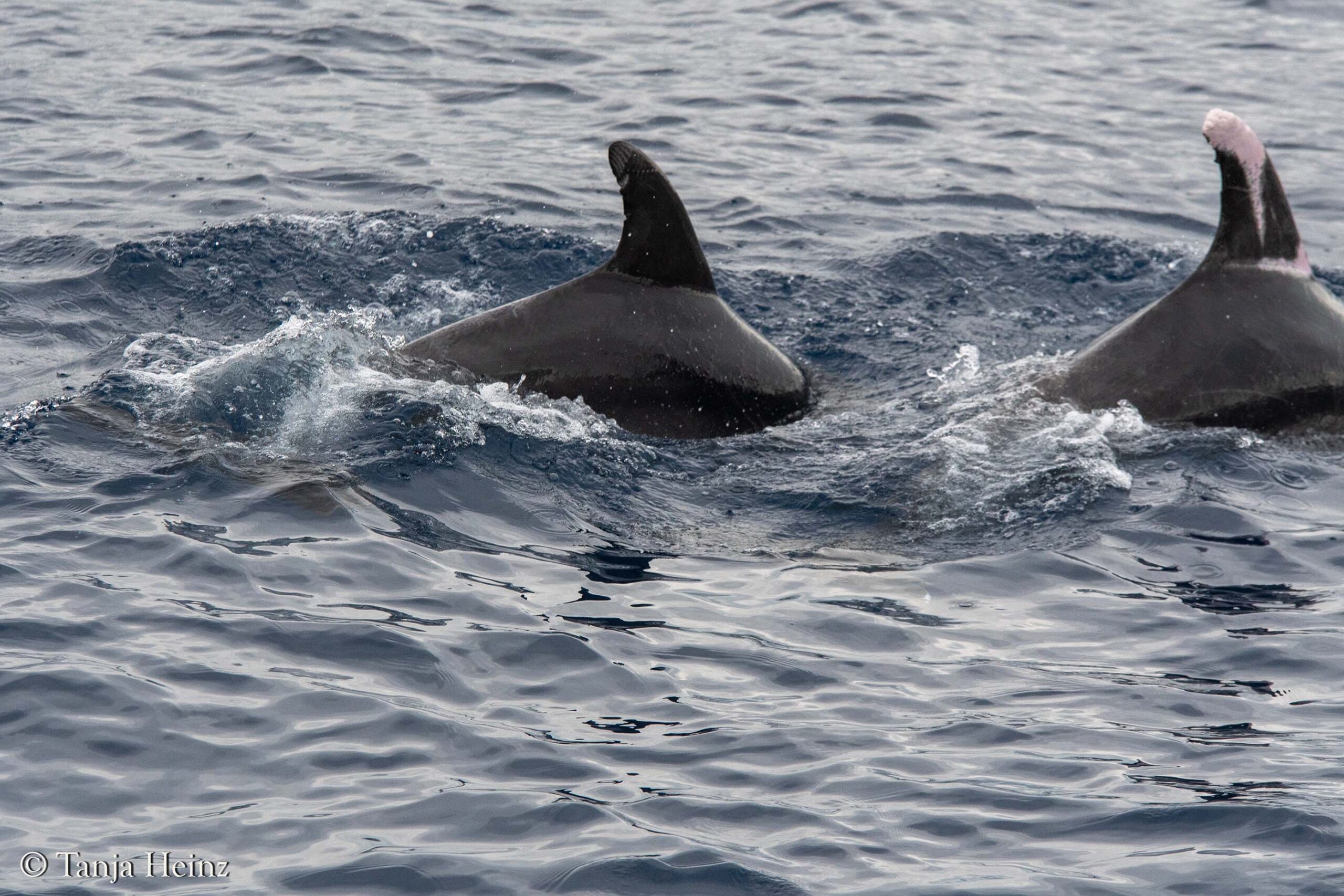
But the second dolphin wasn’t quite as “interesting” in that moment. To be honest, I only noticed the fine lines on its dorsal fin later, when I was looking through my photographs.
At the time, all of our attention was focused on the dolphin with the rose-colored patches on its fin. I was asked to help photograph it — and of course, I did. I tried my best to capture it as clearly as possible.
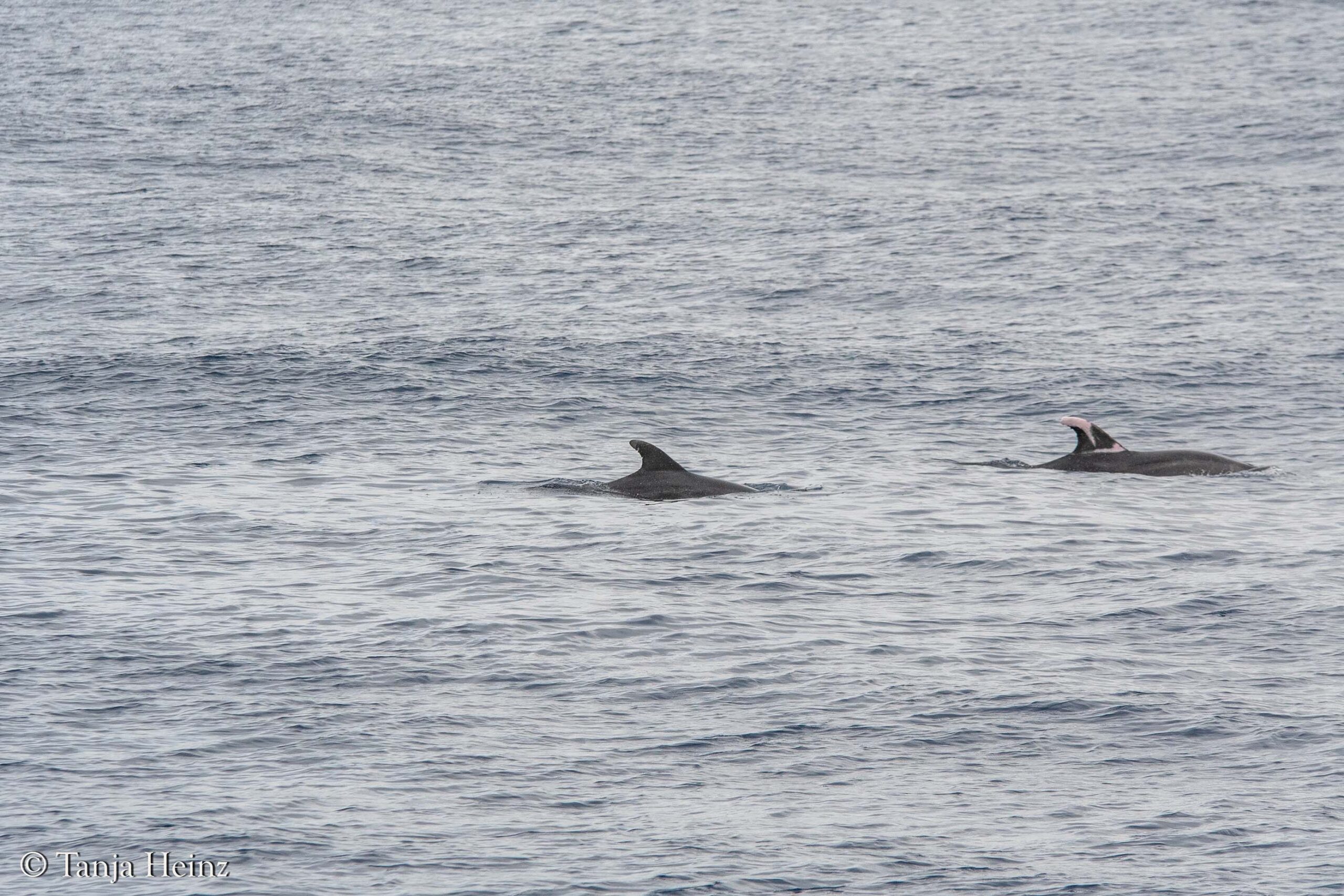
I saw another dolphin with fine lines on its fin. However, when comparing the shapes, it's quite clear that this dolphin's fin differed noticeably from the one swimming alongside the dolphin with the rose-colored fin.

Once again, I only noticed the fine lines later at my desk — not while I was out on the boat. In the field, my attention was focused on spotting the dolphin with the striking, rose-coloured dorsal fin. Eventually, I saw this individual swimming alongside the dolphin with the whitish patch on its fin. A moment later, a third dolphin appeared at the surface of the water.

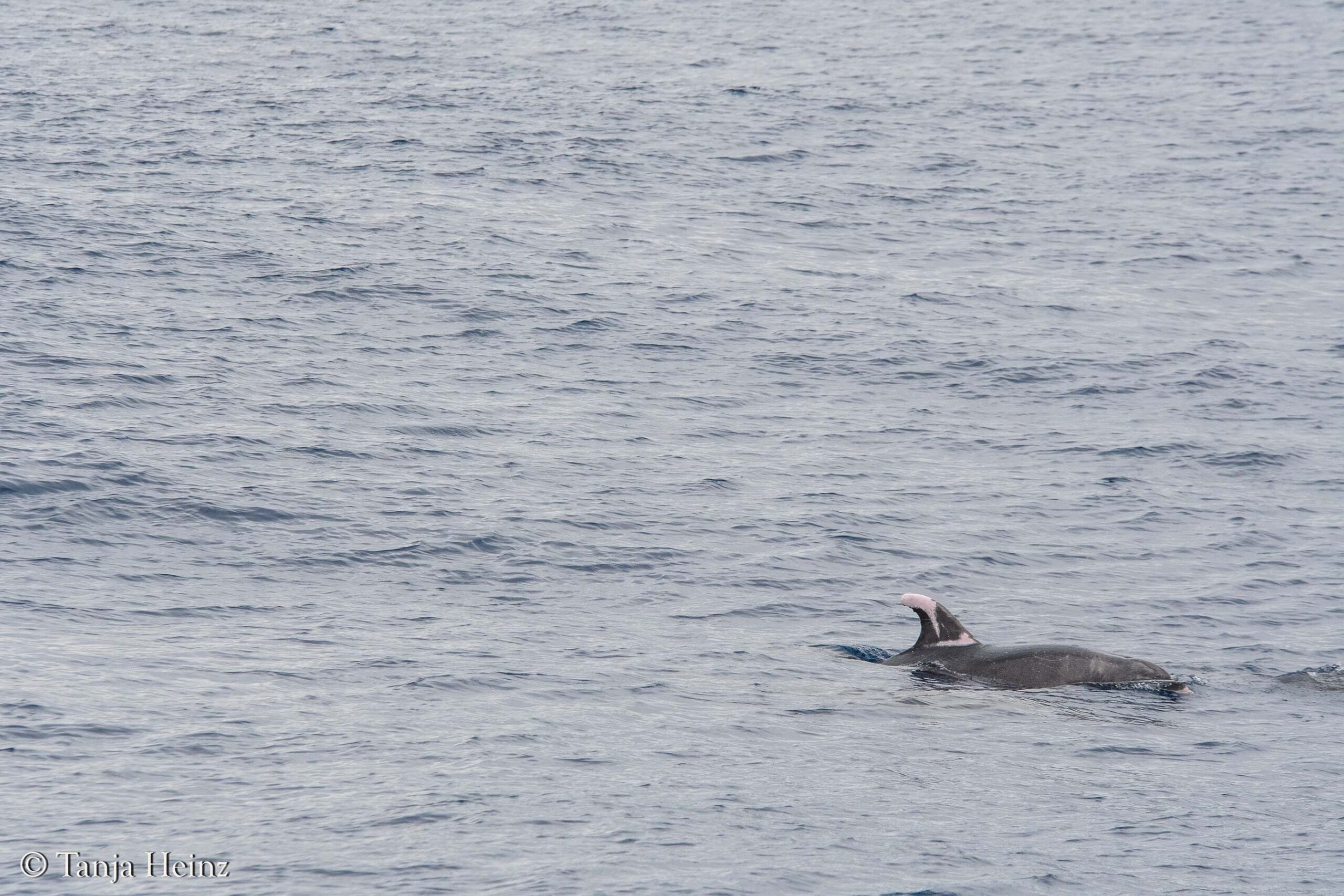
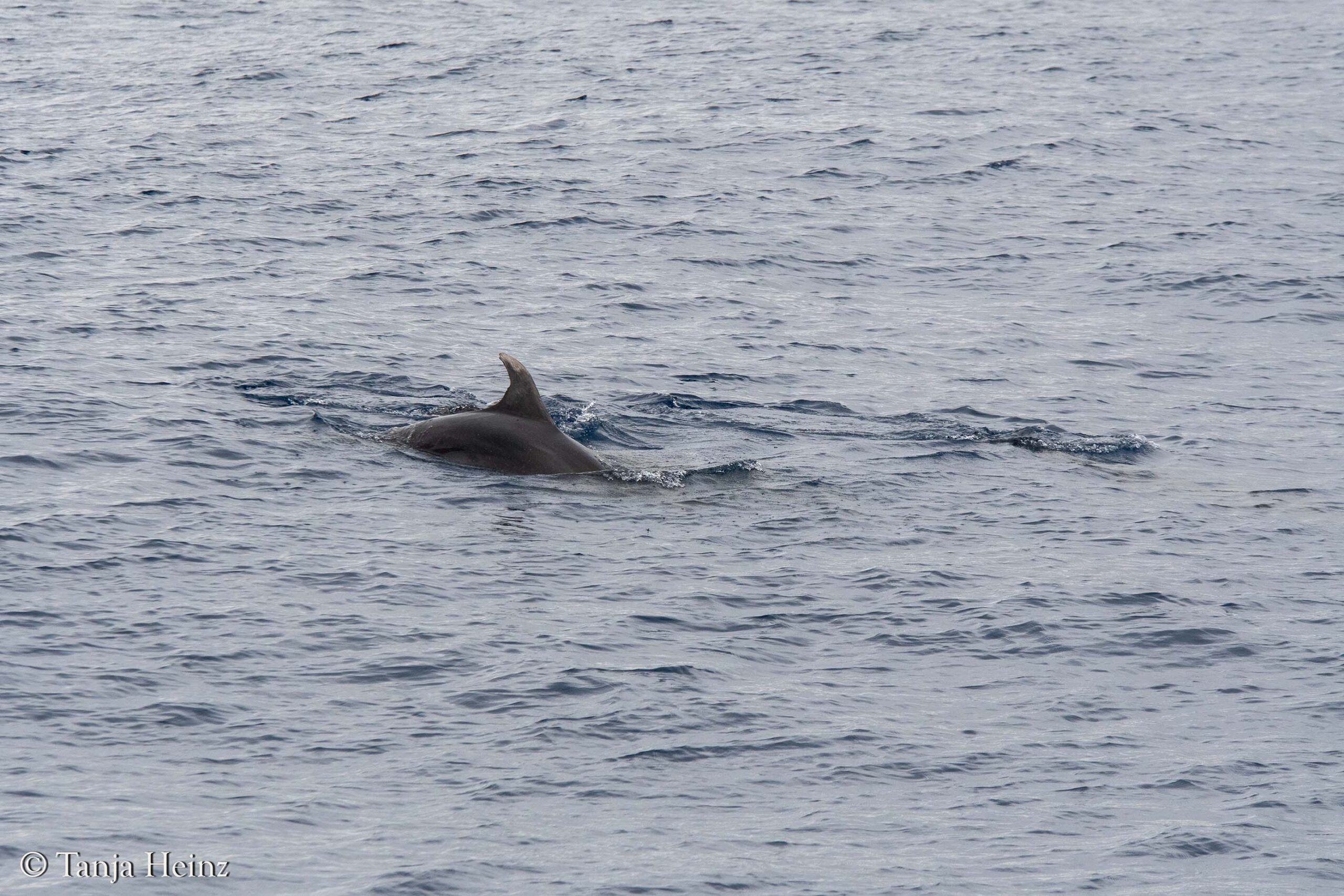
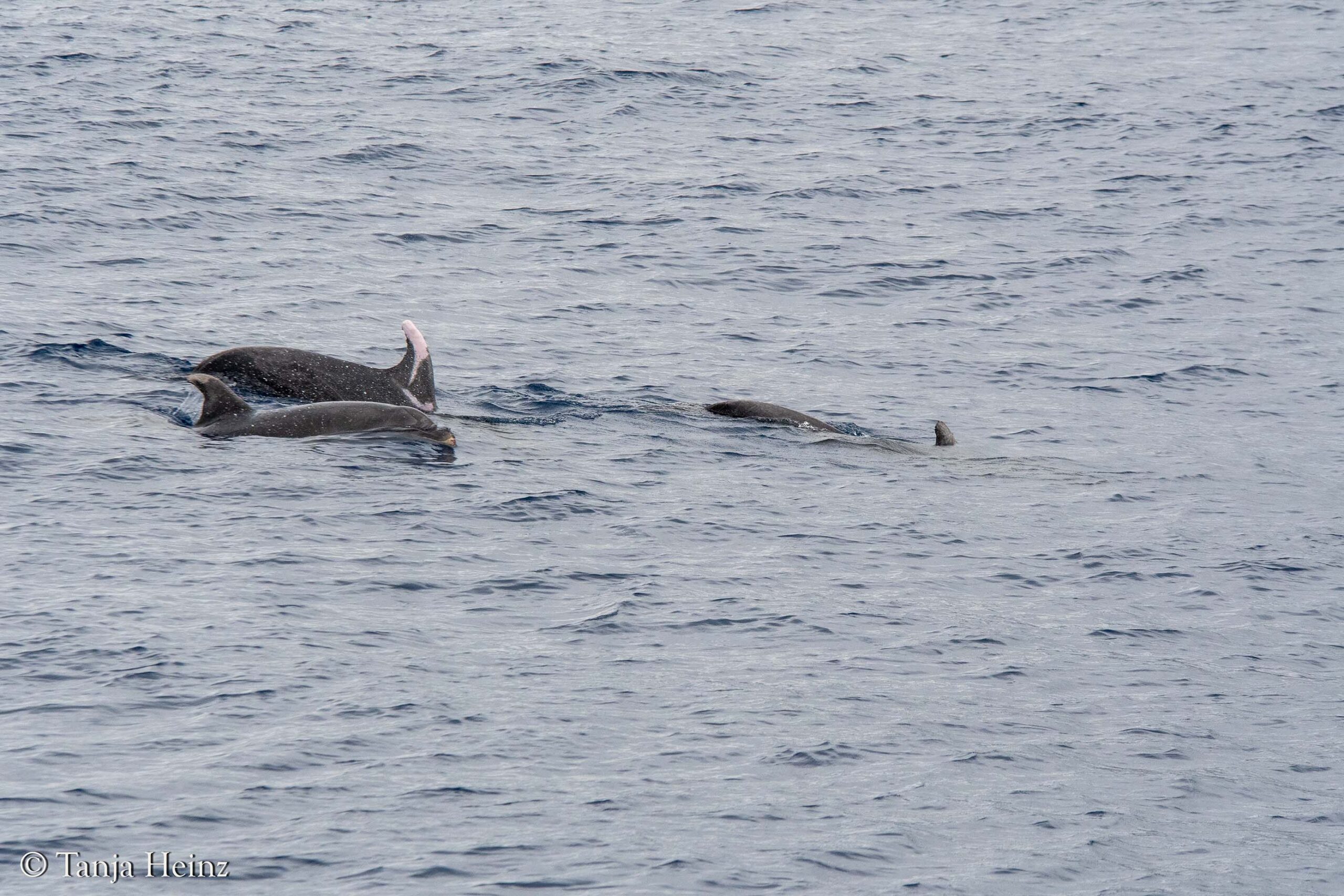
I was also trying to photograph the dolphin from the other side — not an easy task at all. It depends heavily on the boat's position and the direction in which the dolphins are moving. Fortunately, the researcher on board communicated closely with the skipper, which really helped. In the end, I managed to capture an image of the dolphin with the distinctive dorsal fin from the other side, and I also got a shot of the dorsal fin of the dolphin with the whitish patch. However, I’m not sure whether any of these photos are actually useful for research, given the angle. But well — I did my best.


Information: On the boat, I used my Nikon D500 camera paired with a 70–200mm f/2.8 lens — a good choice for the conditions. I never considered using my other lens with a focal length of up to 600mm, as it would have been too heavy and the boat too unsteady to capture sharp images. The 70–200mm also gave me the flexibility I needed for photographing moving dolphins from a rocking boat.
Although I was focused on that particular dolphin, I didn’t want to lose sight of the others. I spotted one individual that also had quite a few markings on its dorsal fin.
It’s worth noting that these markings can change over time — a dorsal fin may gradually develop more nicks, scars, or other features. That’s why it’s so important to observe and photograph these dolphins regularly: to avoid mistakenly identifying a familiar dolphin with new markings as a completely new individual.
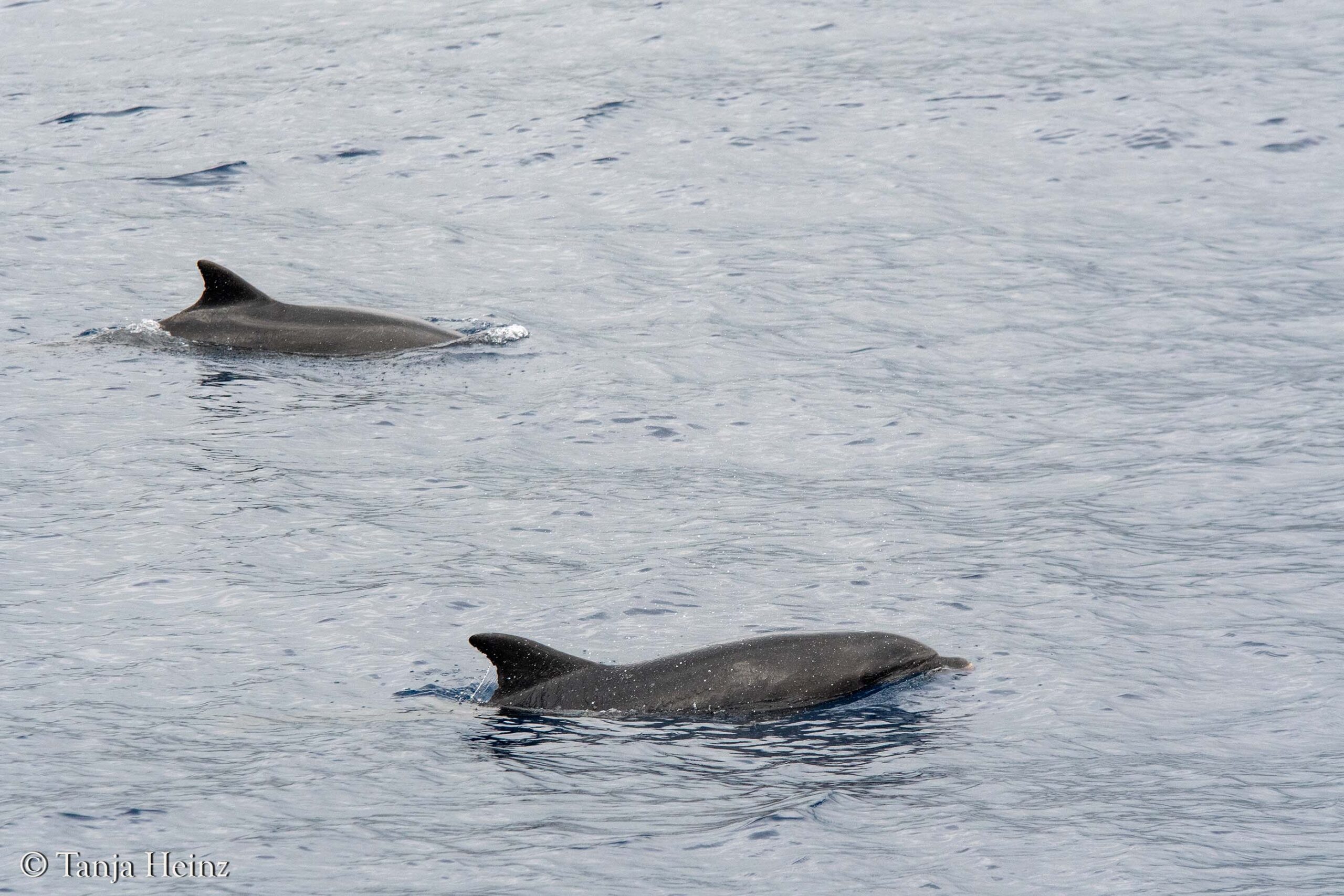
It was a slow-moving dolphin, and I was happy to get a clear view of its face. There's something special about making eye contact with a wild animal — even if just for a moment. It gave me the feeling of a quiet connection, a brief glimpse into its world.
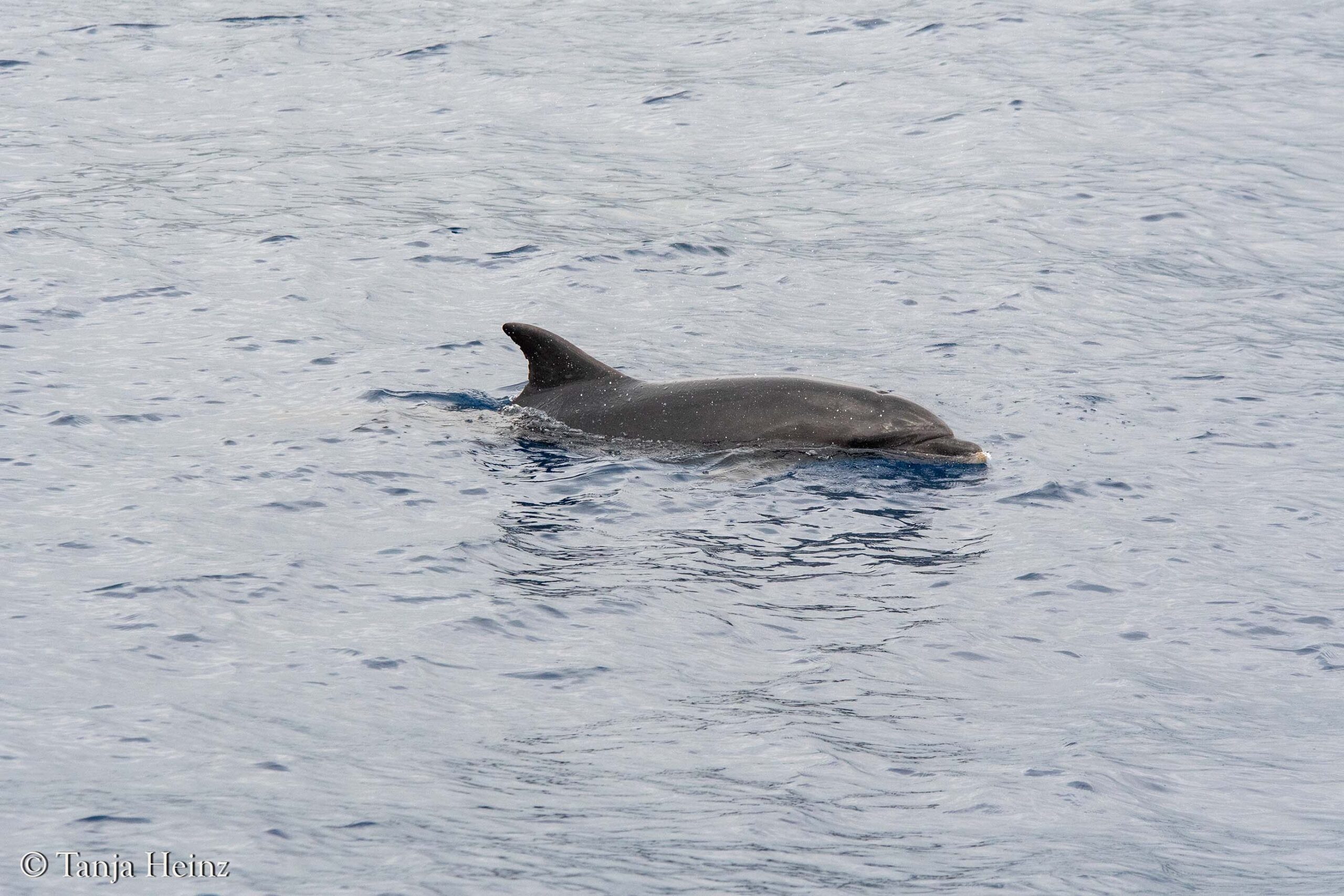
At first glance, studying dorsal fins might seem dull — but for researchers, it’s actually fascinating. These fins allow them to identify individual dolphins and recognize familiar ones over time. They can also estimate group sizes, track movement patterns, and gain valuable insights into how dolphins use their habitat. So, far from being boring, observing dorsal fins opens a window into the complex lives of these intelligent marine mammals.
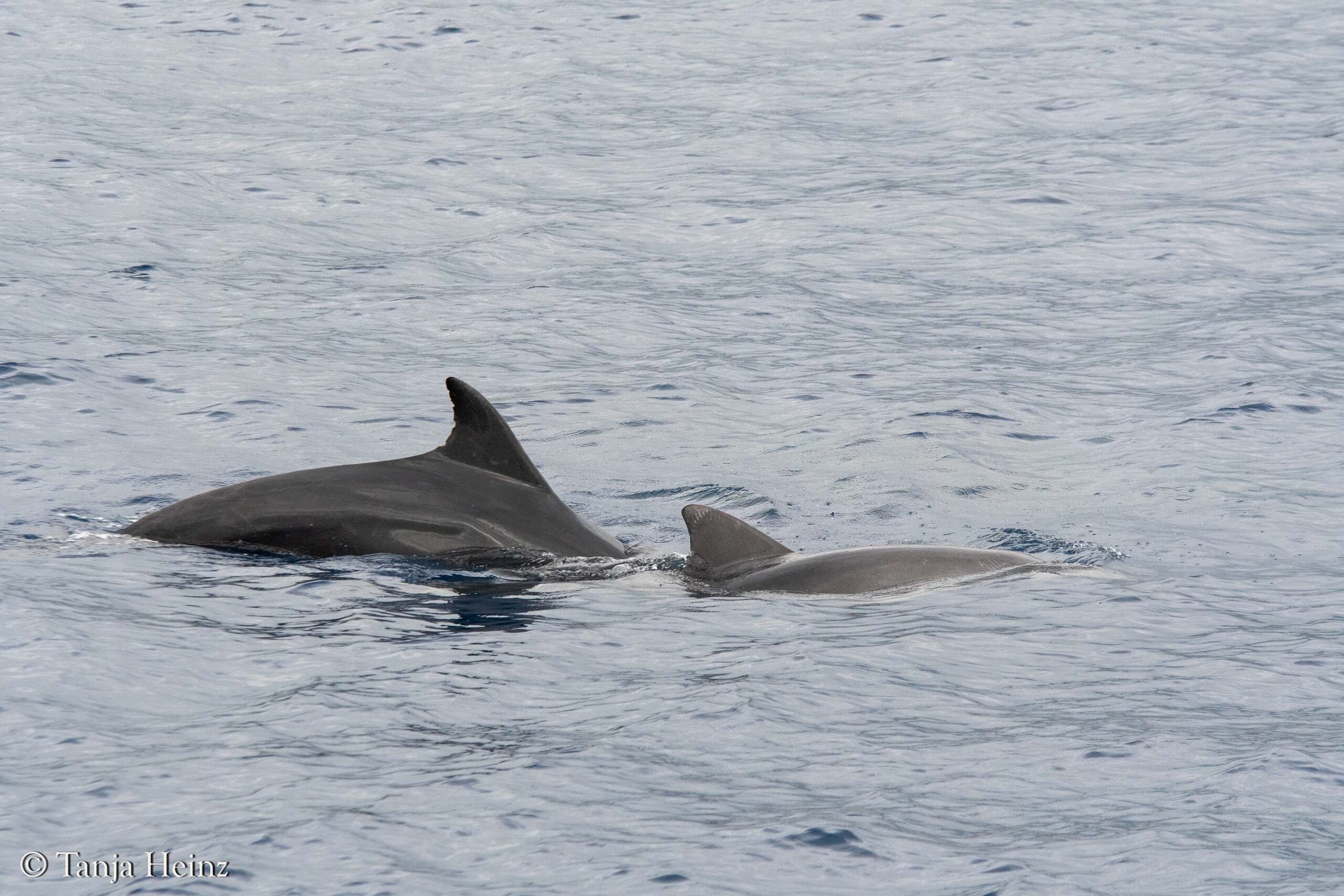
What seems to capture everyone’s attention, however, is when a young dolphin swims alongside its mother. And honestly, I found it just as thrilling — and deeply moving. In this case, the calf was already a bit older, no longer a newborn, but still clearly staying close to its mother. I was lucky enough to capture a few photographs of the pair swimming together in perfect sync. Moments like these are a beautiful reminder of the strong bonds within dolphin families — and of how special it is to witness them in the wild.
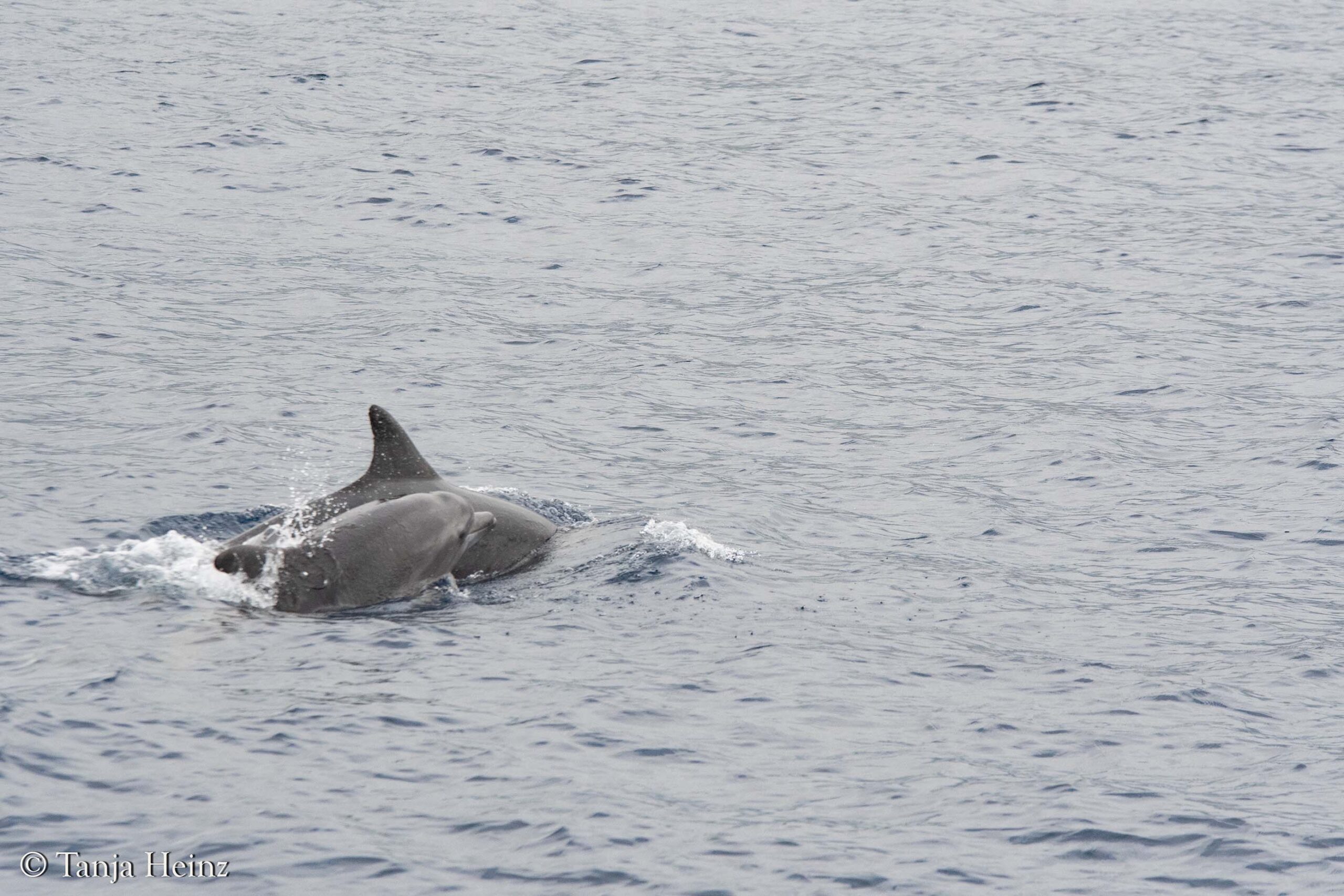
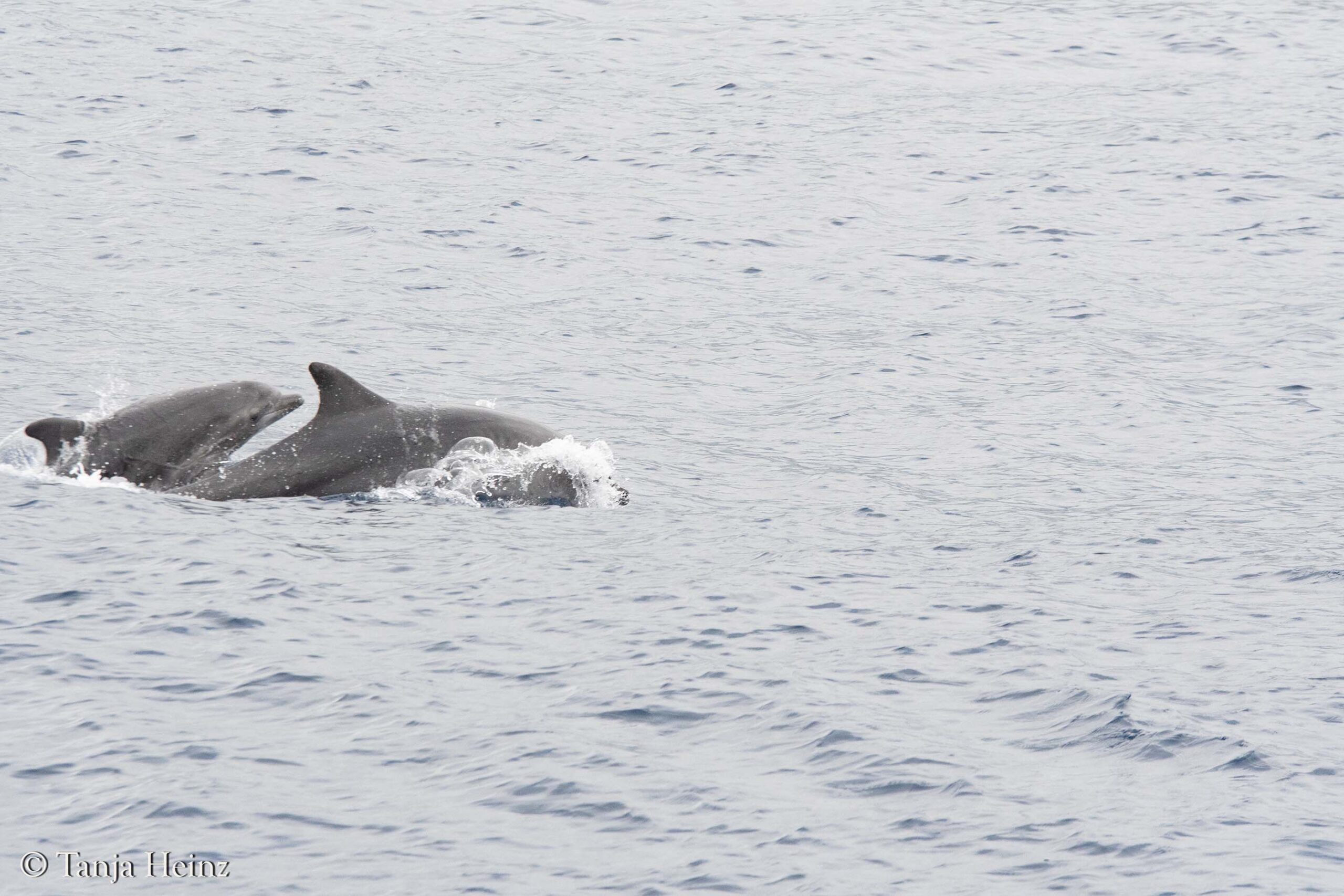
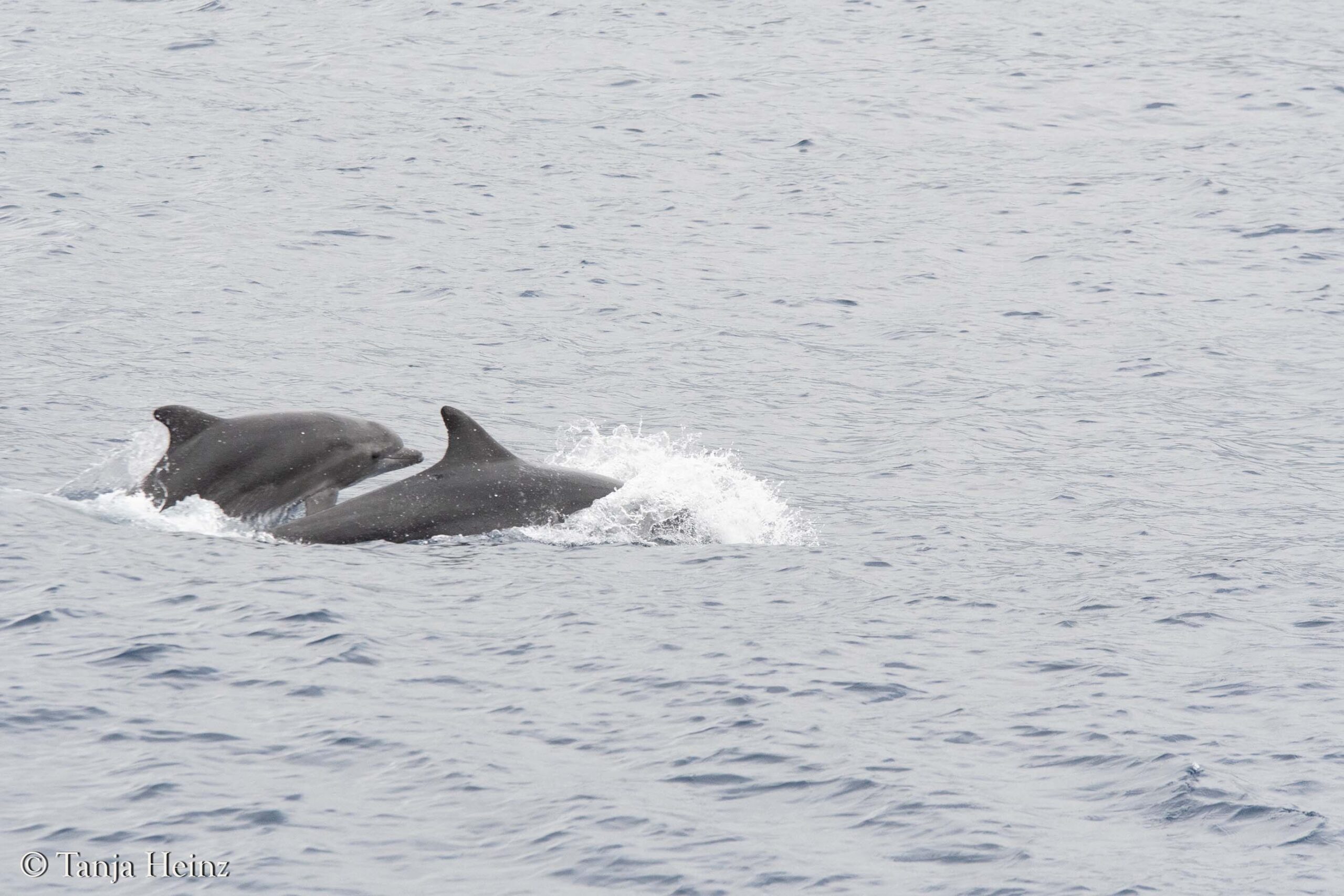
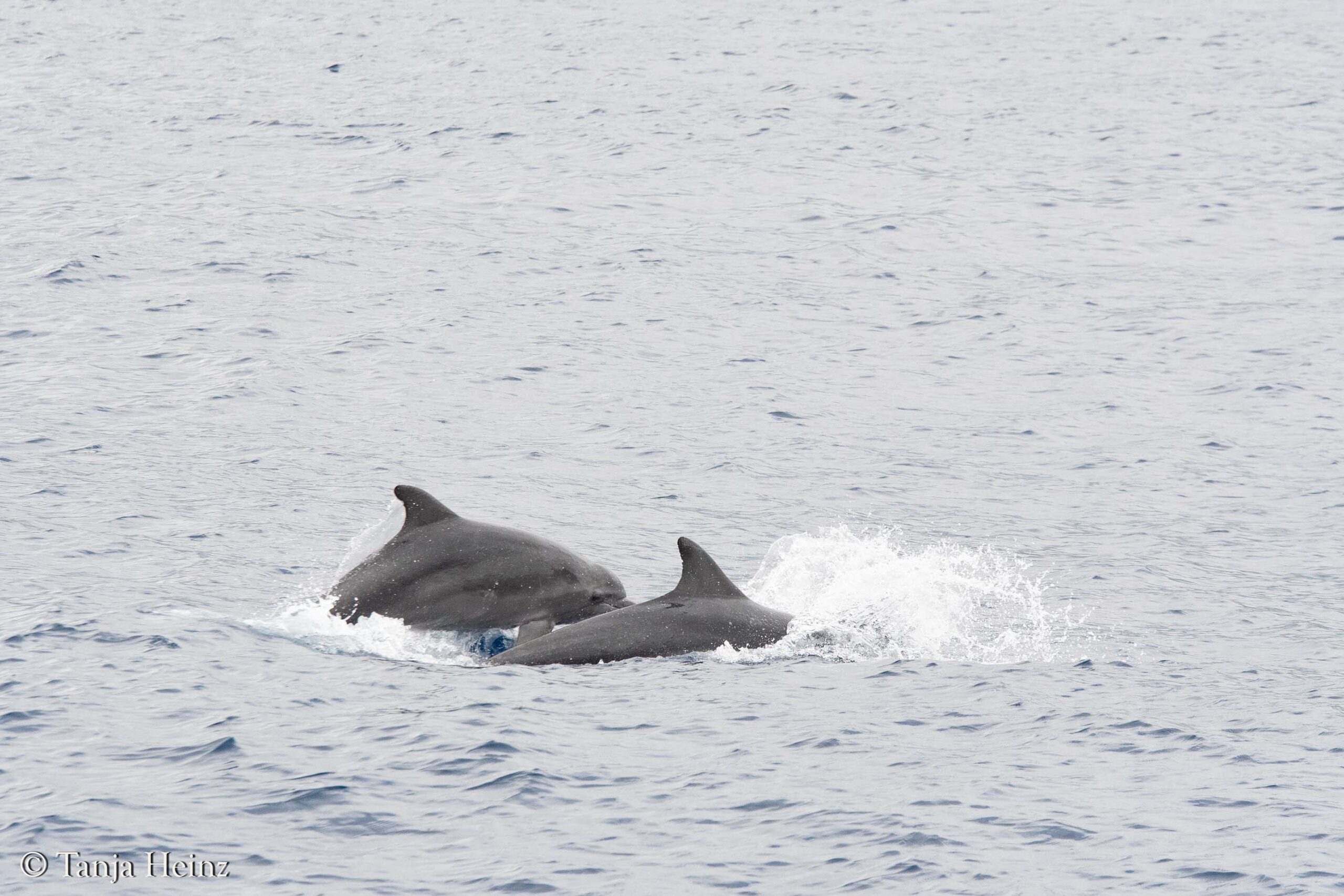
A study on bottlenose dolphins found that calves are typically weaned by around three years of age, although exceptions do occur — with one individual in the study being weaned as late as its fifth year. However, even after weaning, when the mother no longer lactates, a strong social bond between mother and calf often remains. These post-weaning associations can last anywhere from four to ten years, meaning the calf continues to stay within the maternal group. It is important to note, however, that these observations are based on a relatively small sample of just nine calves.
Information: If you’re interested in exploring this topic further, one relevant study was published in Aquatic Biology and can be found here. Similar findings have been reported for bottlenose dolphins in Sarasota Bay, Florida. For a more extensive long-term study based on a larger sample size, you can refer to the article published in Frontiers in Marine Science.
Towards the end of our bottlenose dolphin observation, I spotted a few more dolphins swimming slowly alongside the boat. I was even fortunate enough to capture photographs showing the faces of two of these dolphins.
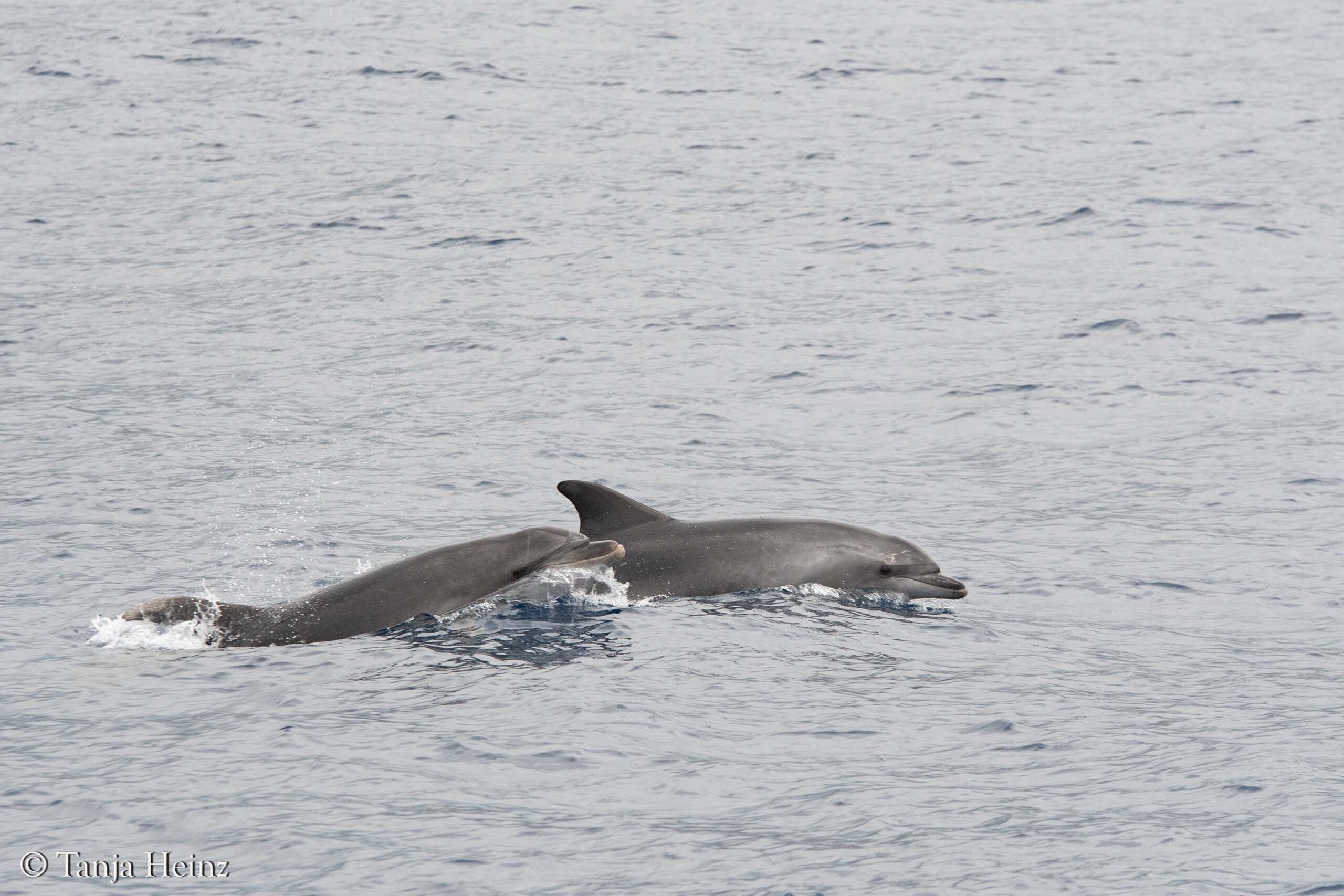
Thanks to my fast camera, just a millisecond later I captured a photo that showed the face of the second dolphin very clearly. By the way, this was the dolphin with the distinctive white patches on its dorsal fin. It was truly amazing—not only to see the dorsal fins, which are often the main focus, but now to get a clear glimpse of the dolphin’s face, revealing more of its character and expression. Moments like these make the experience unforgettable and deepen the connection to these incredible animals.
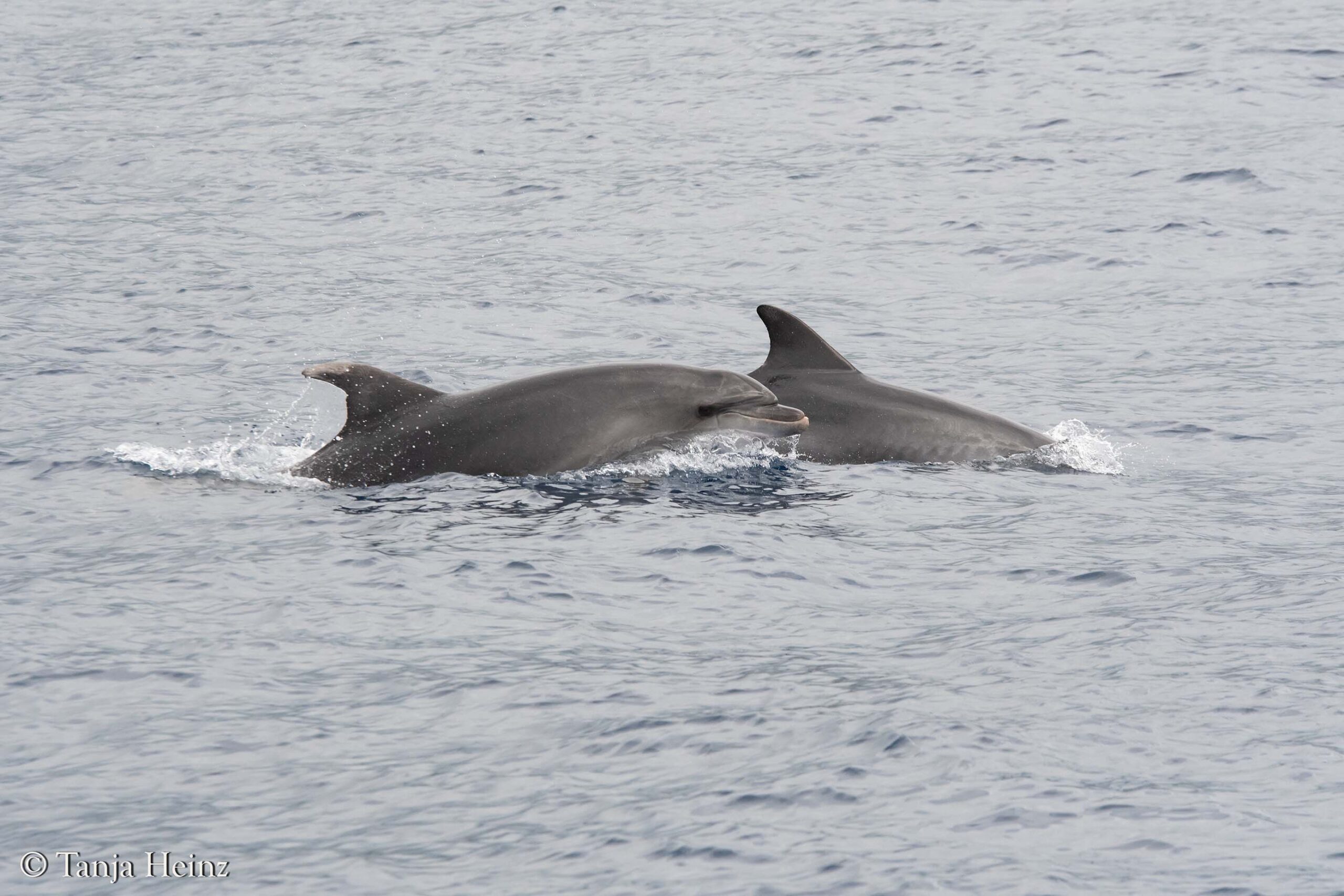
After our morning observations, the skipper headed back to the port. It was still uncertain whether we’d be able to go out again — the wind had picked up noticeably. So, we returned to shore and had lunch while we waited.
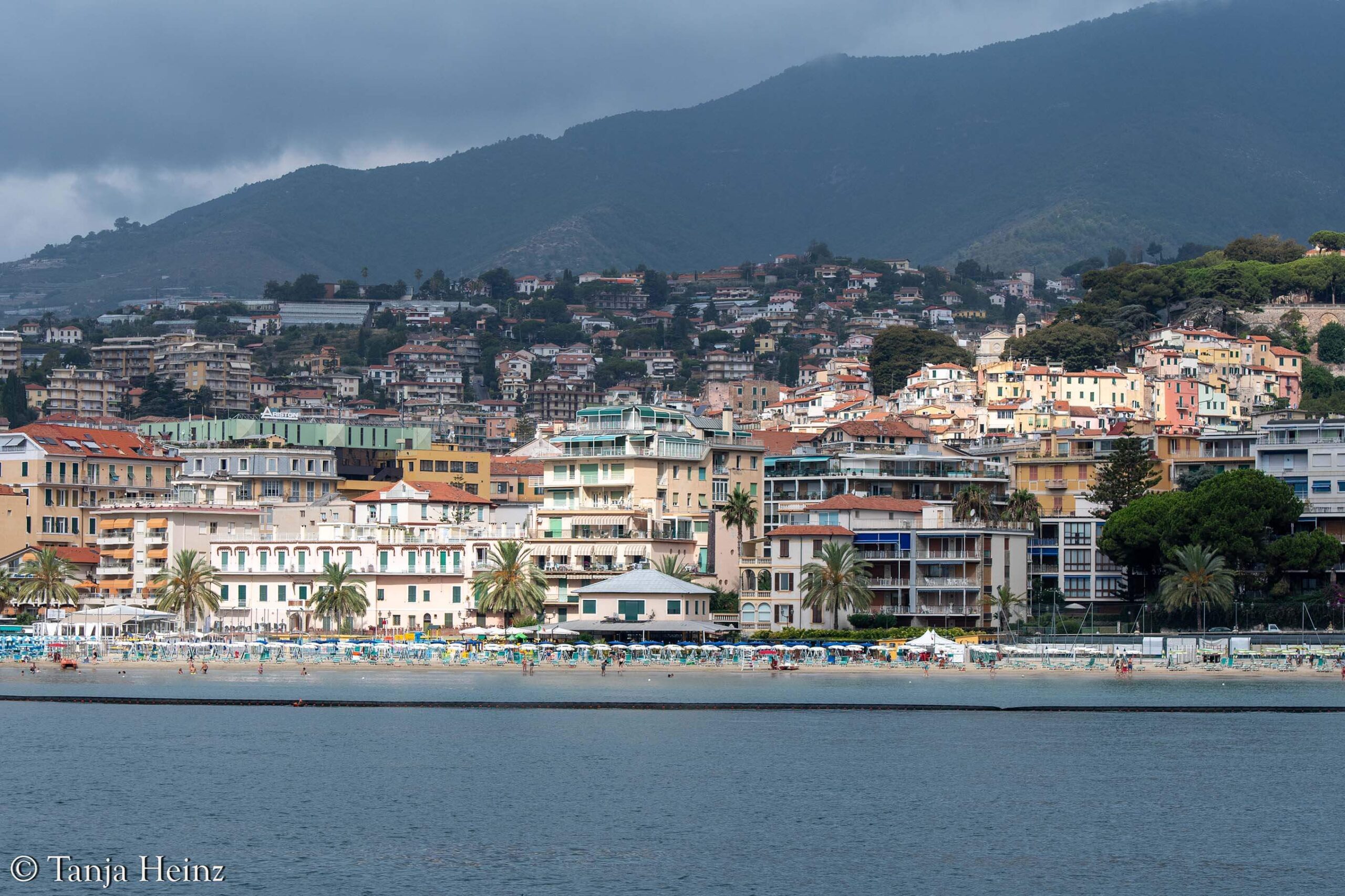
I was really hoping for another opportunity to head back out to sea, especially since we’d already been told that going out the next day would most likely not be possible due to the weather.
Fortunately, the researcher decided to give it a try in the afternoon. So, after lunch, we got ready again for our afternoon — or possibly evening — observation. I was genuinely happy. Even more so when the clouds began to clear, revealing the sea in its full, beautiful blue.
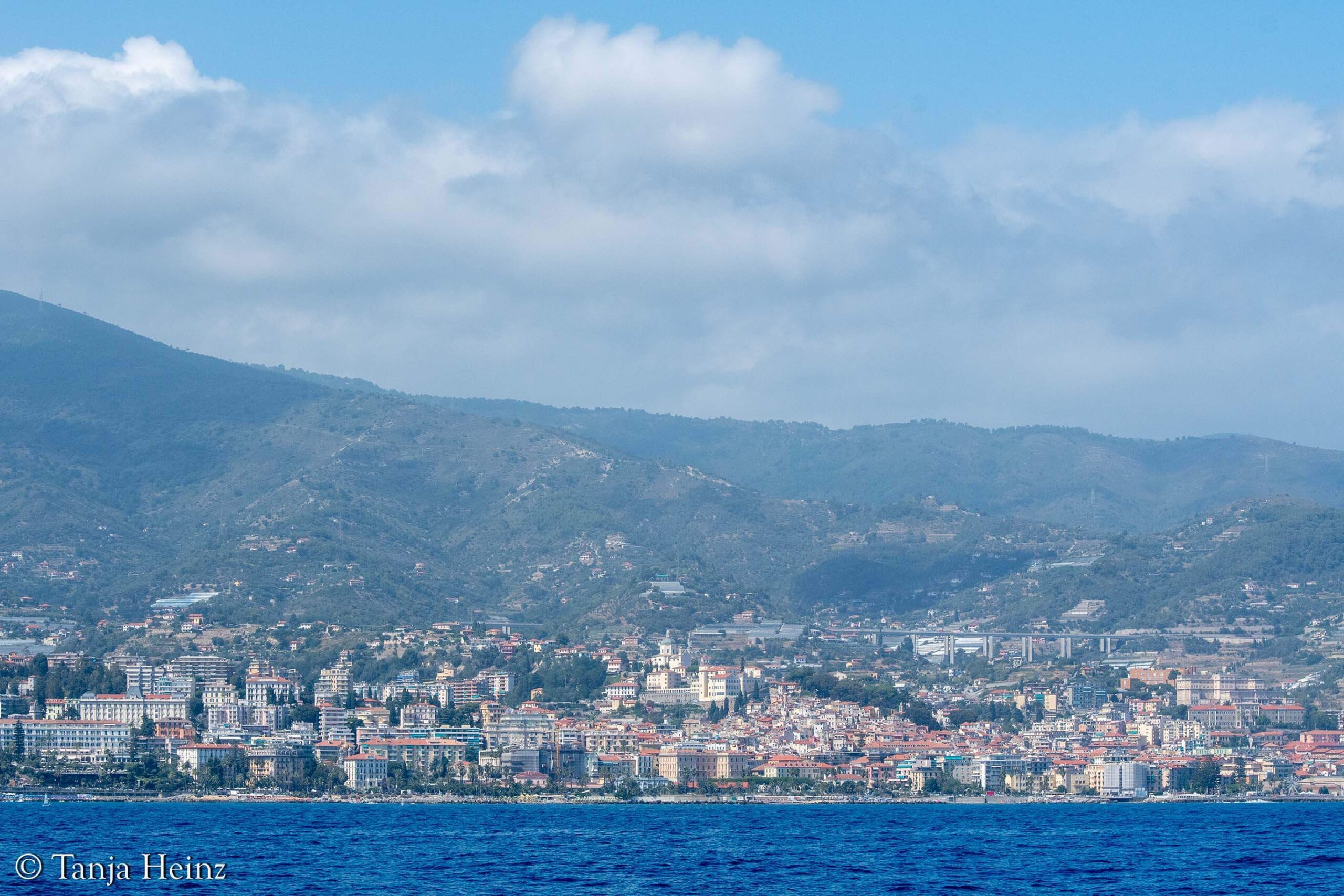
As we headed back out to sea, I was secretly hoping to spot a sperm whale. The researchers from the Tethys Institute use a special acoustic device to detect them underwater. Unfortunately, there were no vocalizations — nothing to indicate the presence of a sperm whale. Normally, as soon as a sound is picked up, the boat would change course and head directly toward it.
But with no sounds detected, all we could do was continue searching, slowly moving across the open water.
Then suddenly, a sound came through the device — not a sperm whale, but dolphins!
The boat quickly changed direction, following the signal.
Could it be bottlenose dolphins again?
No — this time, it was a group of striped dolphins that appeared at the surface.
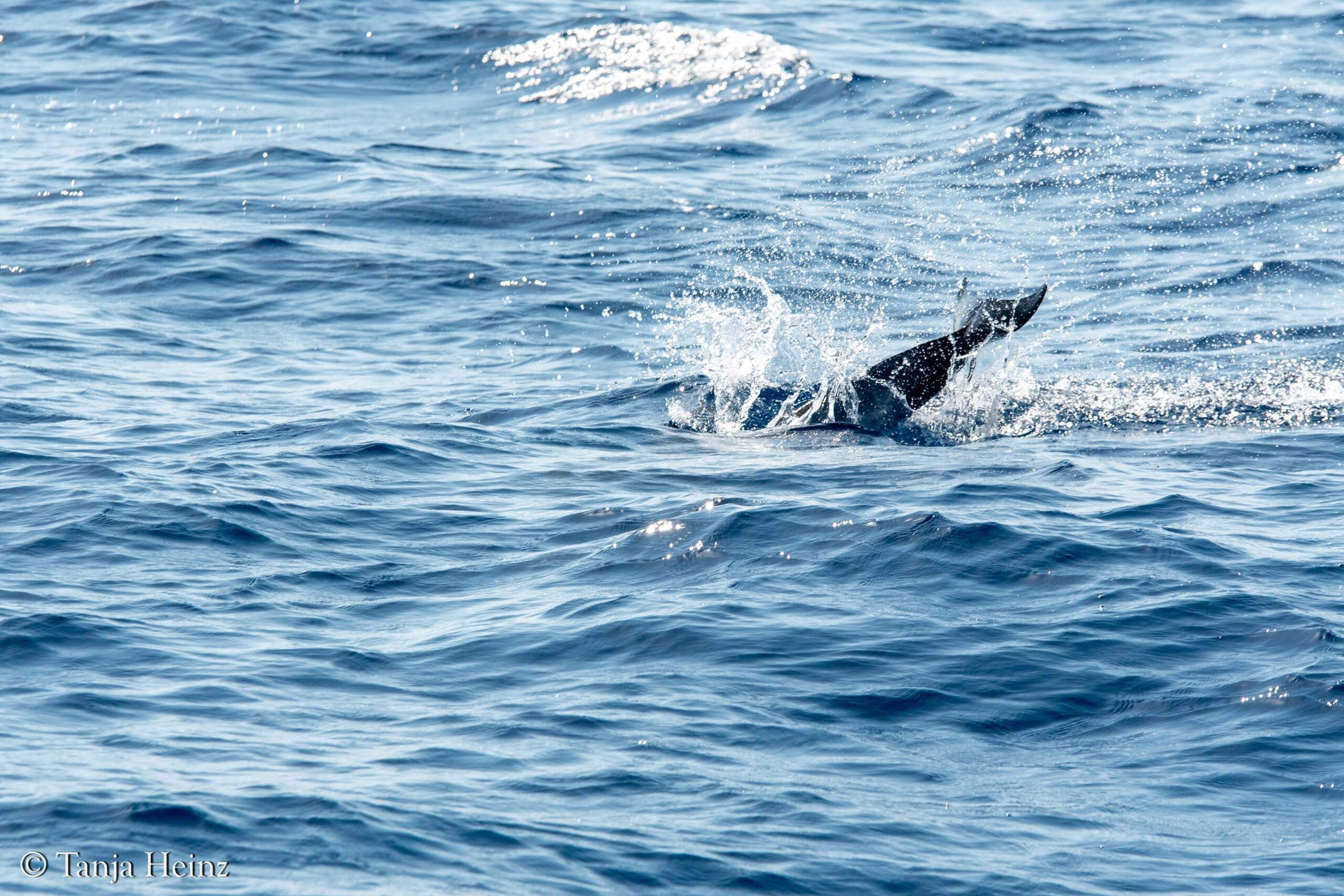
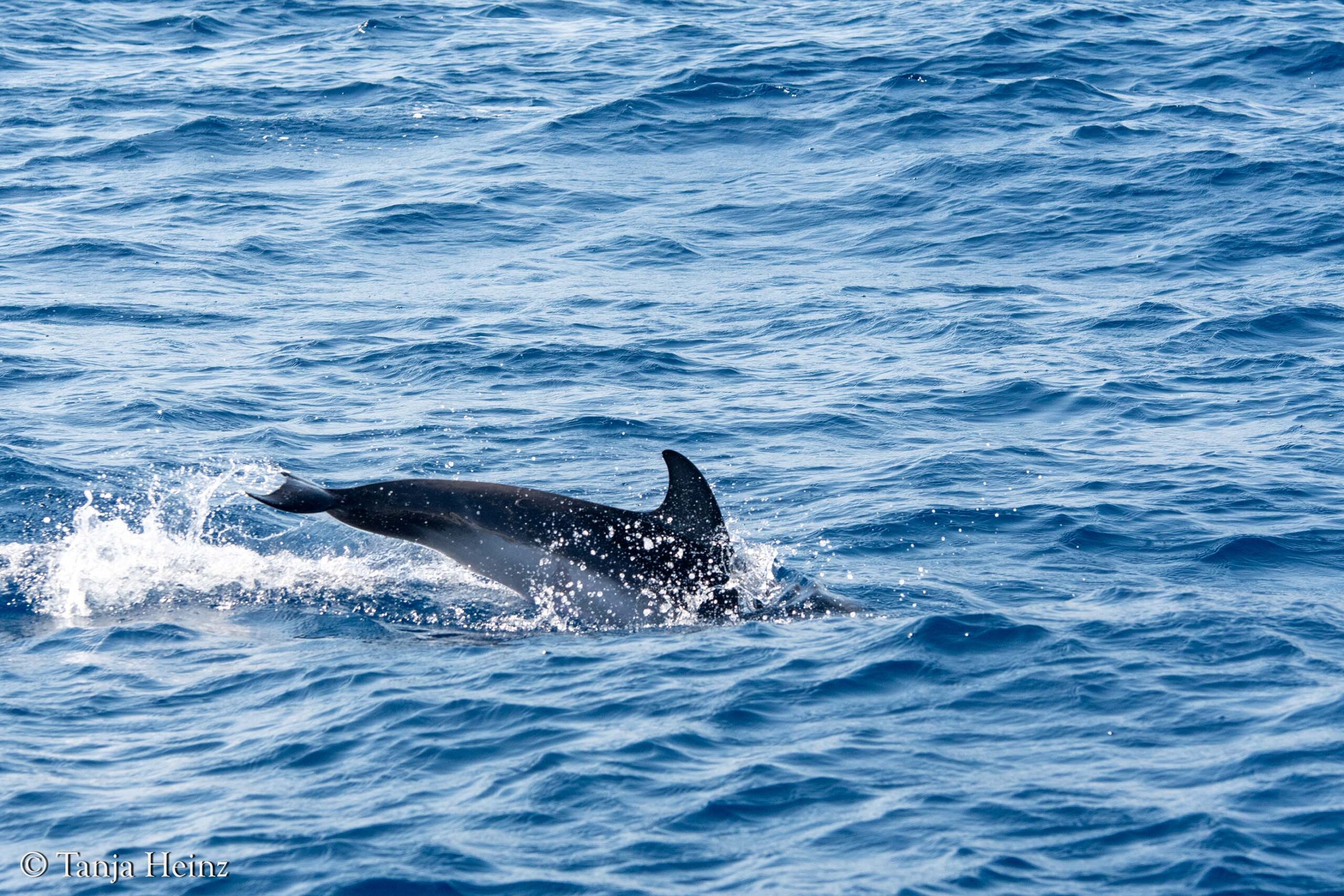
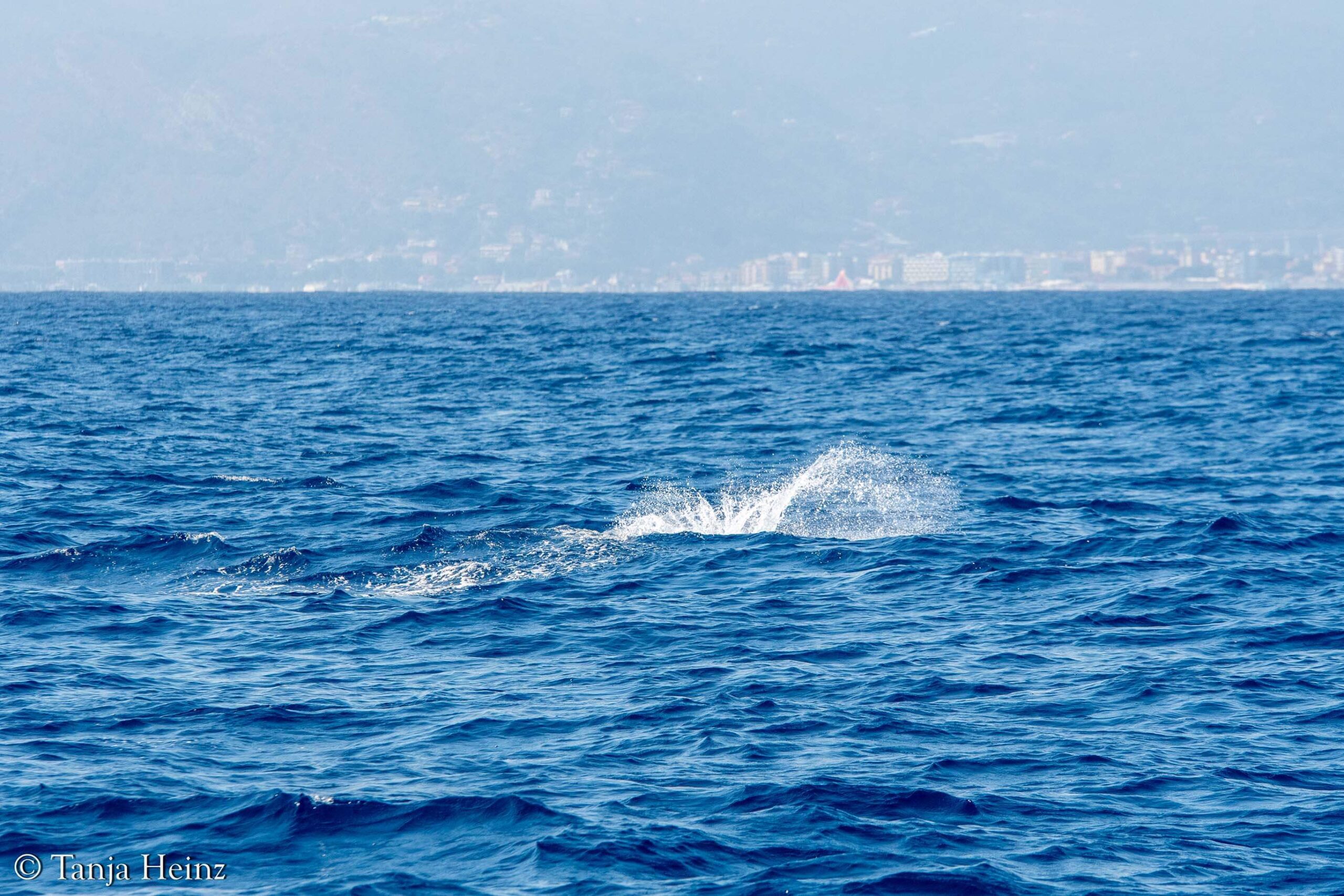
At first, there appeared to be only a few dolphins, and I was only able to capture glimpses — a tail here, the curve of a back there, or often just a splash. They were moving incredibly fast. But soon it became clear that the group was much larger.
Striped dolphins are known to be highly social animals. They typically travel in groups of 20 to 50 individuals, though sometimes in the hundreds (see Whales, Dolphins, and Seals – A Field Guide to the Marine Mammals of the World).
When so many dolphins are moving that quickly, photo-identification seems almost impossible. Still, I did my best to capture at least a few usable images.
At one moment, I managed to capture the face of a dolphin — though part of the ship’s rail ended up in the frame as well.
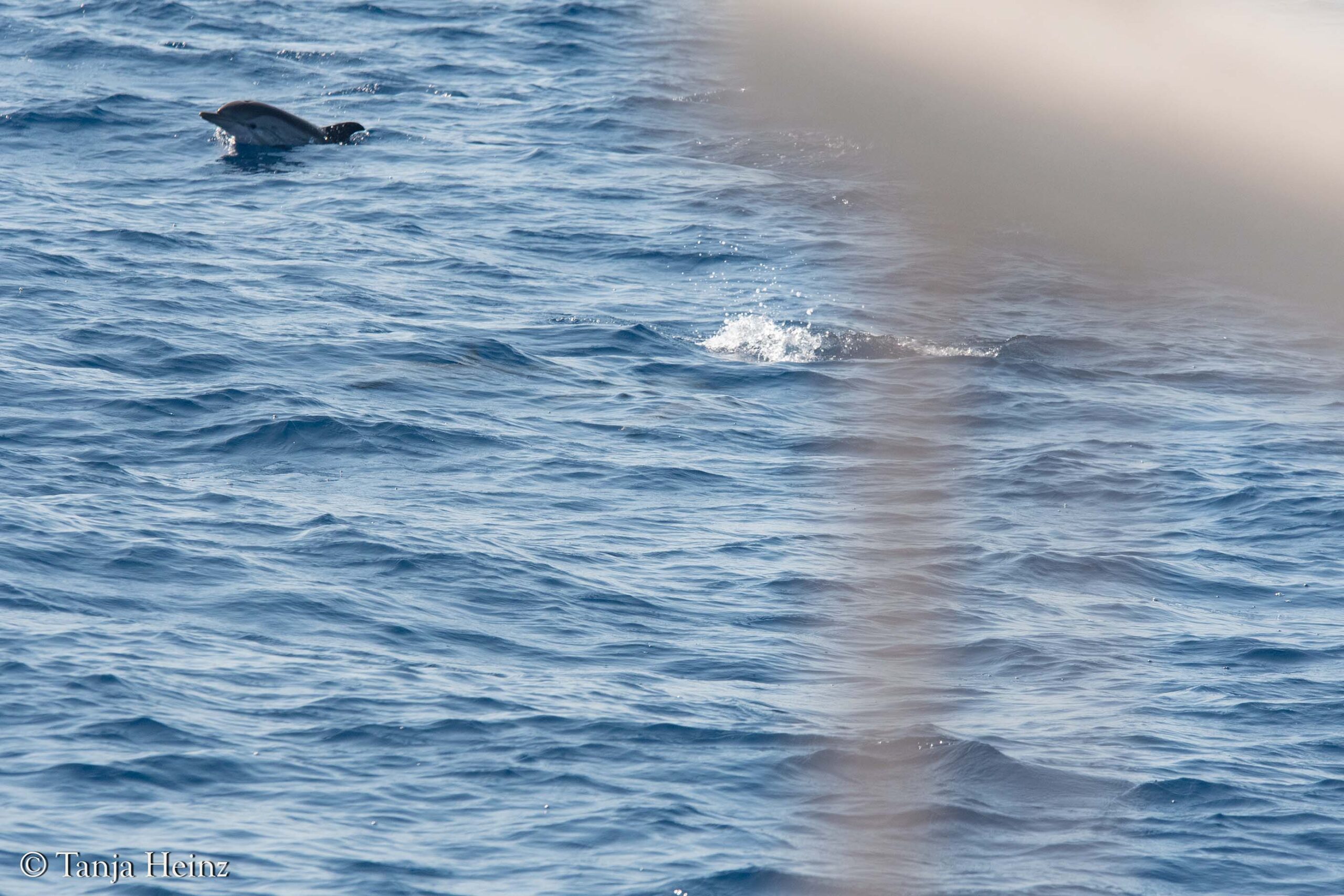
The dolphins were incredibly playful — I watched them leaping out of the water with such energy and grace. It was truly beautiful to observe. Some spun mid-air, others dove back in with barely a splash. There was a sense of joy in their movements, as if they were simply enjoying the moment. Watching them like this, so free and full of life, was one of the most moving experiences of the day.

Dolphins were swimming all around the boat, sometimes so close I could almost feel their presence. I tracked them with my camera, waiting for the perfect moment — hoping one of them would lift its head just enough for me to catch a glimpse of its face through the lens.
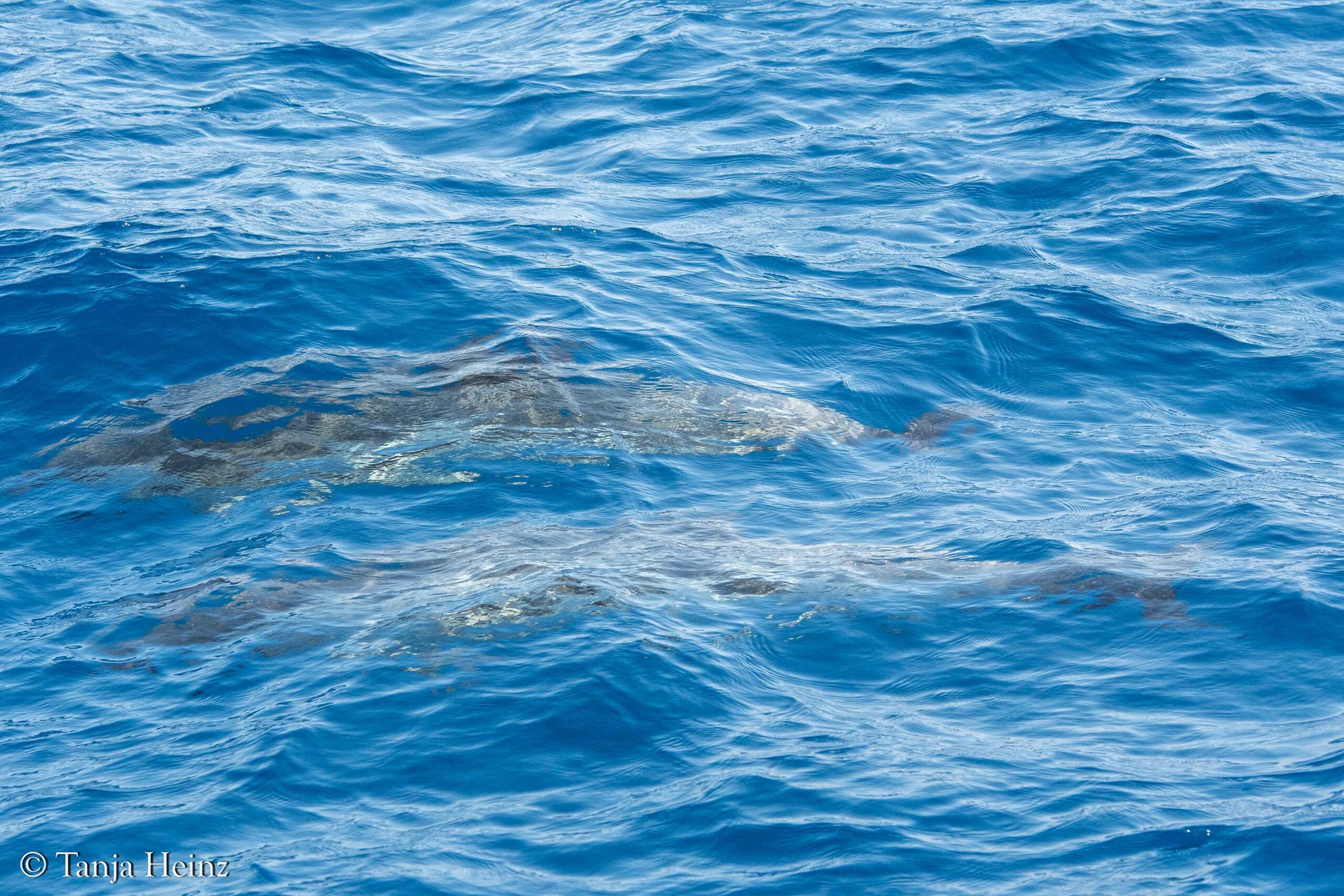
But most of the time, I was just a little too slow — and ended up capturing only the back half of the dolphin.
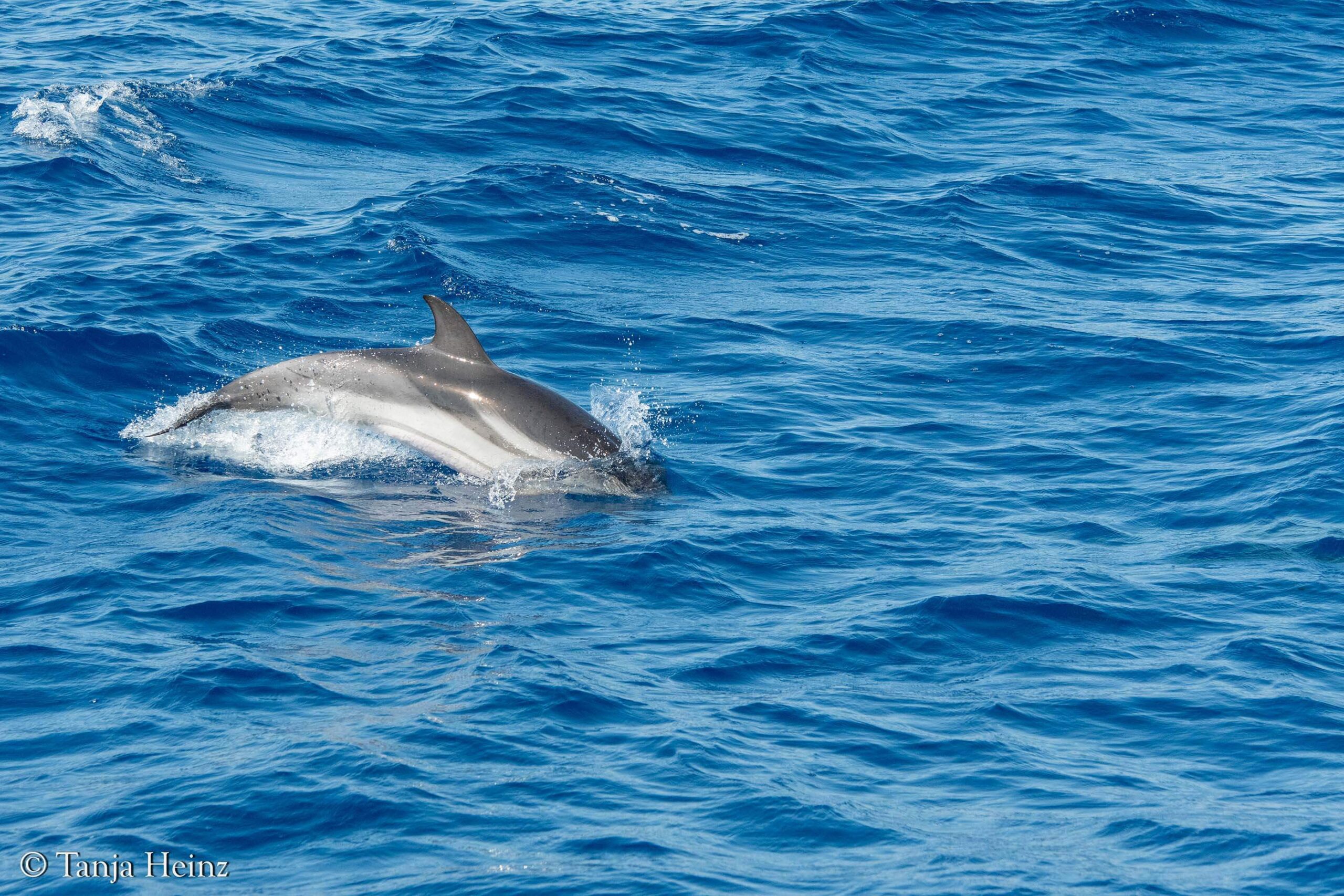
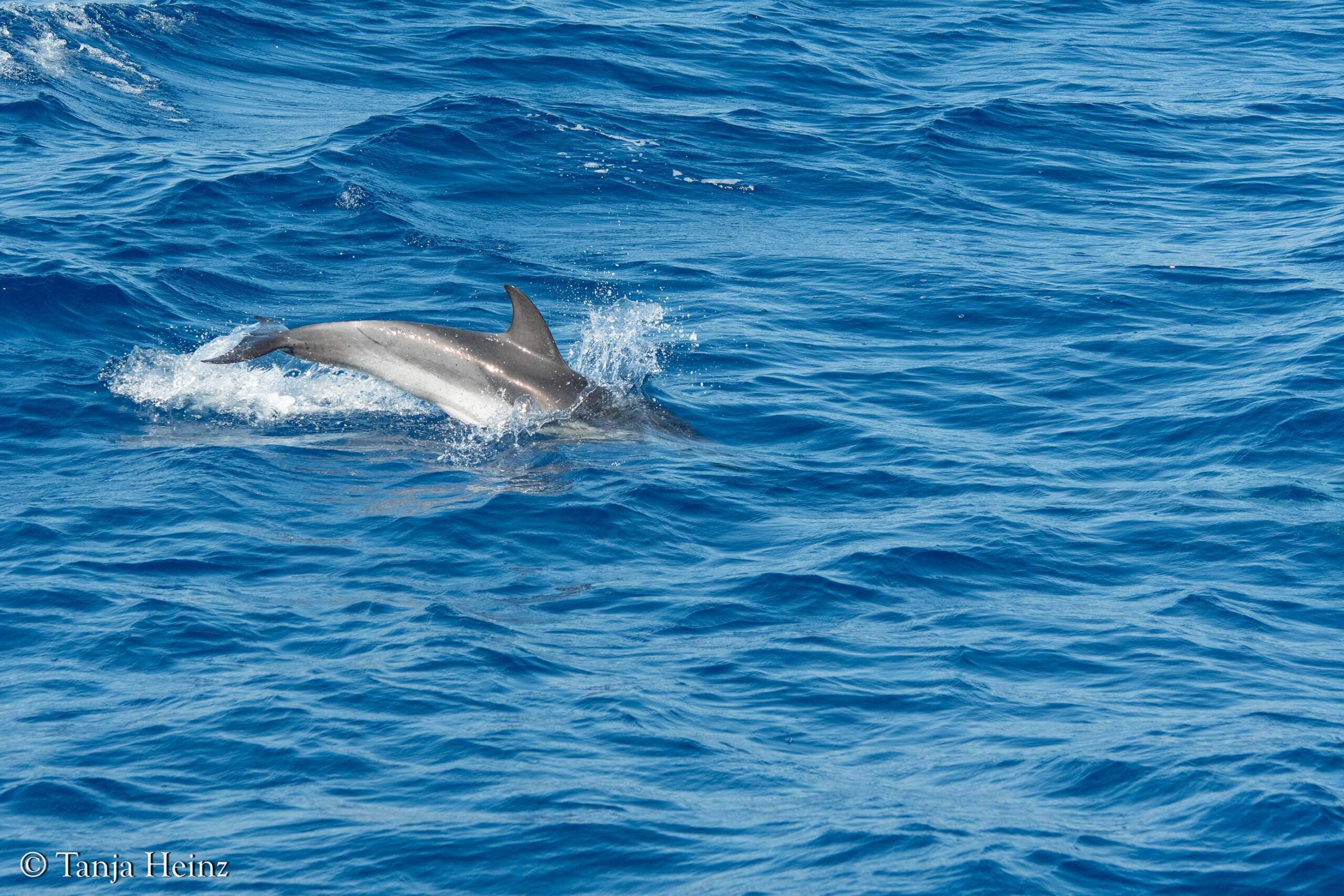
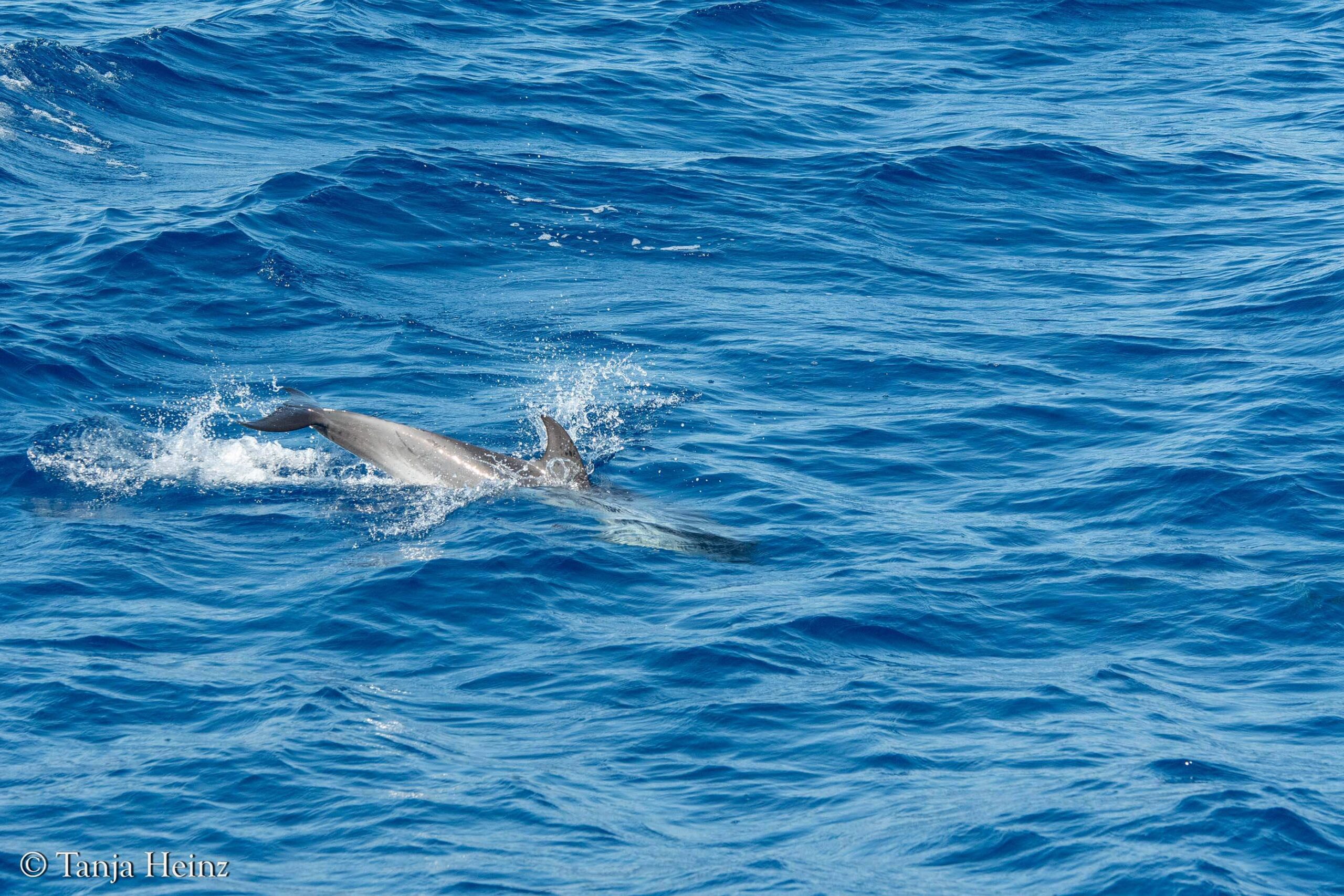

But in the photo above, you can clearly see its beautiful coloration — the striking contrast of light and dark tones along the body. Especially noticeable is the prominent black stripe running from the eye down to the anus, a characteristic feature of striped dolphins (but not fully seen in the photograph).
Nevertheless, I shifted my focus to the dolphins a little farther away, hoping to capture clearer photographs. Suddenly, to my delight, a dolphin leapt out of the water, almost balancing vertically on the surface. It was truly a breathtaking moment.
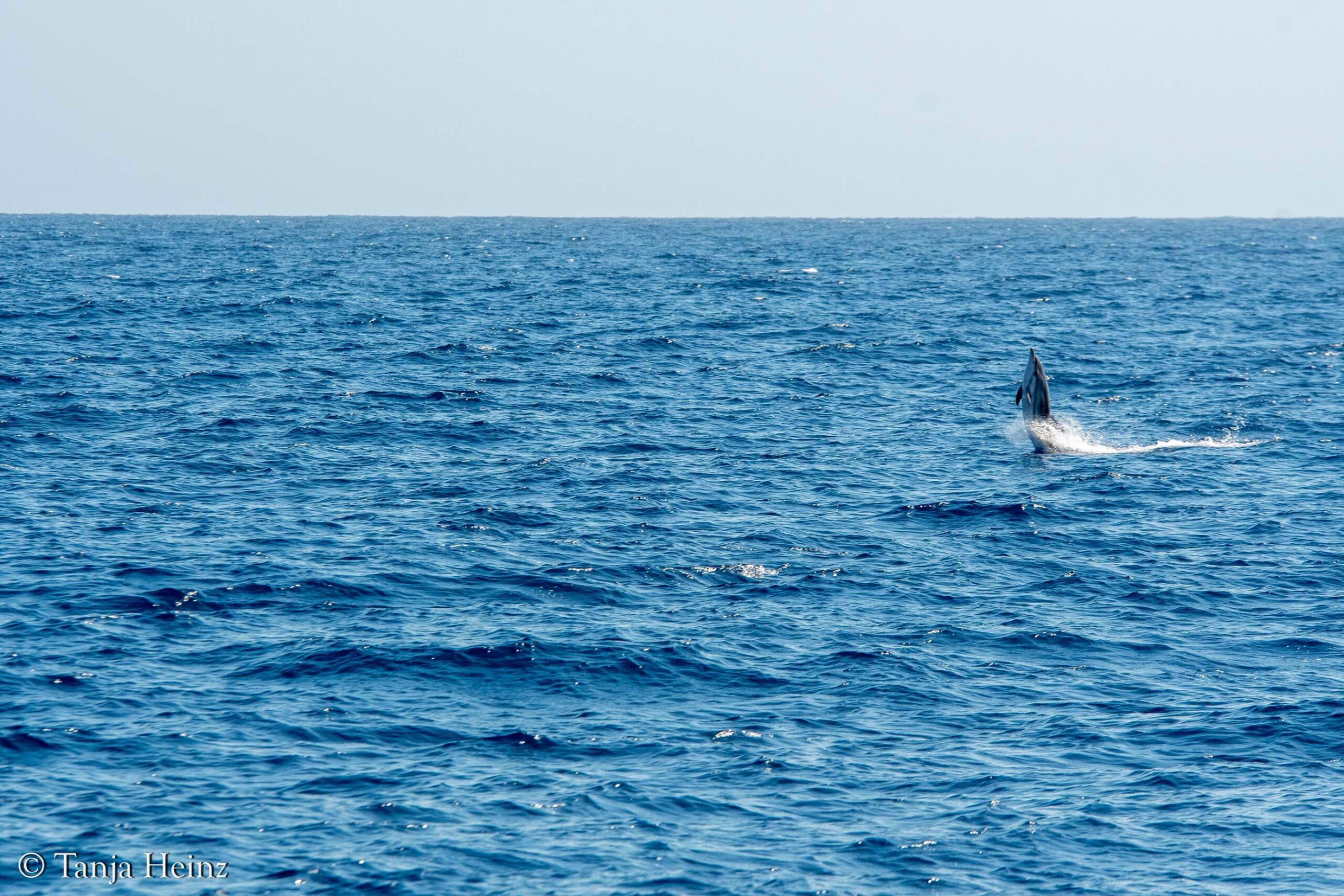
Another dolphin, closer to the boat, also leapt out of the water — only to twist sideways and splash back down moments later.

They were just so playful, and everyone on the boat was visibly excited. When another dolphin leapt out of the water, one of the other observers got so enthusiastic that he gestured wildly toward my camera — and, much to my surprise, the perfect shot of the dolphin ended up with his fingers right in the frame!
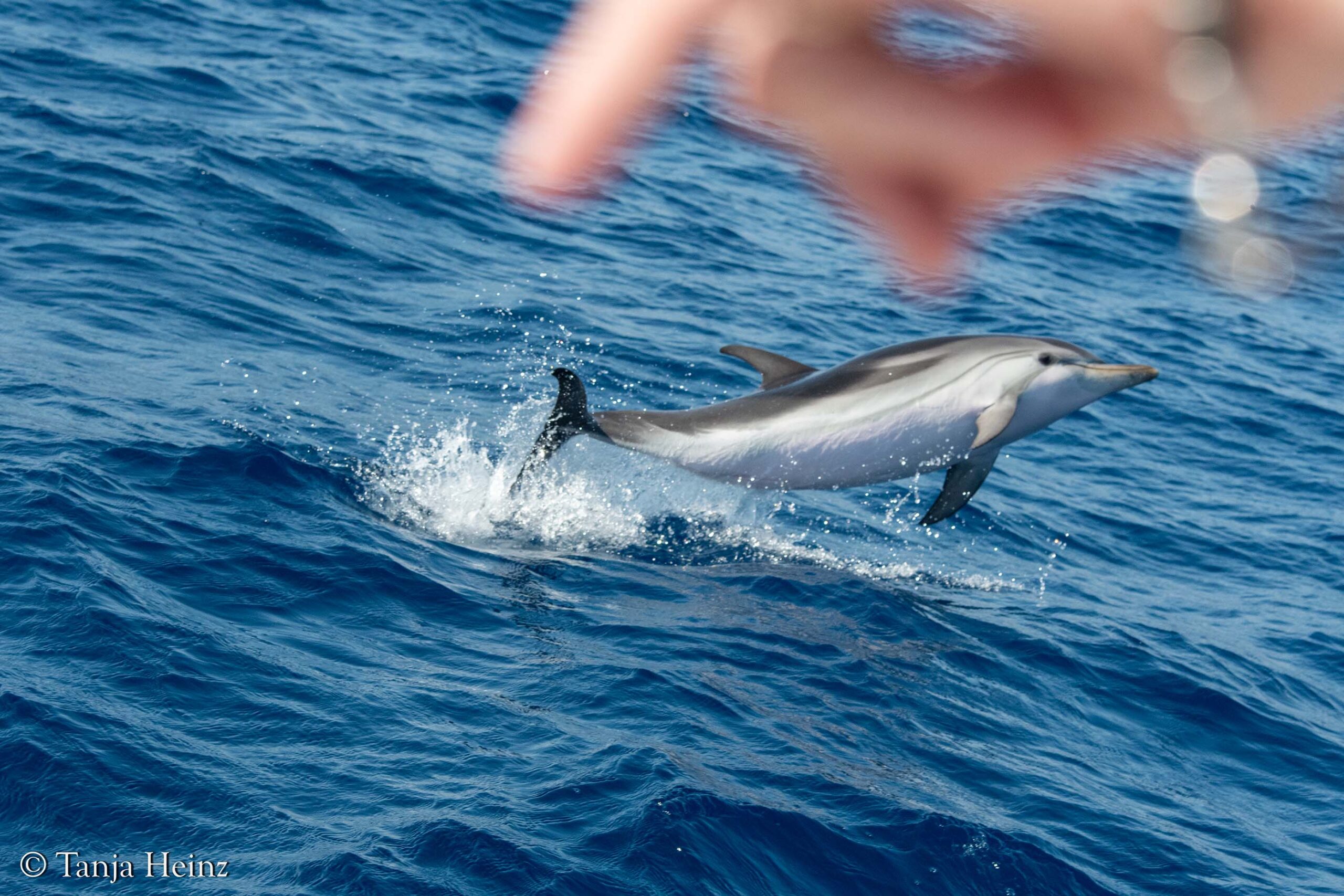
He felt really bad because his finger was in my photo, and I felt sorry that he was upset about it. But well, that’s part of dolphin watching — sometimes unexpected things happen.
When I got home, I used Photoshop to edit the photo and remove the finger, so now it’s a clean shot of the dolphin.
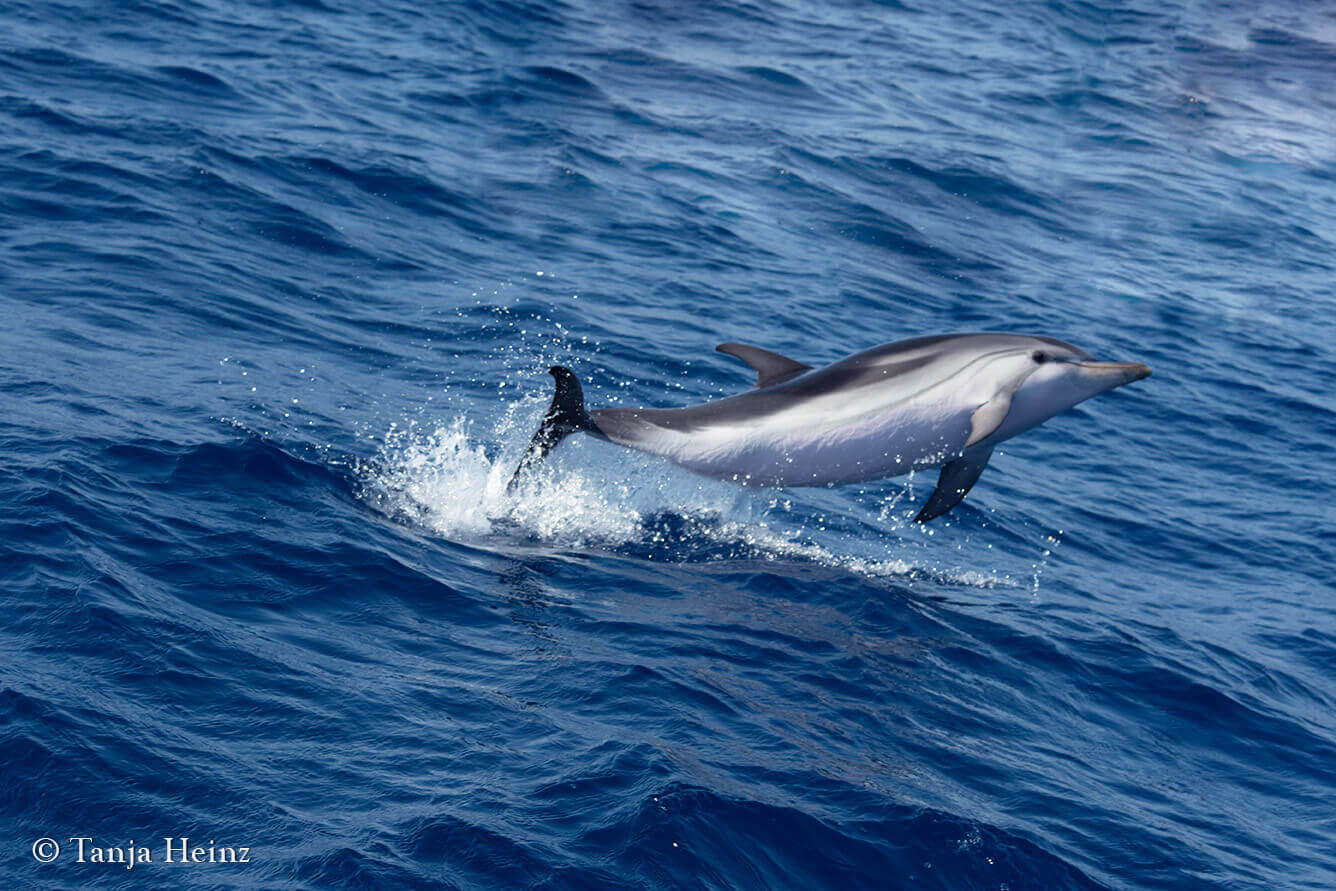
Well, these are my photographs of striped dolphins. The others mostly show just their backs and dorsal fins.
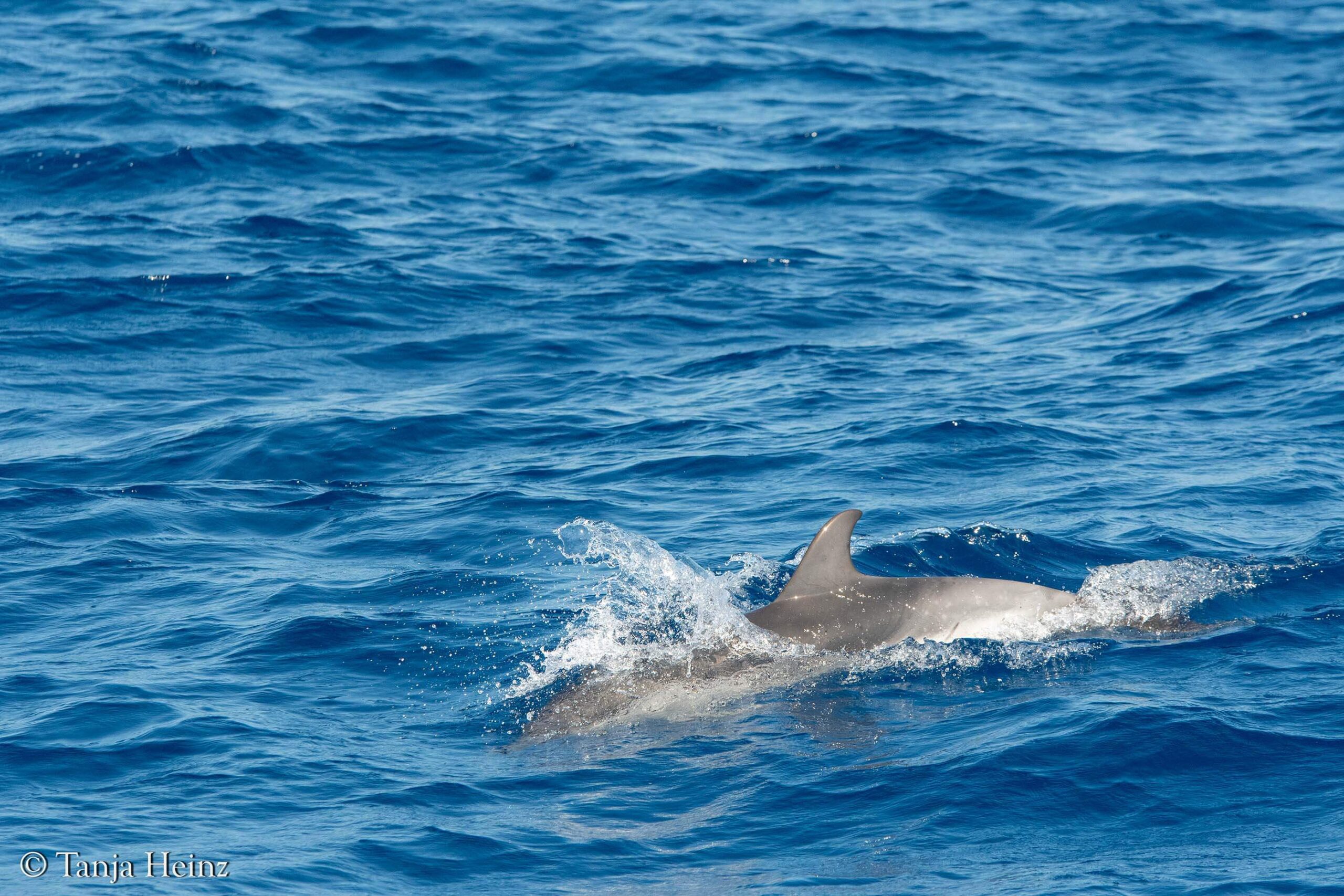
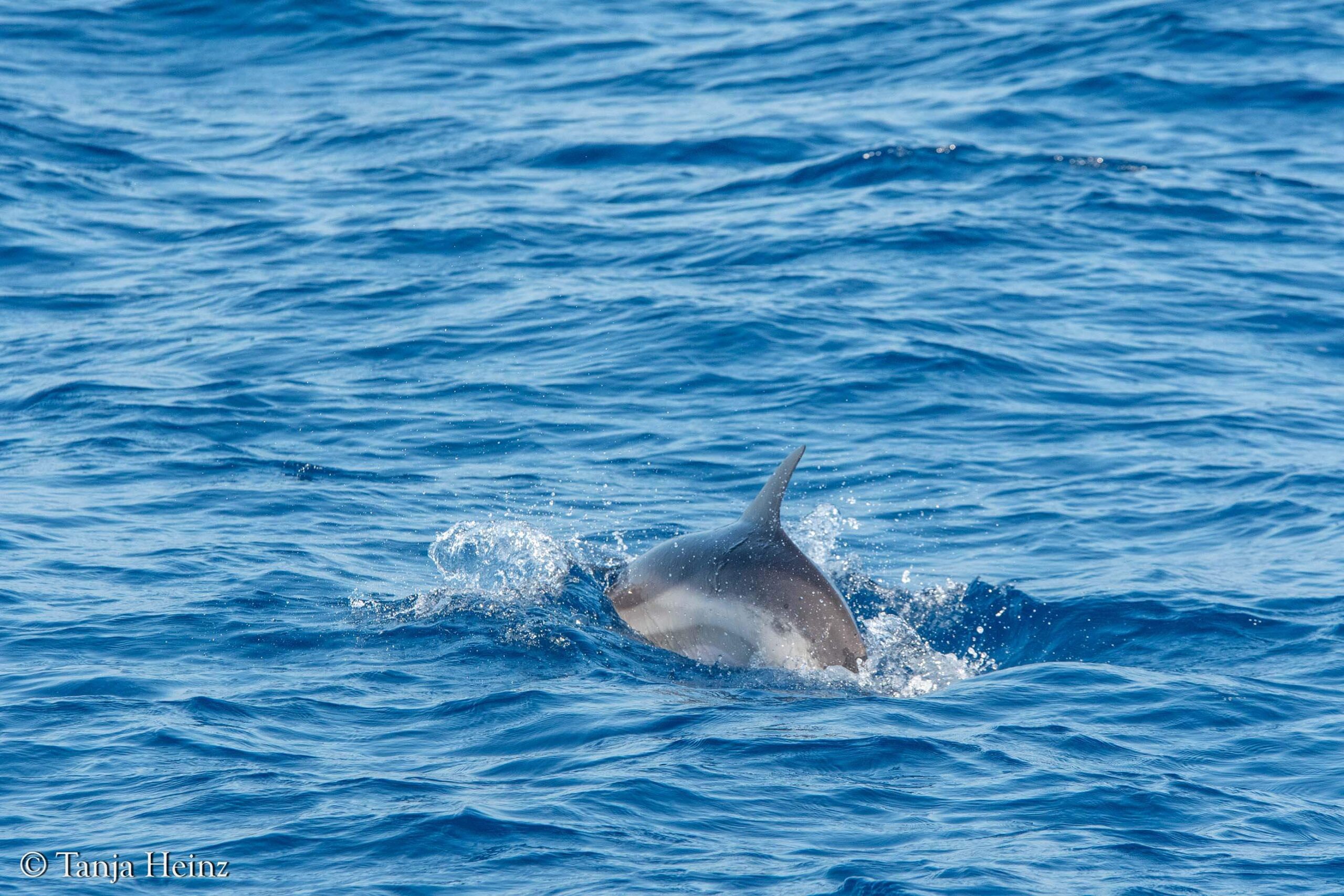
It truly was an exciting day — filled with unforgettable moments alongside both bottlenose and striped dolphins. Witnessing these magnificent creatures in their natural habitat reminded me once again how special and fragile marine life is. I feel grateful for every chance to observe and photograph them.
Information: If you want to see more striped dolphin photographs, please visit one of my other blog posts. I saw striped dolphins in the Azores and on the east coast of Spain.
Sanremo: Day 5
As mentioned earlier, the weather forecast for the following day didn’t look promising — and in fact, we had to stay in the port for two full days.
During the five days with the Tethys Institute, we all lived on the boat. The night from the second to the third day was especially windy — something I both heard and felt while lying in my bunk. So in the end, I was actually relieved that we didn’t go out to sea that day.
On the third and fourth day, the strong wind was still clearly noticeable, especially from a scenic viewpoint in Sanremo. You can see some photos from that location further down in this blog post.
Fortunately, on the fifth day, the weather finally turned — the sky was bright, the sea calm, and we were able to leave the port again. From afar, we could already see another boat out on the water. Some gulls seemed to greet us as we set off. The conditions were perfect — and hopes were high.


Question: Do you happen to know which gull is shown on the right? If you do, feel free to let me know in the comments — I’m not a gull expert, and so far I haven’t been able to identify it. Thanks in advance!
Let me say it right from the start: we didn’t see any bottlenose dolphins this time — nor any striped dolphins. But instead, we were lucky enough to encounter a solitary male sperm whale.
It all began when the researcher on board picked up the whale’s vocalizations using the acoustic device. The skipper immediately set course in the direction of the sound. Then we waited.
It didn’t take long — soon we heard the unmistakable blow, and moments later, we saw the first spout rising from the surface.
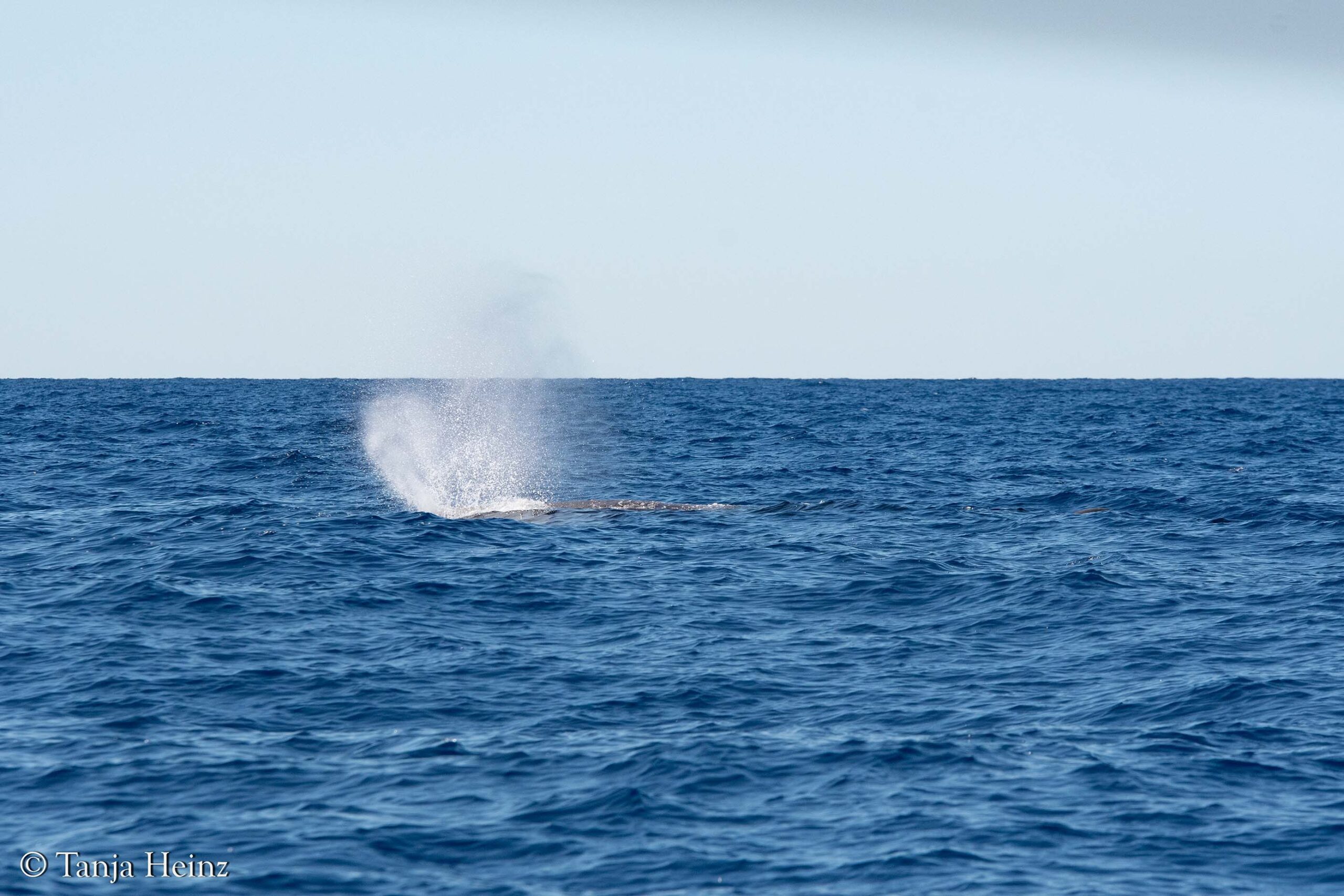
It was the second time I had the chance to see sperm whales — the first time was in the Azores. However, while I mainly saw females there, which are significantly smaller, this time off the coast of Sanremo I encountered a male sperm whale — and he was noticeably larger.
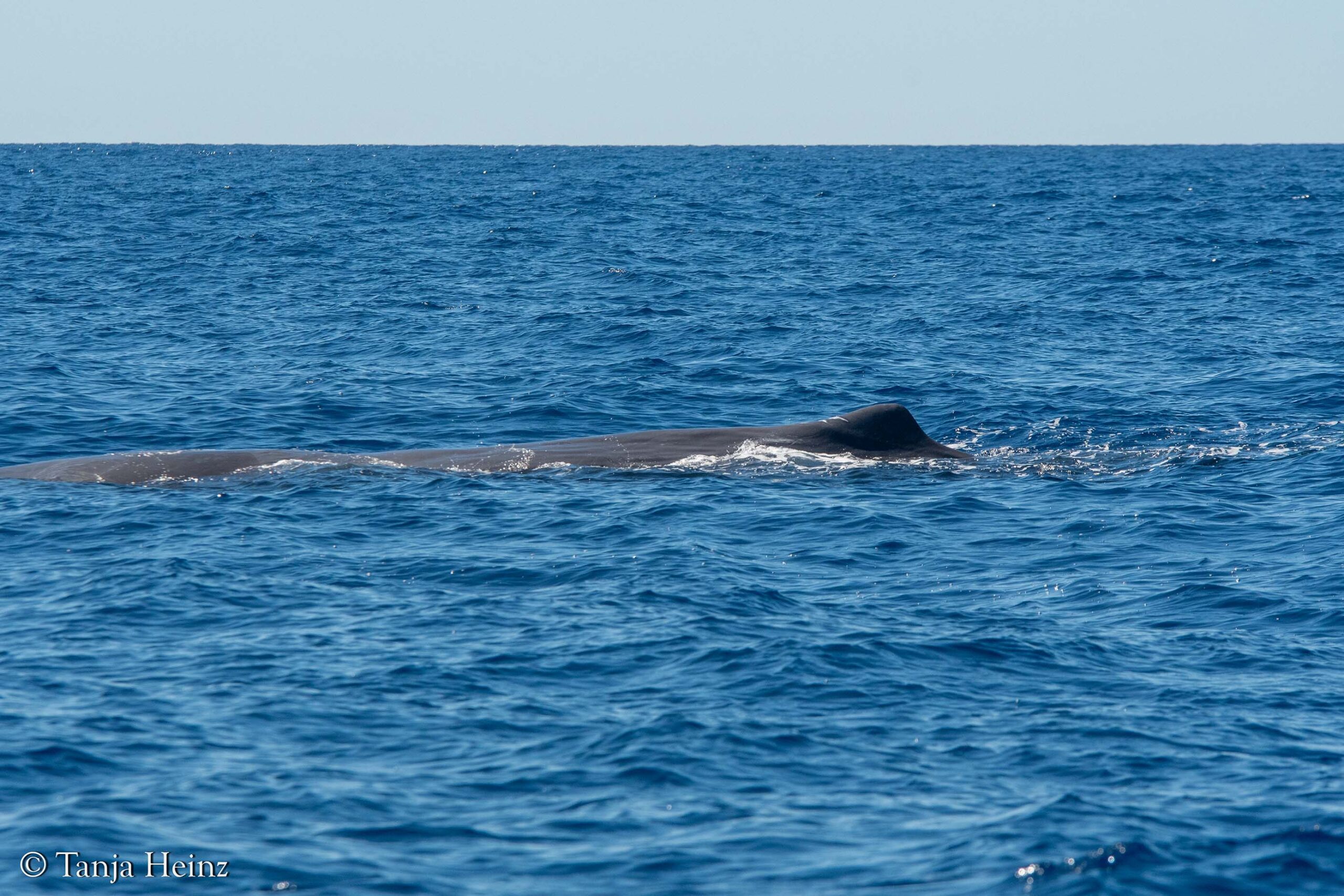
Information: Would you like to know more about my sperm whale encounters in the Azores? Then feel free to visit my blog post about whale watching on the island of Pico. If you're interested in the Azores, you might also enjoy reading about other wildlife experiences there — or perhaps you’re curious about hiking on the islands.
By the way, in sperm whales, males are roughly twice as long as females — a truly remarkable difference. In biology, this is known as sexual dimorphism, where males and females of a species differ significantly in size or appearance.
At first, I must admit, I thought there were two sperm whales at the surface. But that wasn’t the case. What I mistook for a second animal was actually the large snout and the hump of a single whale, both protruding clearly above the water. It’s easy to be fooled for a moment — especially when seeing such a massive animal in the open sea.
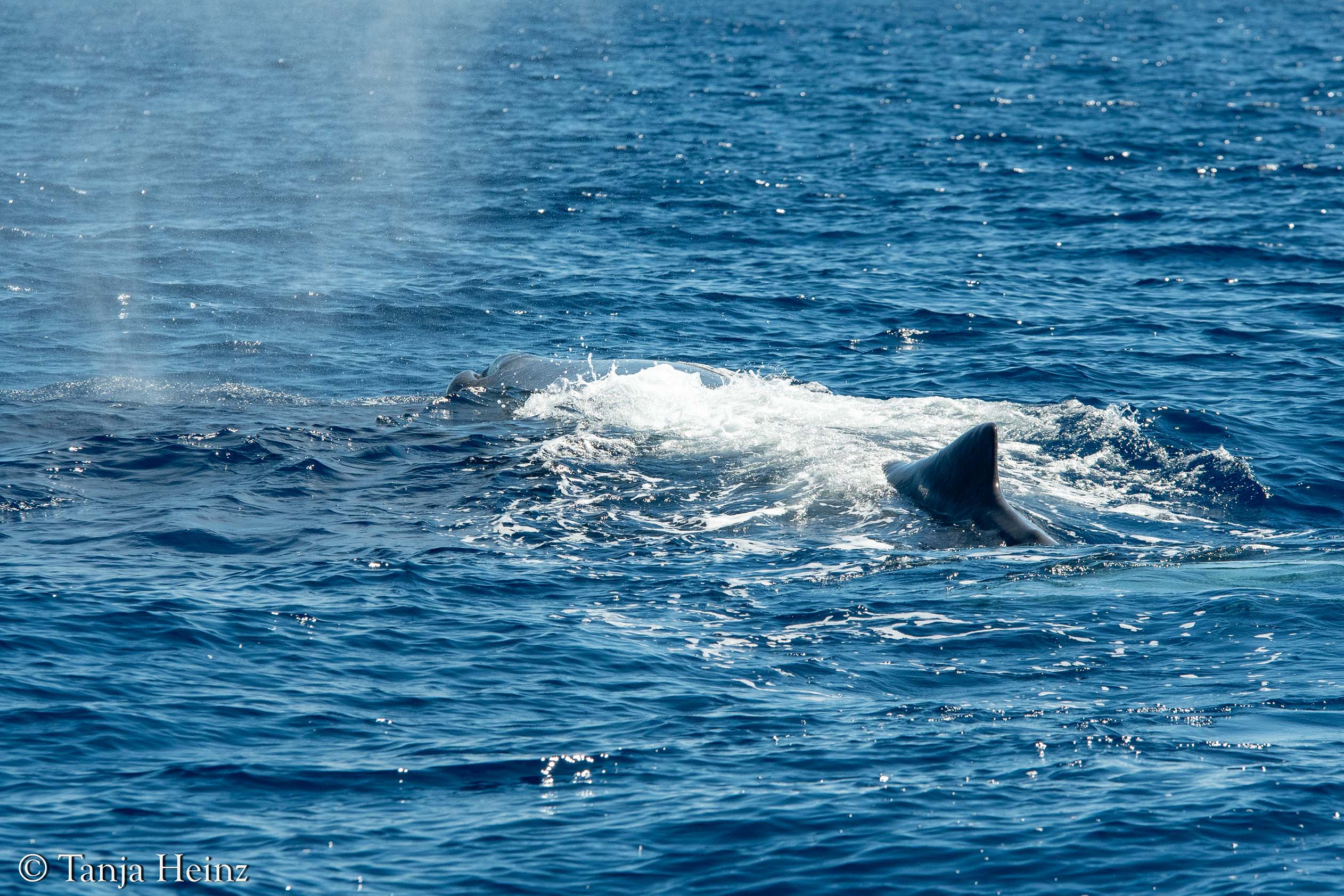
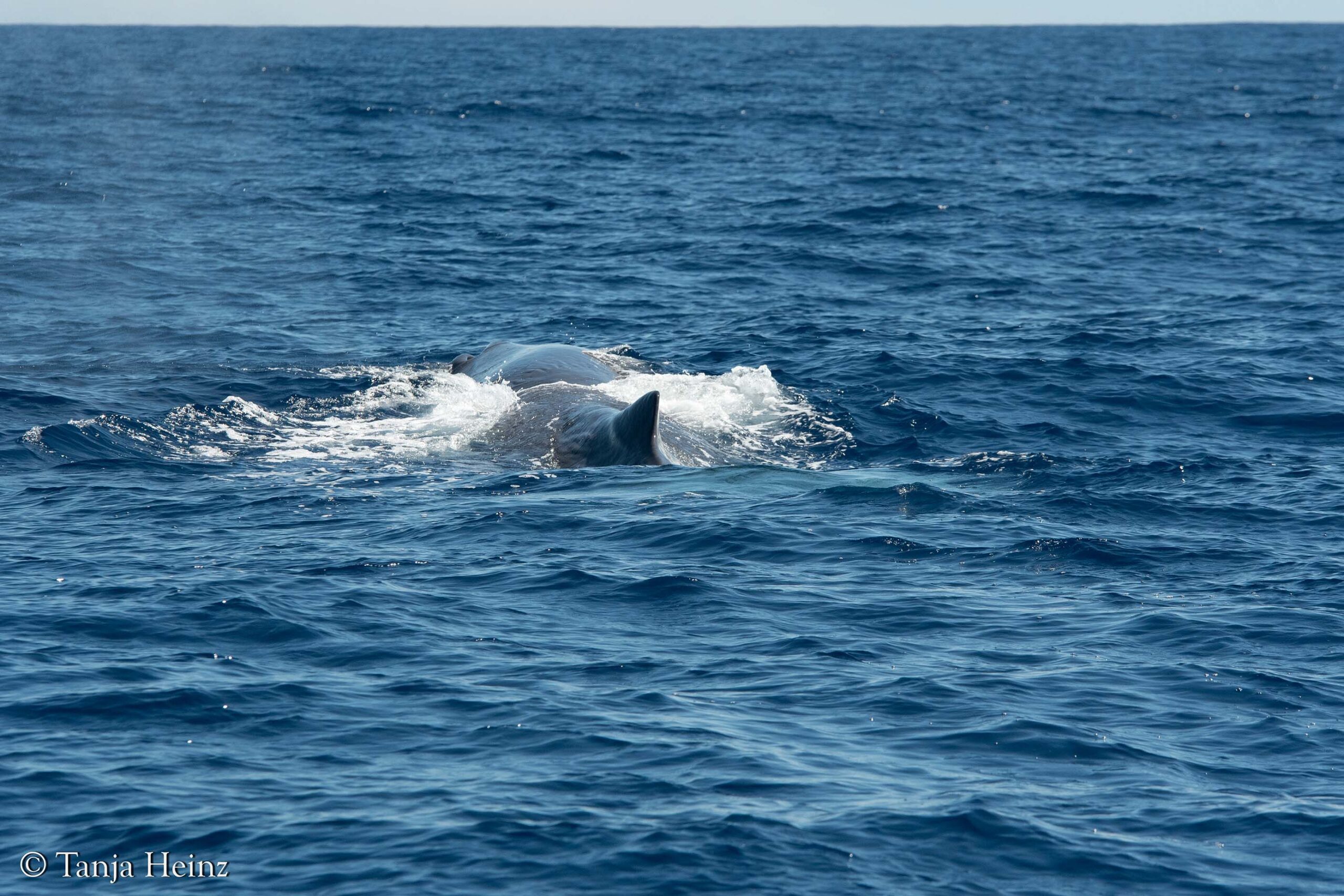
By the way, if you spot a blow in the distance and it’s angled low to the left, there’s a good chance you’re looking at a sperm whale — unless, of course, the wind is blowing against it and causes the blow to rise more vertically.
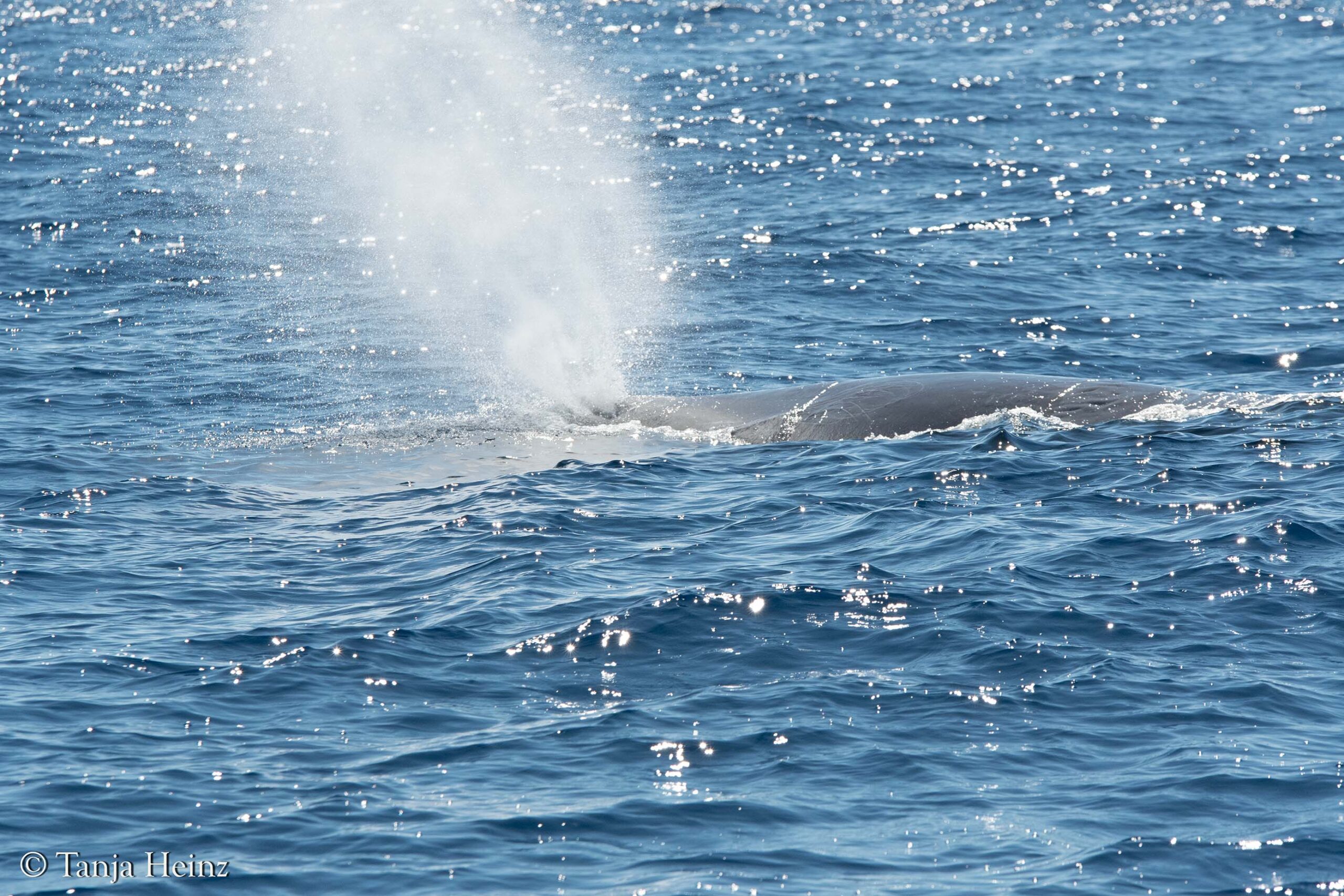
The sighting was truly beautiful, although getting a clear view of the massive, box-like head of a sperm whale can be quite difficult — they rarely show it fully at the surface.
But this individual gave us a real treat: it surfaced multiple times and showed its characteristic blow again and again.
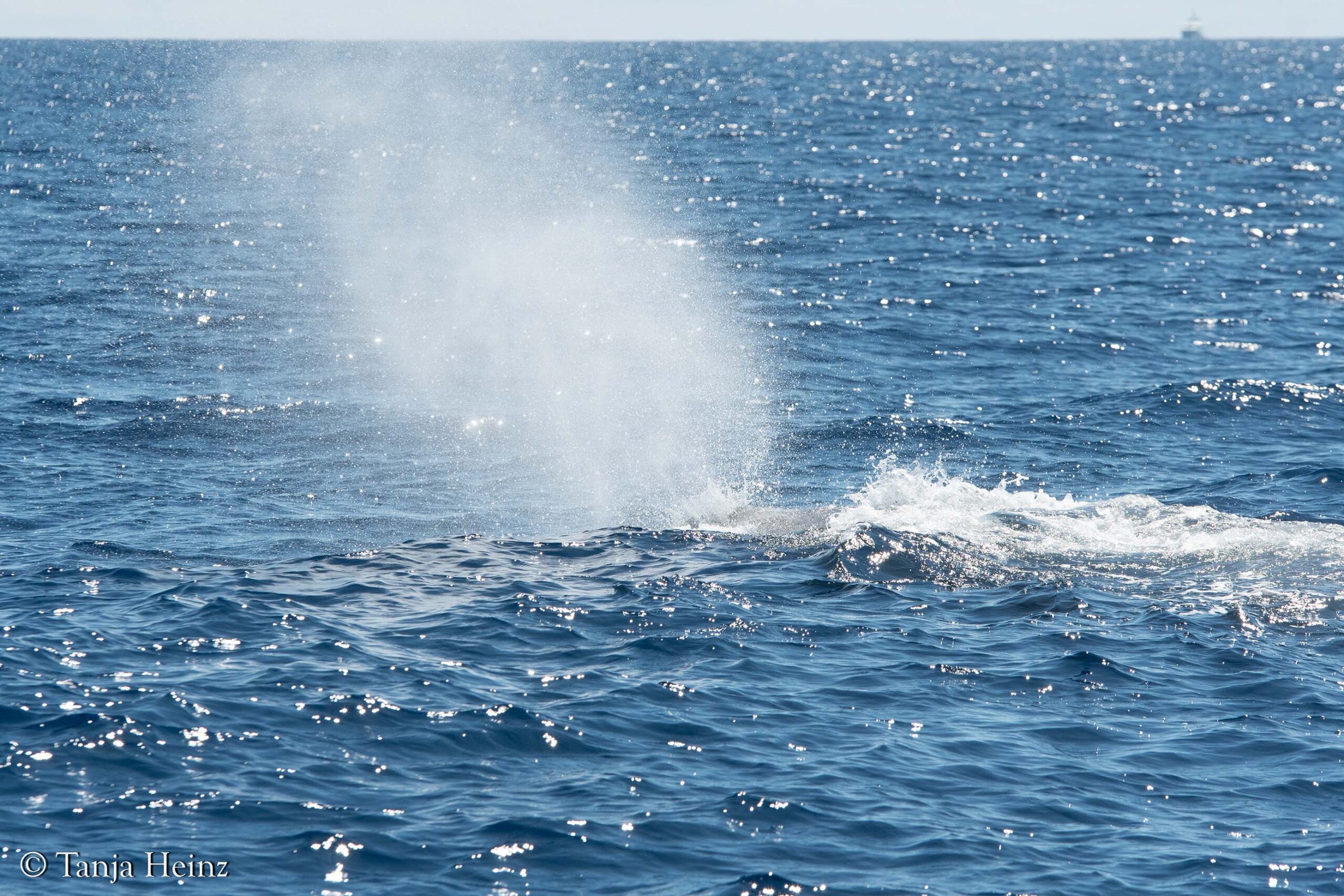
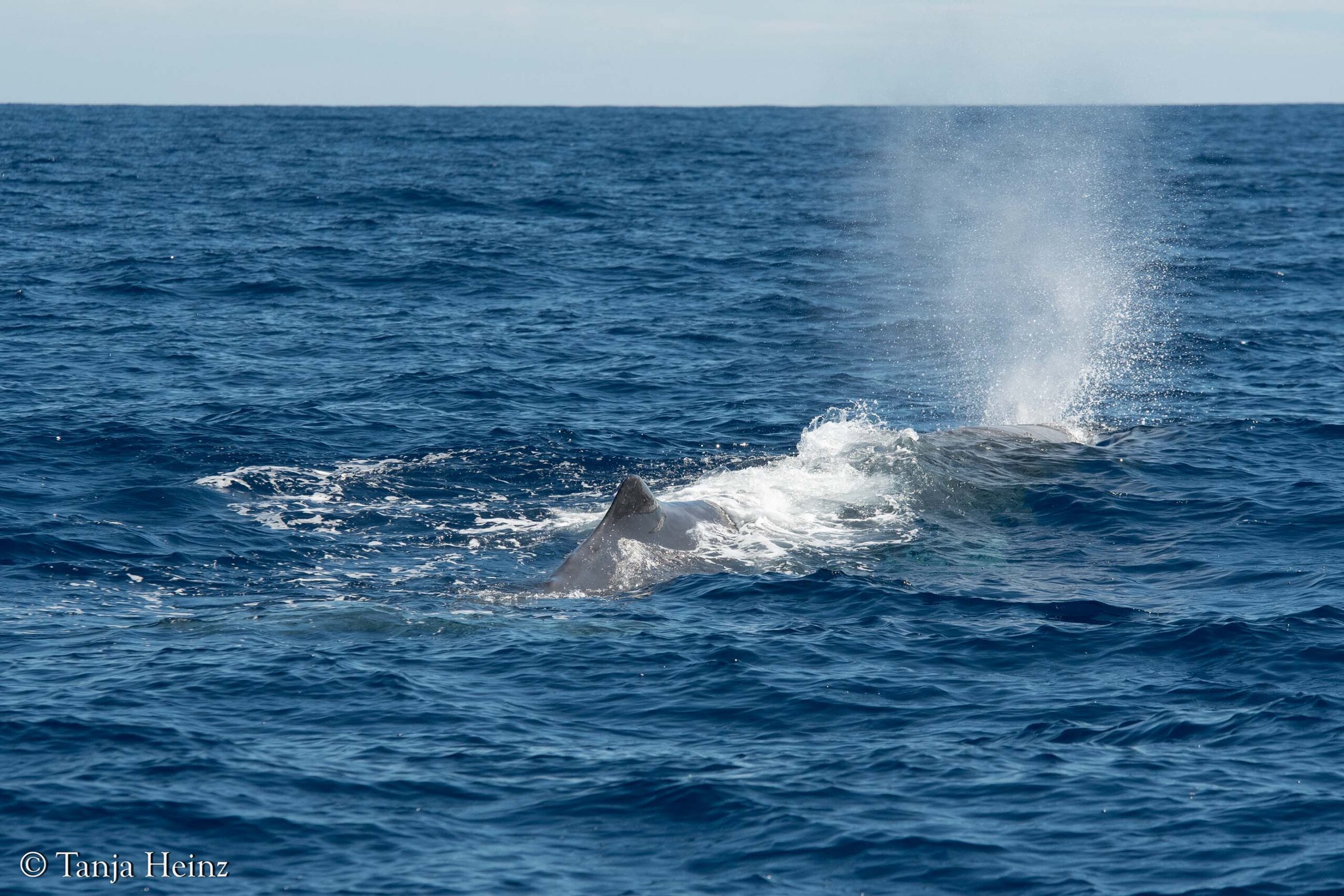
Compared to the dolphins, the sperm whale appeared quite calm and was easier to follow with the camera. But that didn’t necessarily make it easier to photograph — most of its massive body remained hidden beneath the surface, with only a small part visible above the water.

Sperm whales have a rounded or triangular hump that almost looks like a dorsal fin. At first, I thought it was a dorsal fin — but of course, it wasn’t. I noticed this fin-like hump just before the whale dove again, more or less in the same spot where it had surfaced.
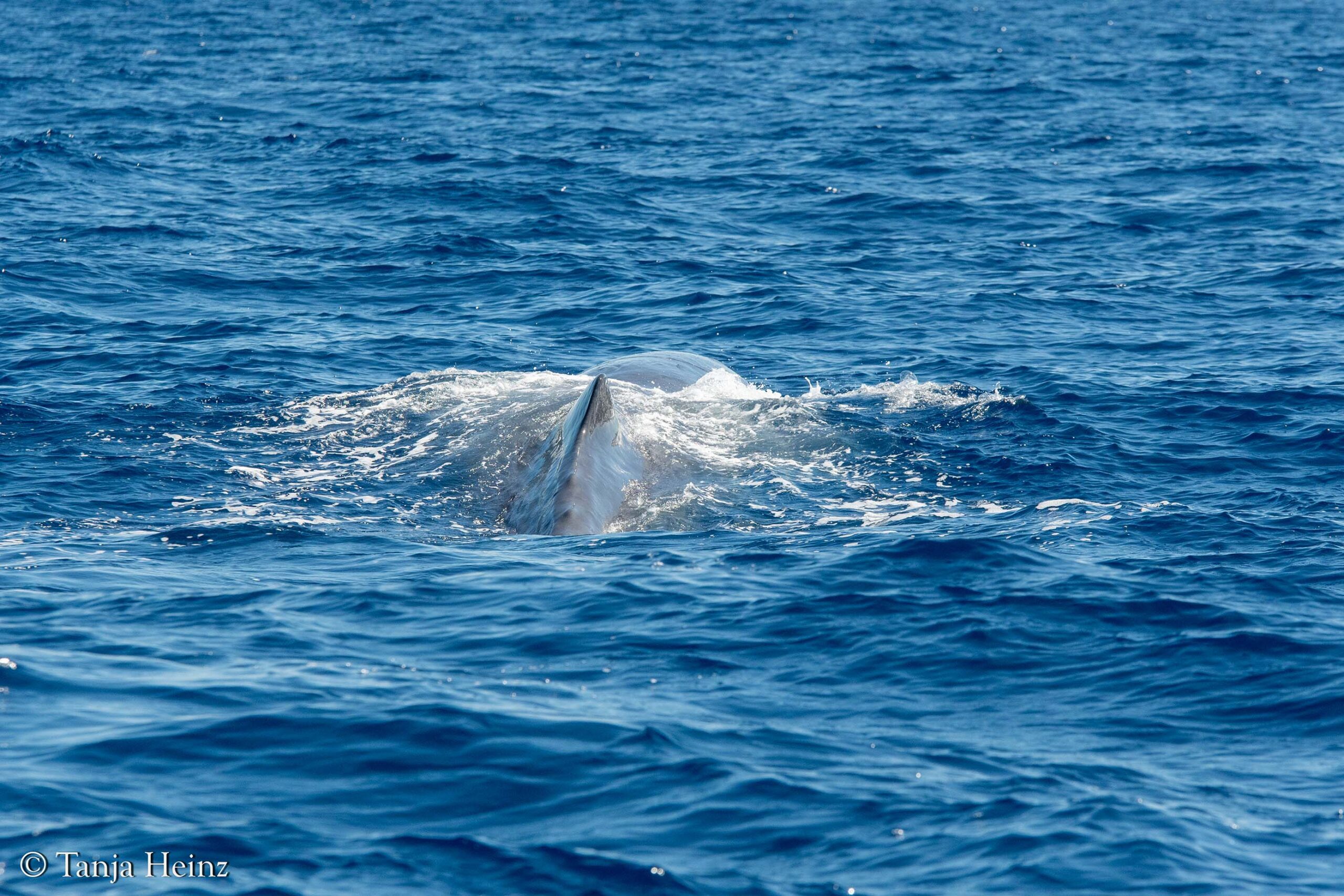
Then came the moment when I saw the researcher and her volunteers preparing for the dive — they already knew exactly when it was time.
Sperm whales usually stay at the surface for about 10 minutes before diving again, often from the very same spot where they surfaced.
This is always a special moment, because it offers a clear view of their impressive tail fluke as they disappear beneath the waves.
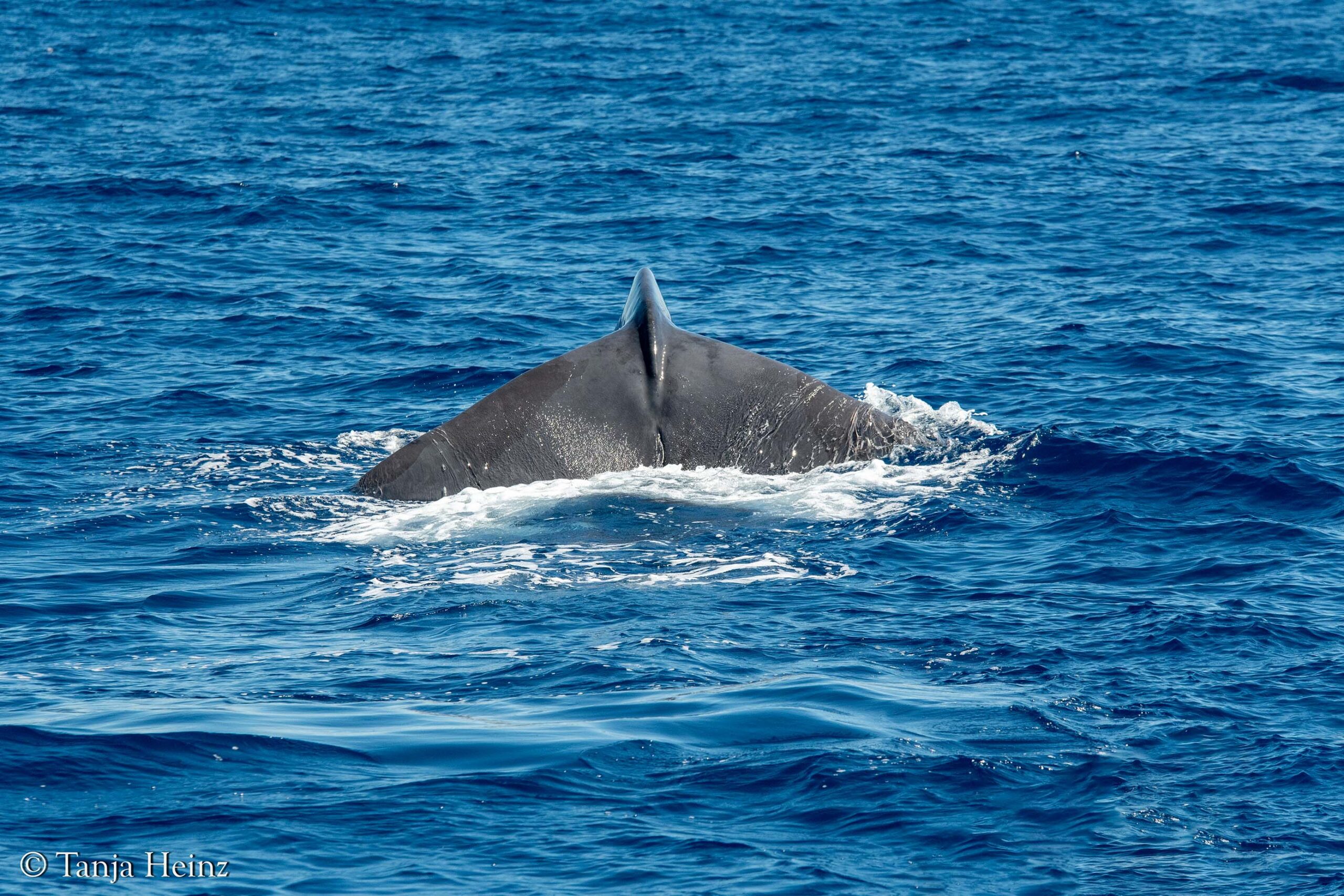
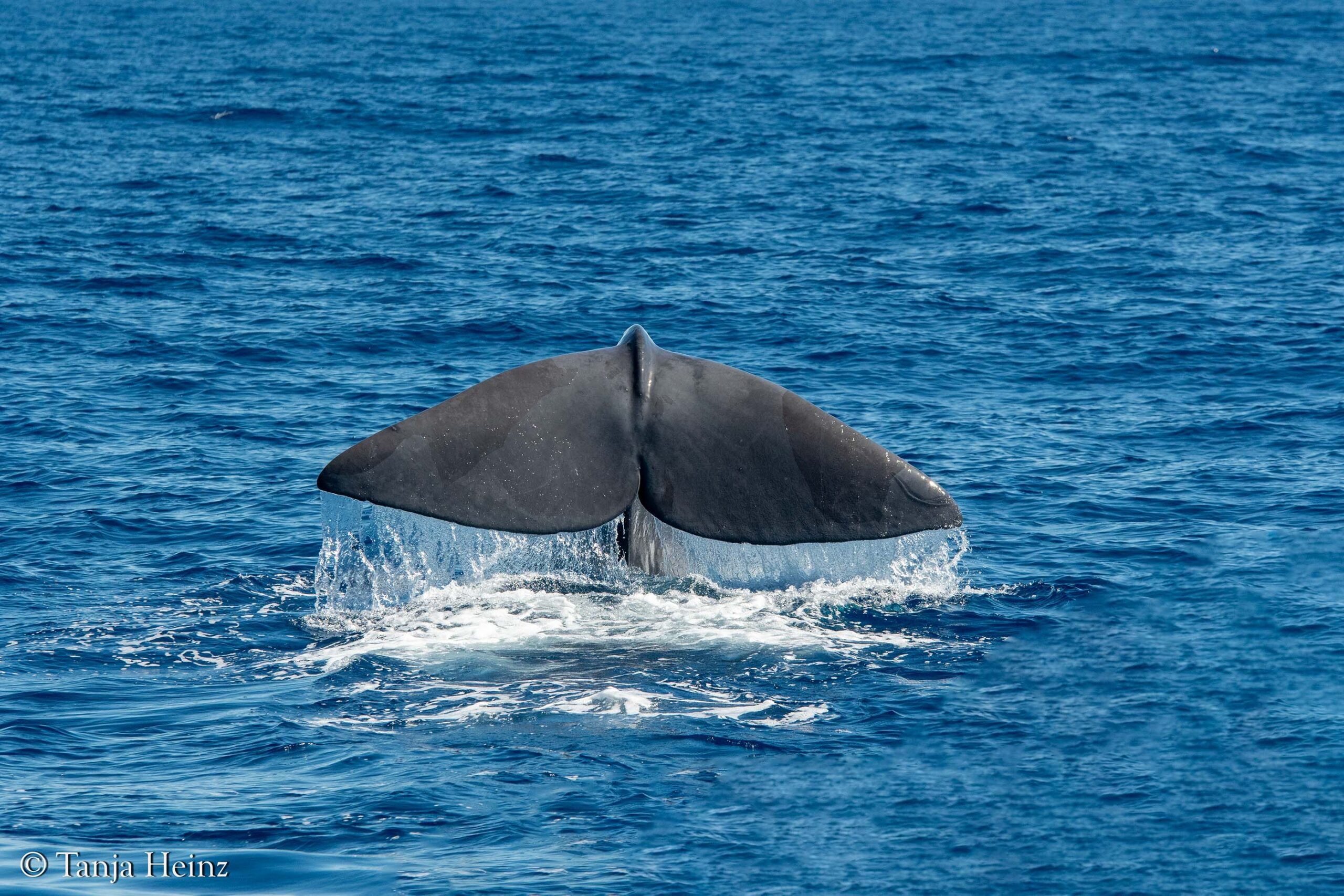
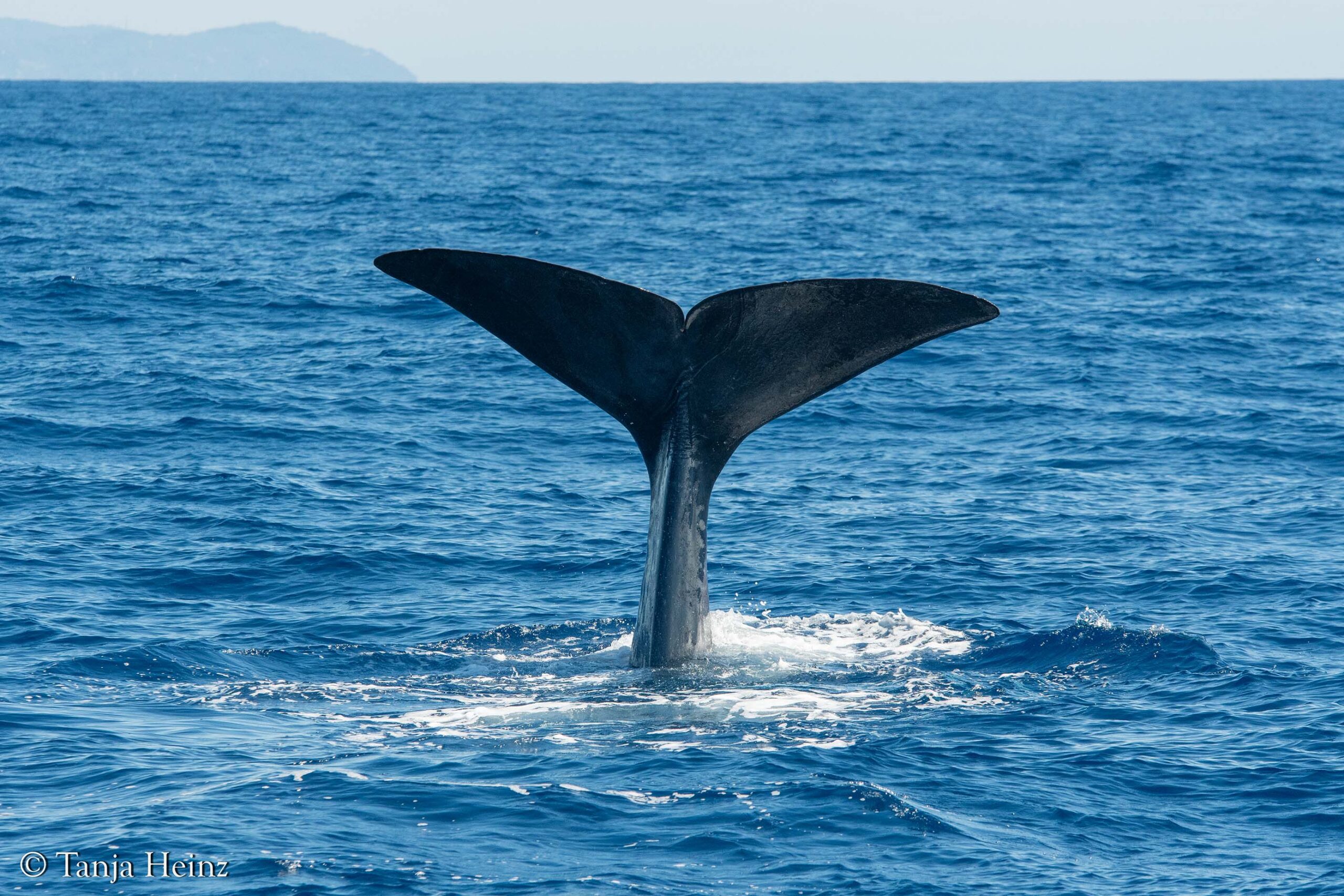
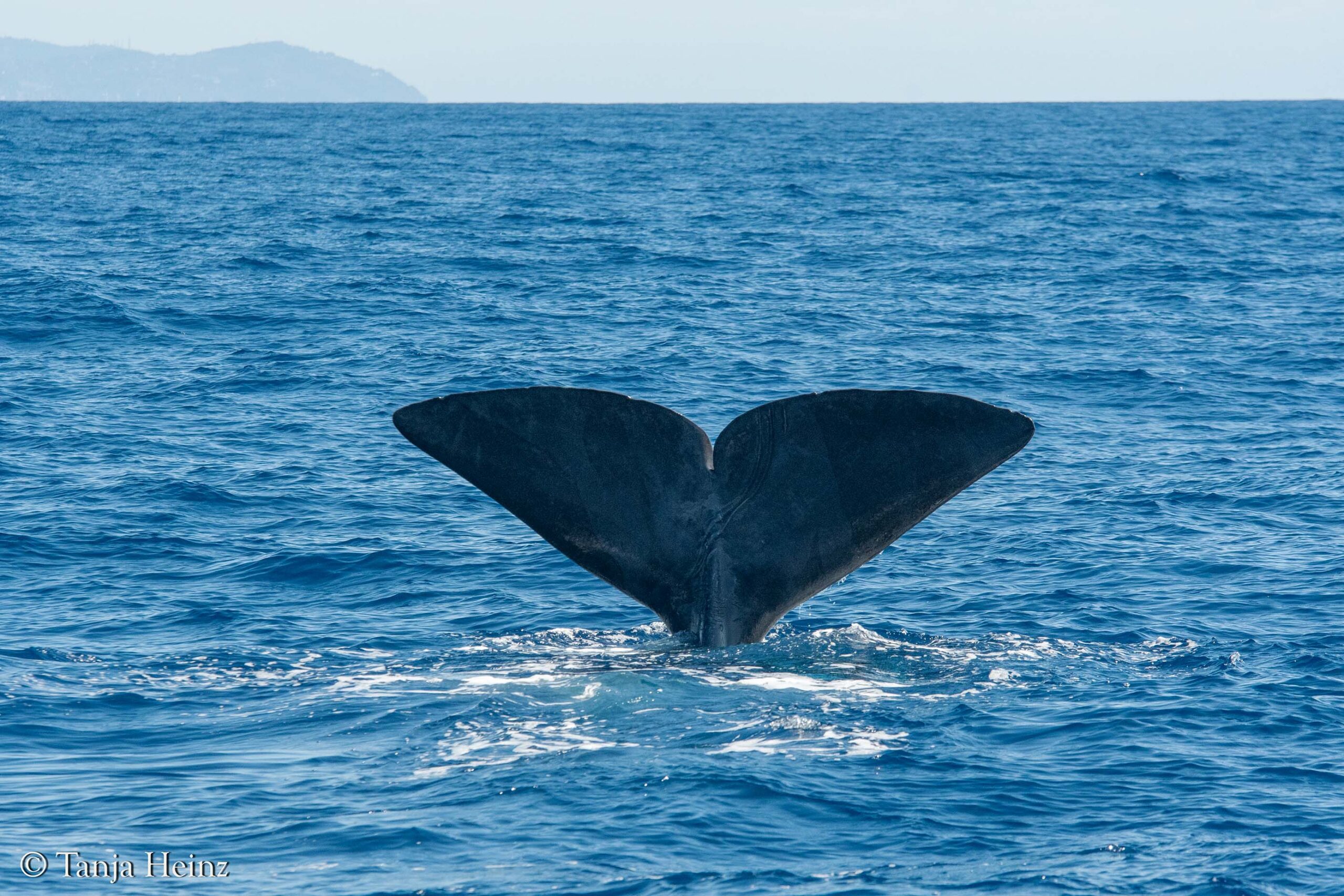
Information: Happywhale is a great platform for sharing photographs of whale tail flukes. By uploading a photo, you can find out where a whale has been seen before — and whether it has been recorded elsewhere. In this case, the sperm whale I photographed hadn’t been matched with any previous sightings. Either no one else has seen this individual yet, or it simply hasn’t been submitted to Happywhale. So for now, I wasn’t able to learn more about this particular whale — but who knows what future matches might reveal!
After the sperm whale disappeared into the depths, we began preparing lunch. It was actually the first time during those five days on the boat that we had lunch out at sea instead of back in the port.
Returning to land would have taken too much time — and since all the food was already on board, there was really no reason to go back.
So we stayed out on the water, enjoying the calm and the sunshine, and waited in hopes that the sperm whale might resurface.
It truly was a beautiful day — peaceful, memorable, and filled with quiet moments of wonder.

While we were still having lunch, the sperm whale surfaced again. Honestly, I can't remember exactly how much time had passed — but it must have been less than two hours.
Sperm whales are known to stay underwater for over two hours and can dive as deep as 3,000 meters.
This one didn’t stay down quite that long, but long enough for us to fully relax — and then be pleasantly surprised by its return.

The second time the sperm whale surfaced, it didn’t stay up for very long.

And then, as the sperm whale arched its back, even I could tell — it was preparing to dive and disappear into the deep.
I readied my camera, hoping to capture that special moment when the tail fluke rises above the surface.
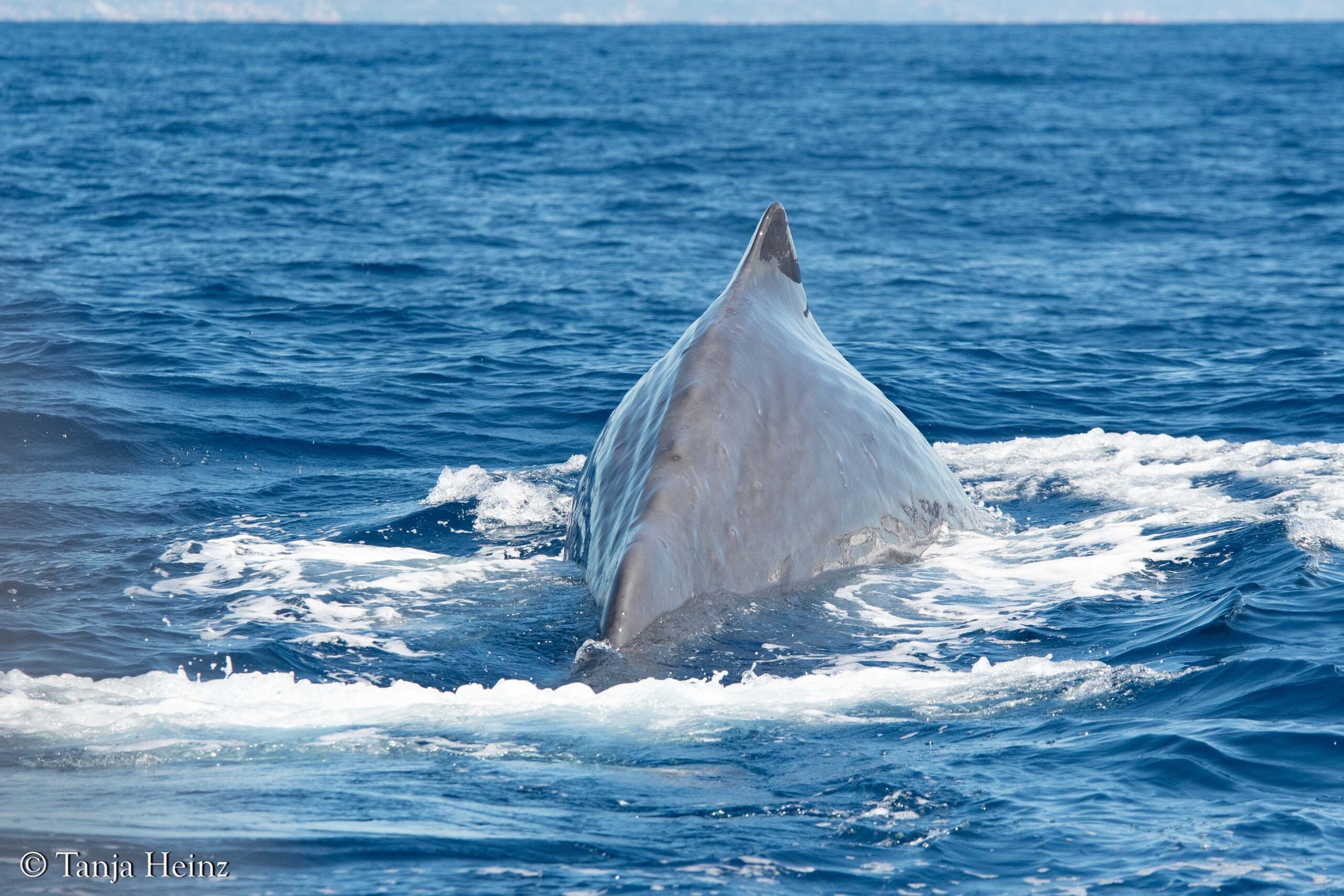
Unfortunately, I wasn’t in the best position, and the boat was rocking quite a bit — so I didn’t manage to get a good photo of the dive.
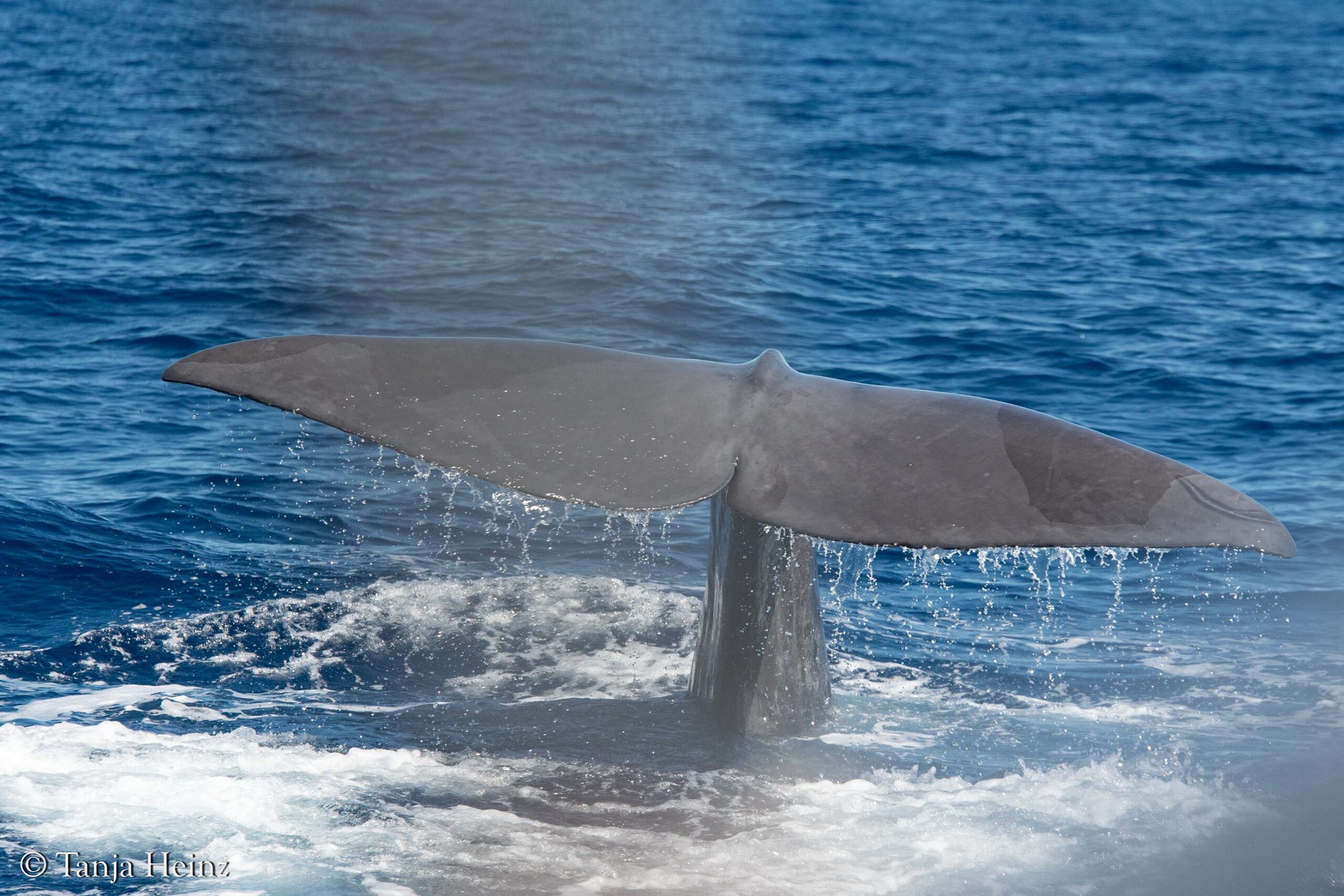
It was the second — and also the last — time we saw this sperm whale. We waited a while longer, hoping it might surface again, but it had apparently moved on.
So we left the area and continued our search for other sperm whales or perhaps even different species.
Unfortunately, we weren’t lucky that afternoon. We spent several more hours out on the boat, scanning the sea, but no more marine mammals appeared. At one point, some striped dolphins were heard acoustically, but we never caught sight of them.
Still, as we cruised along the coast, the stunning views of the shoreline and the vast, open sea more than made up for the quiet spell. Sometimes, it's not only about what you see — but also about being present in that moment, surrounded by nature.
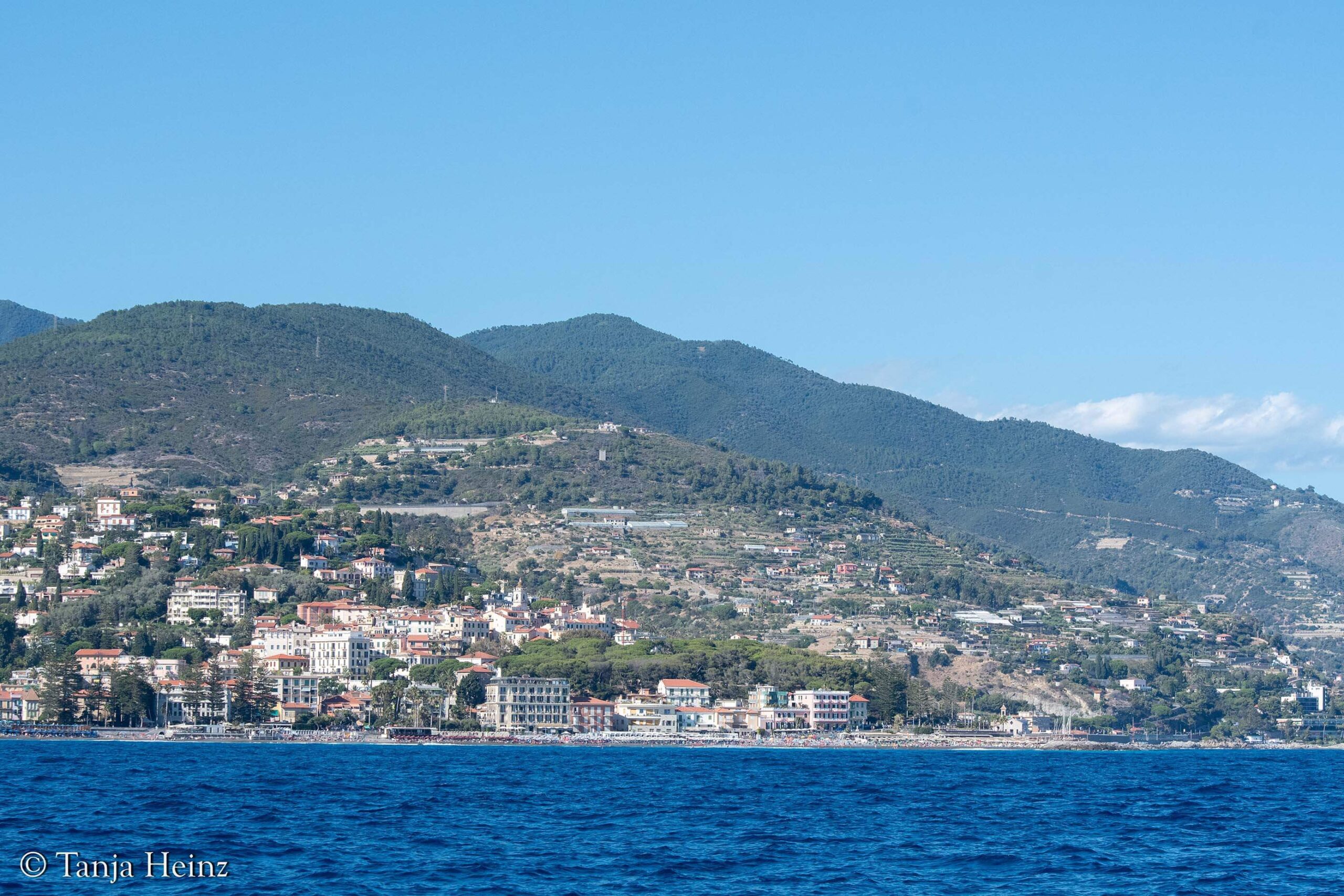
Information: If you're looking for a good guide to whales and dolphins in the Mediterranean Sea and elsewhere, I can highly recommend Whales, Dolphins, and Seals by Hadoram Shirihai and Brett Jarrett. It’s richly illustrated, full of detailed species descriptions, and has become one of my go-to books when I want to learn more about the marine mammals I’ve seen — or hope to see one day.
Sanremo
The Tethys Institute, from where the excursions departed, is located in Sanremo — a charming coastal town in the northwest of Italy, just about 20 kilometers from the French border.
Sanremo is not only a great place for watching whales and dolphins in the Mediterranean Sea, it has both a picturesque Old Town and more modern districts. I was especially taken with the Old Town, which climbs steeply up the hillside. It’s a bit of a workout, but absolutely worth every step. One of the most fascinating places there is the passage called La Pigna — a maze of narrow alleys, arches, and stairs that feels like stepping back in time.
One evening, on a day we didn’t go out to sea, we sat there enjoying the warm summer air and the lively atmosphere. Music filled the streets, and yes — it was quite crowded, but in a cheerful and relaxed way. Sanremo is a lively, friendly town that welcomes you warmly.
I have to admit, I didn’t really dive into the town’s history. But one afternoon, I visited an exhibition about Frida Kahlo. Admittedly, this doesn't have much to do with Sanremo or Italy — but it just goes to show that there’s culture here, too, if you’re looking for it.
Since this blog post is primarily about whales and dolphins in the Mediterranean Sea, I won’t go into too much detail about Sanremo — but I’d love to share a few visual impressions of the town with you below.
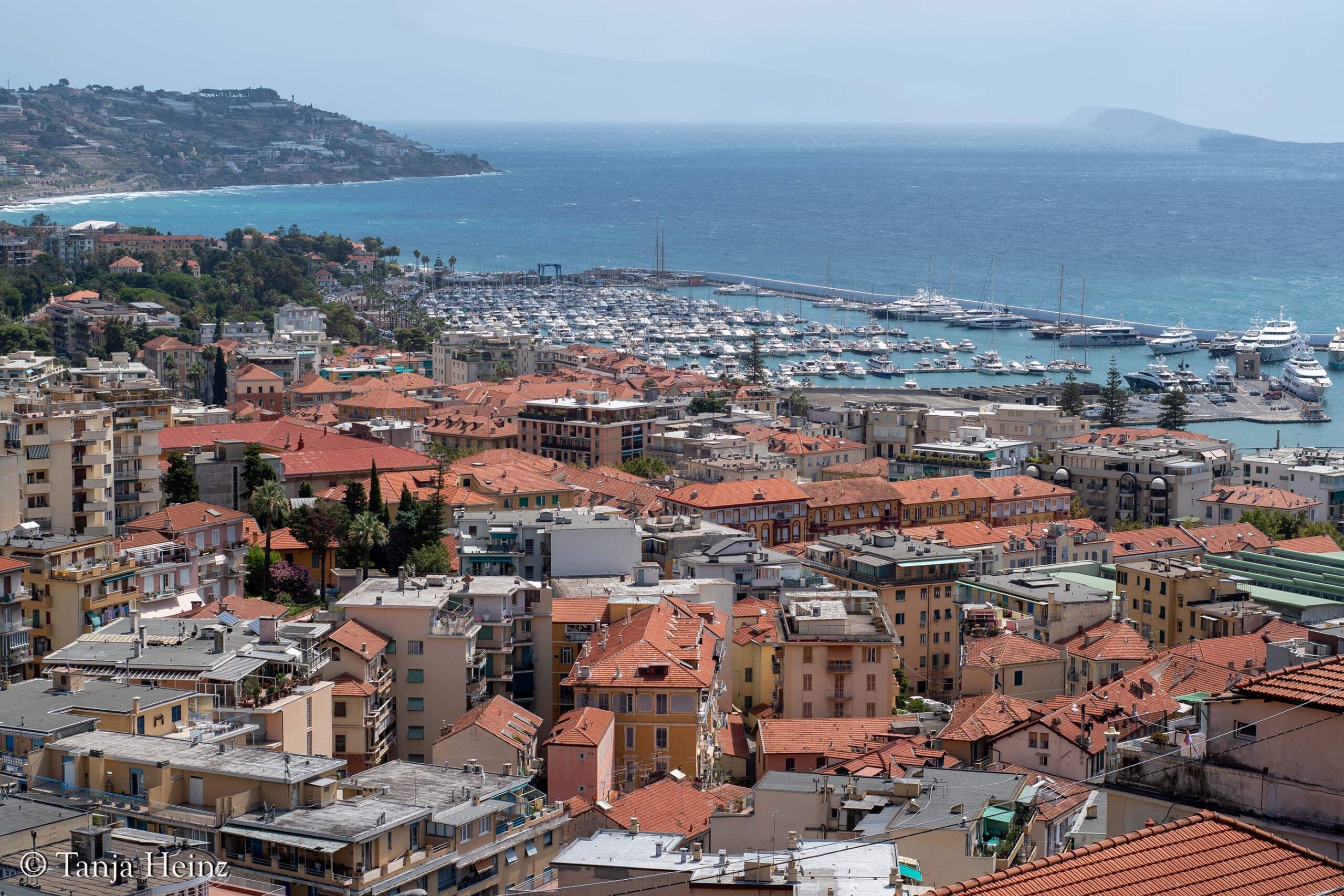
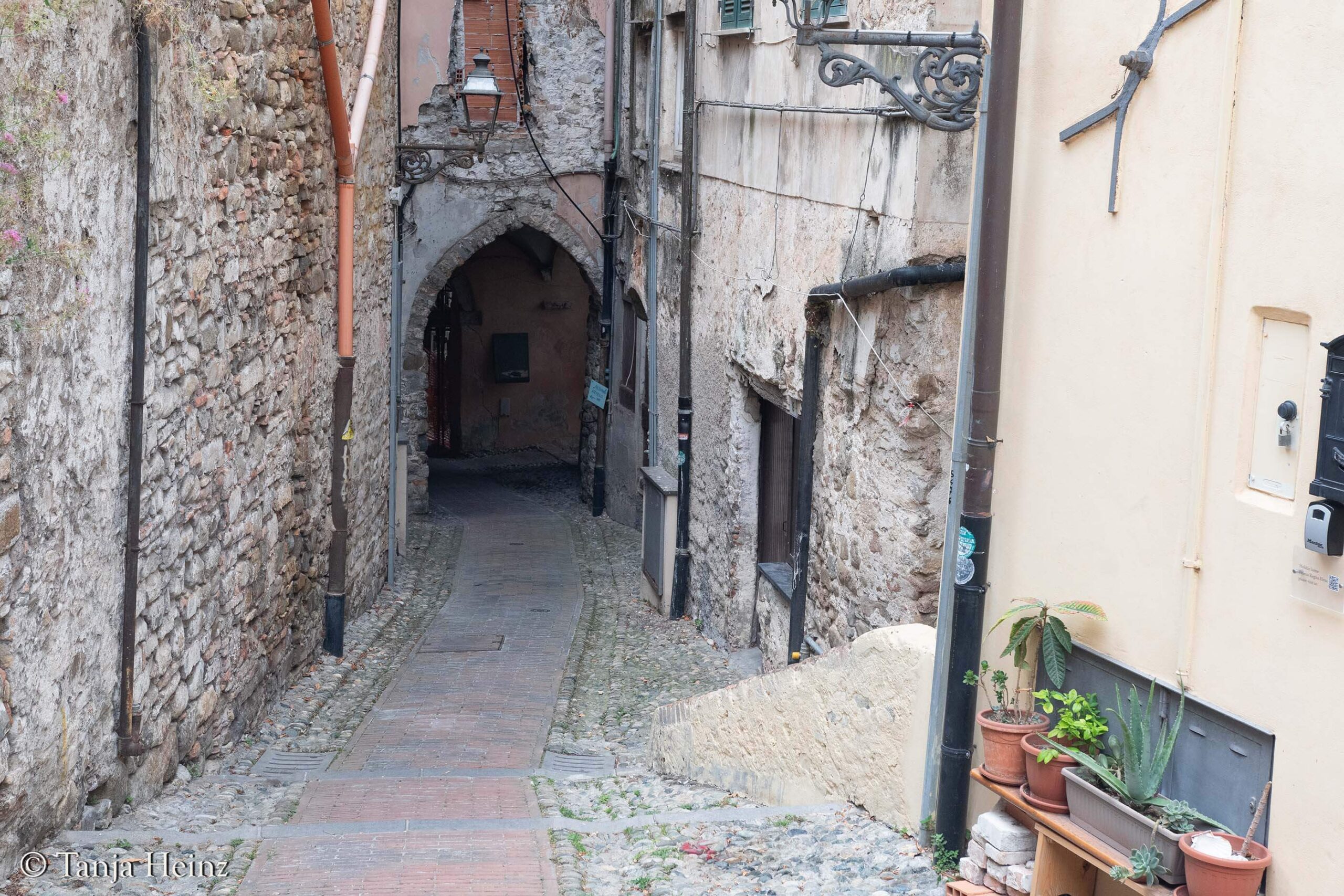


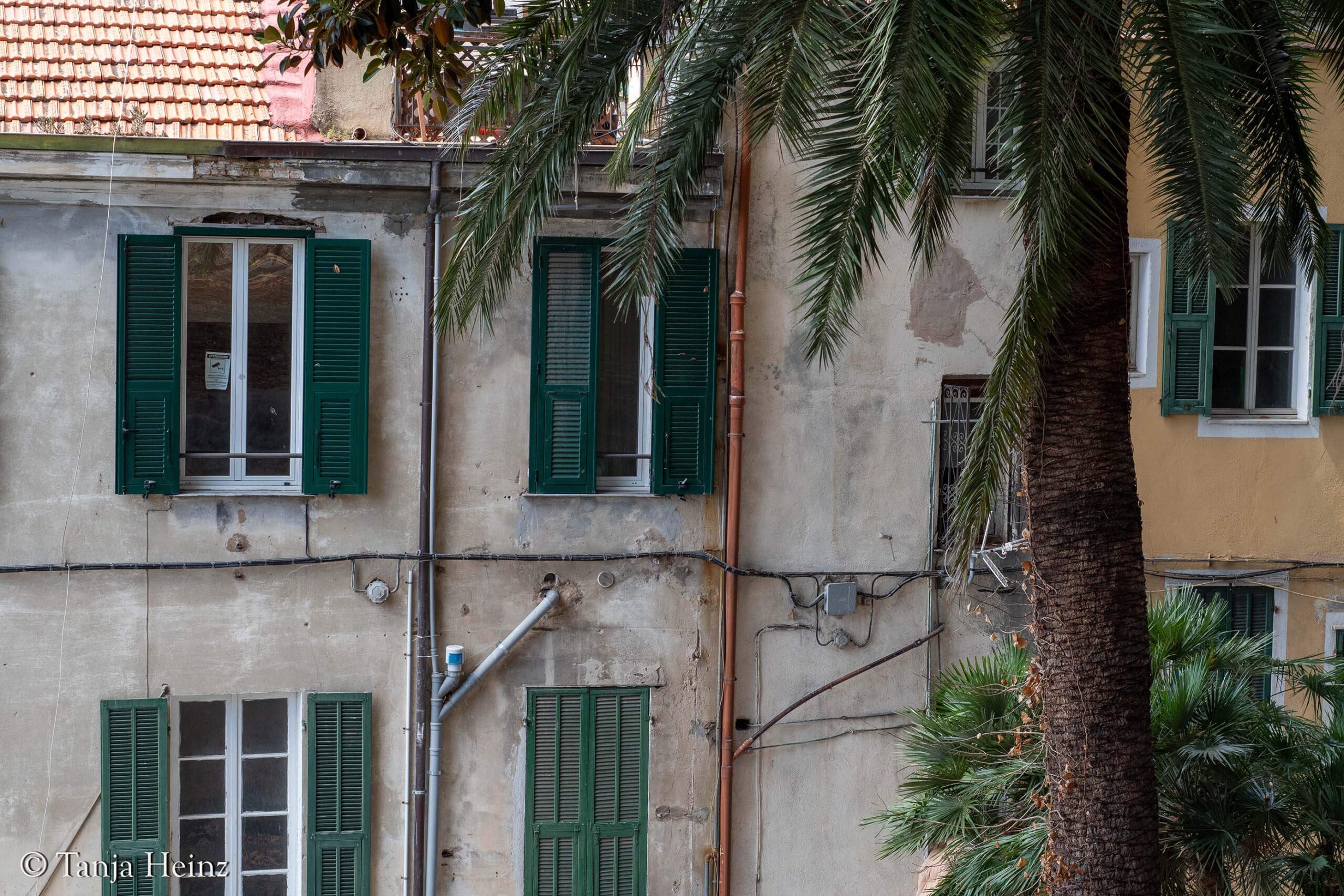
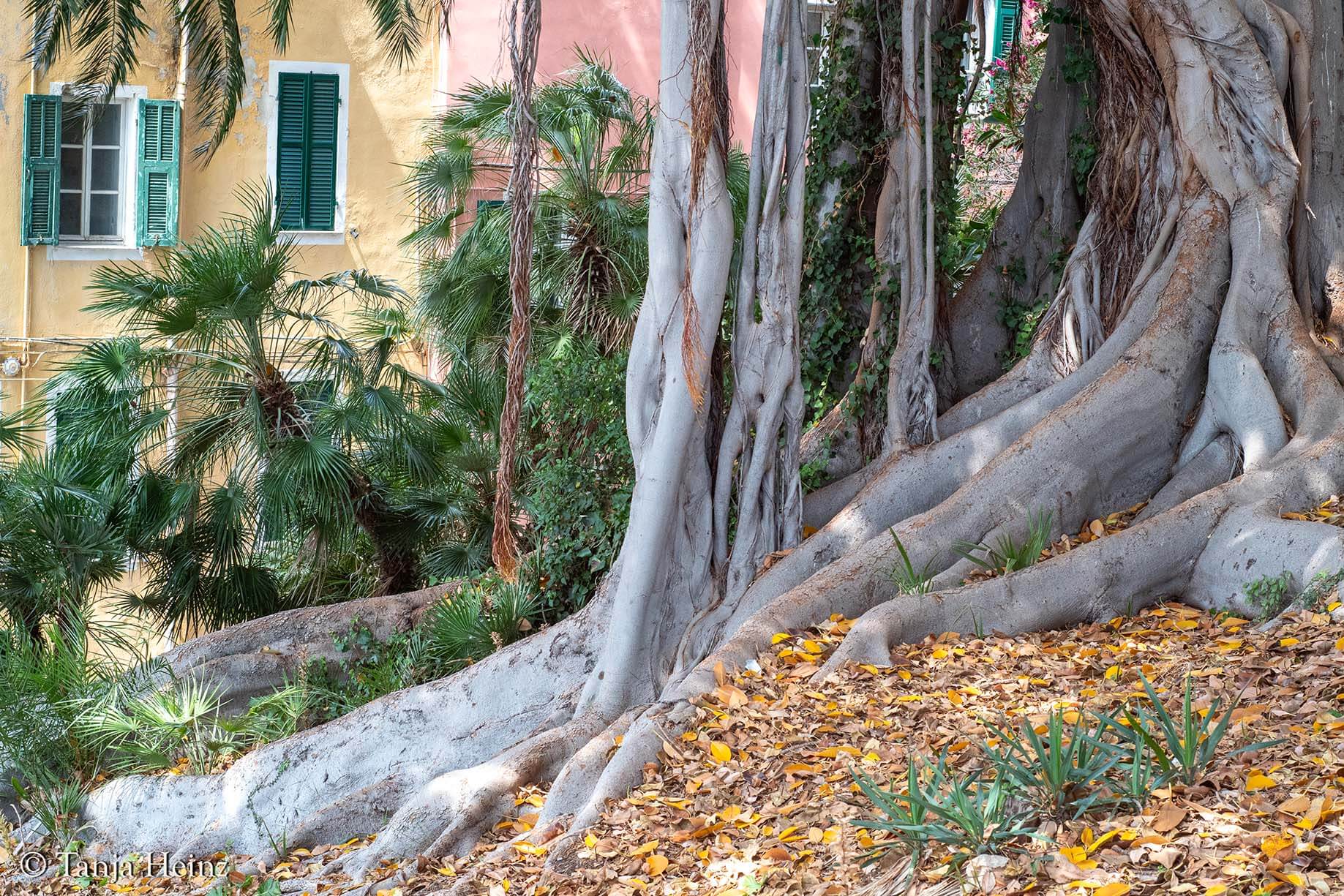
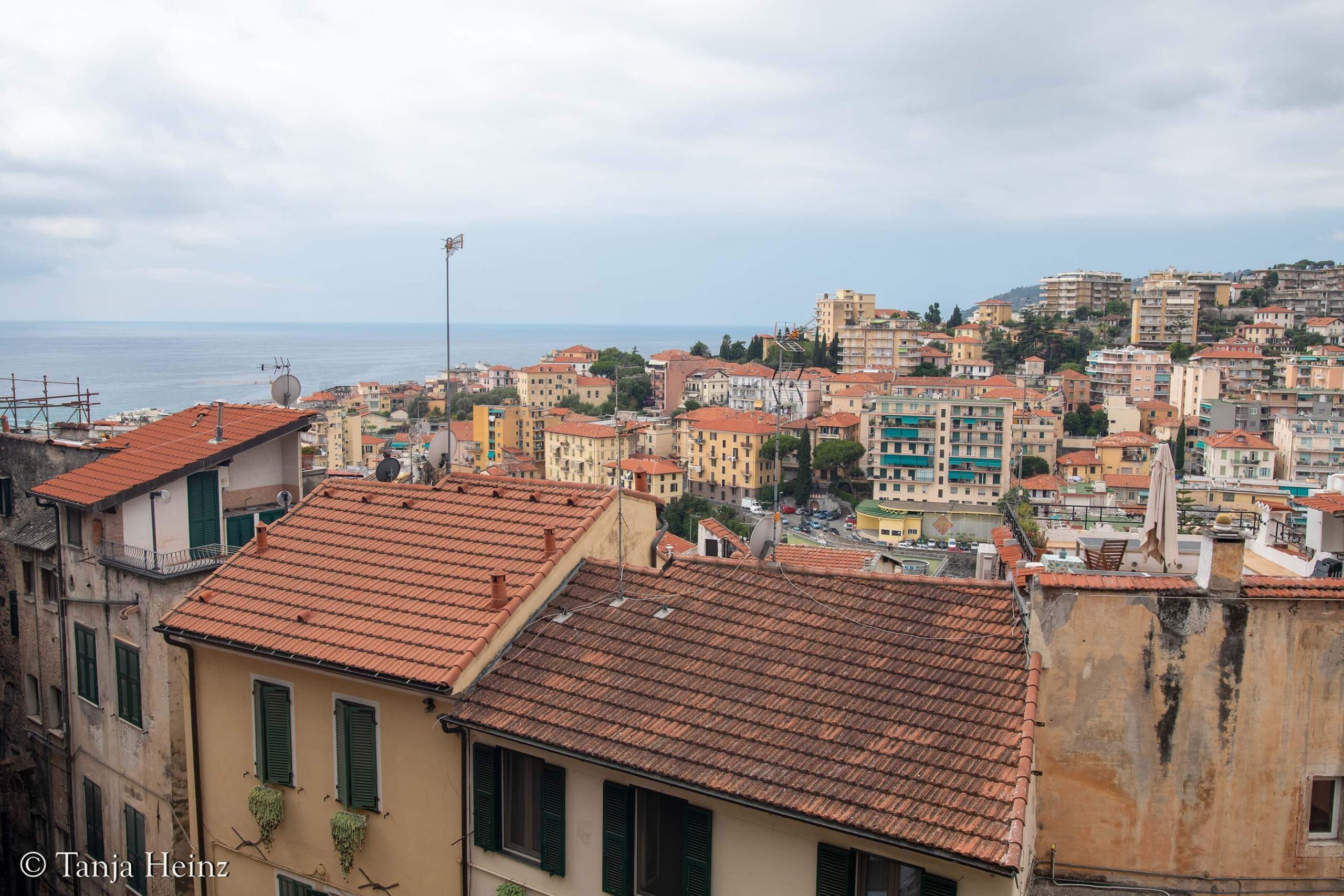
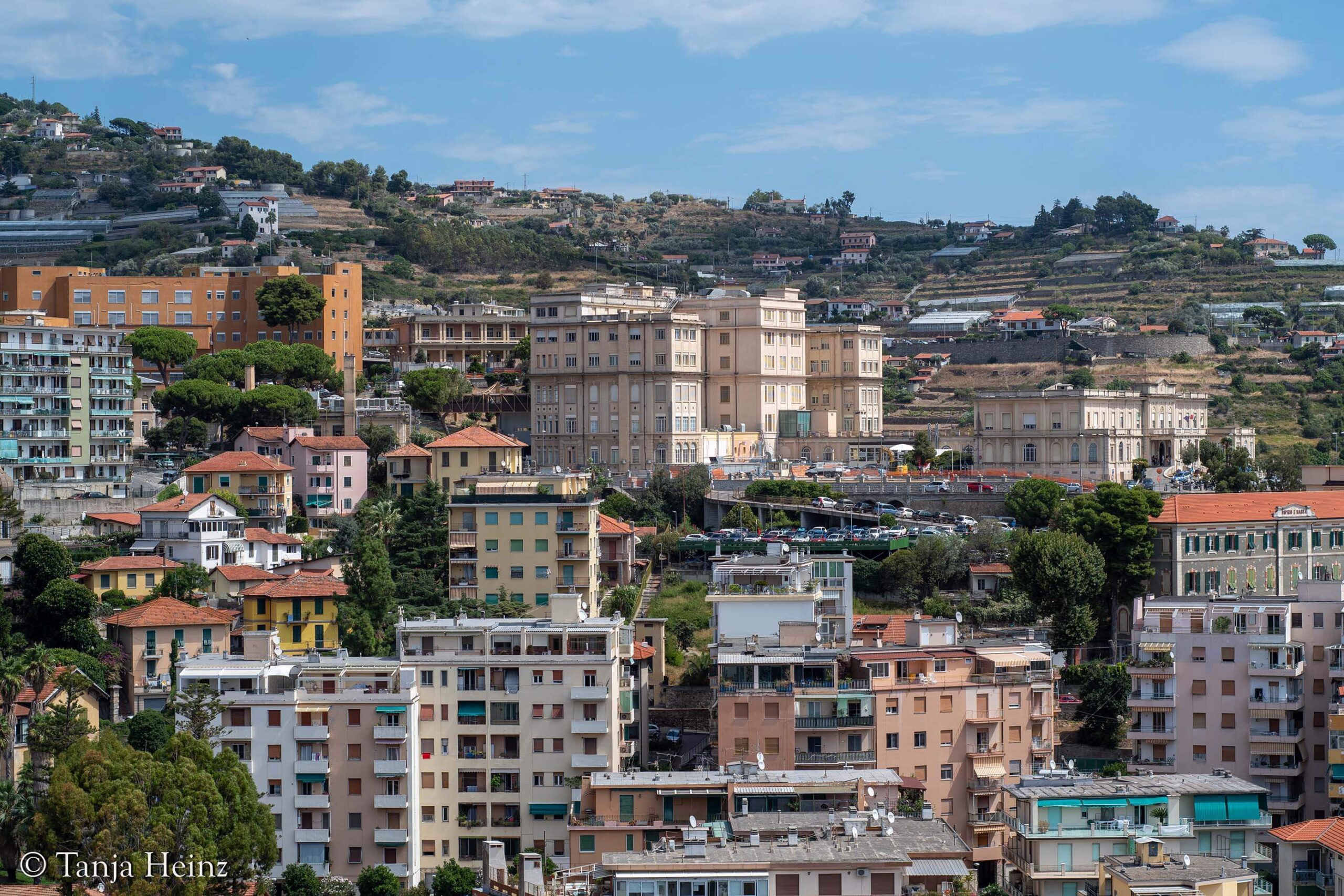
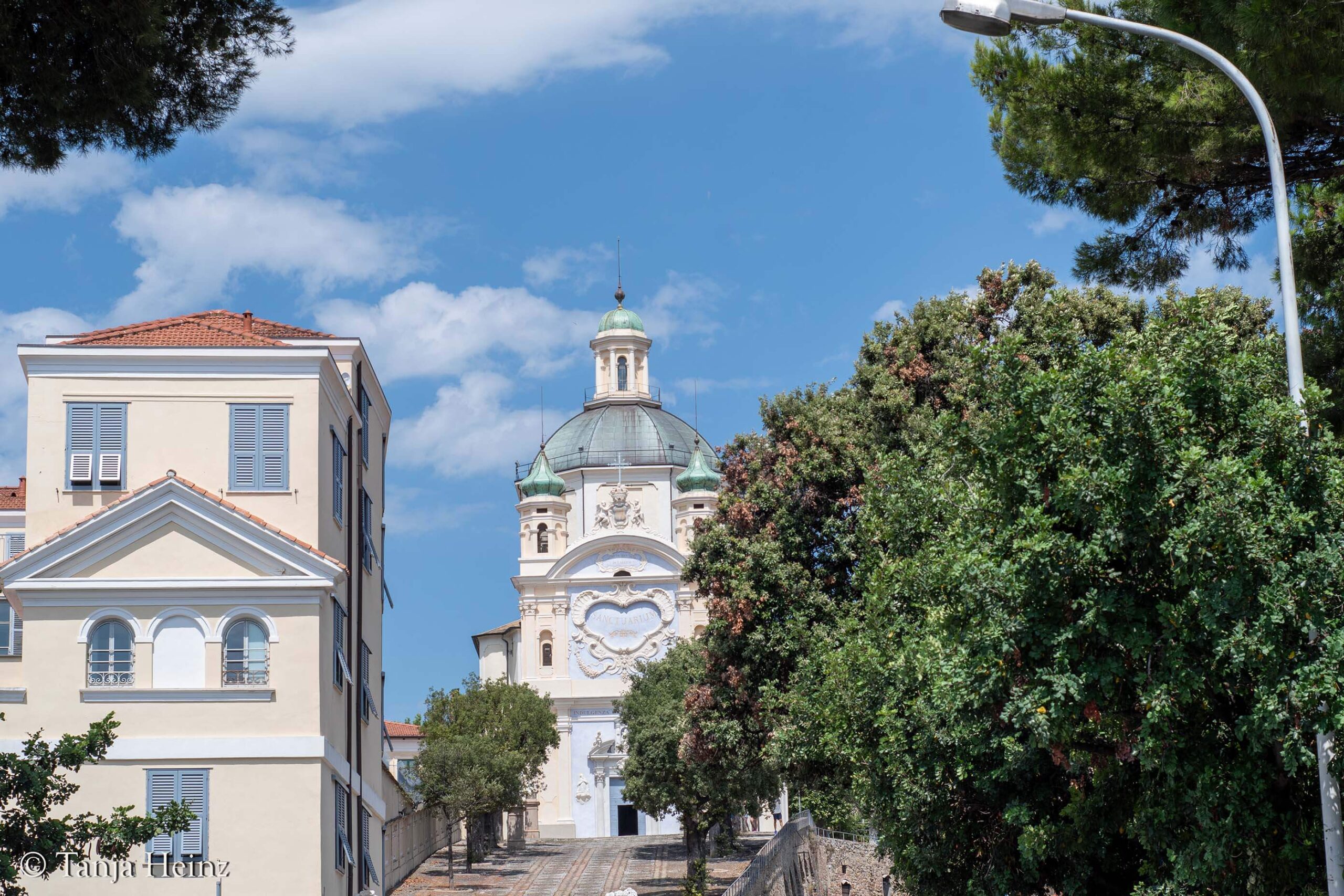
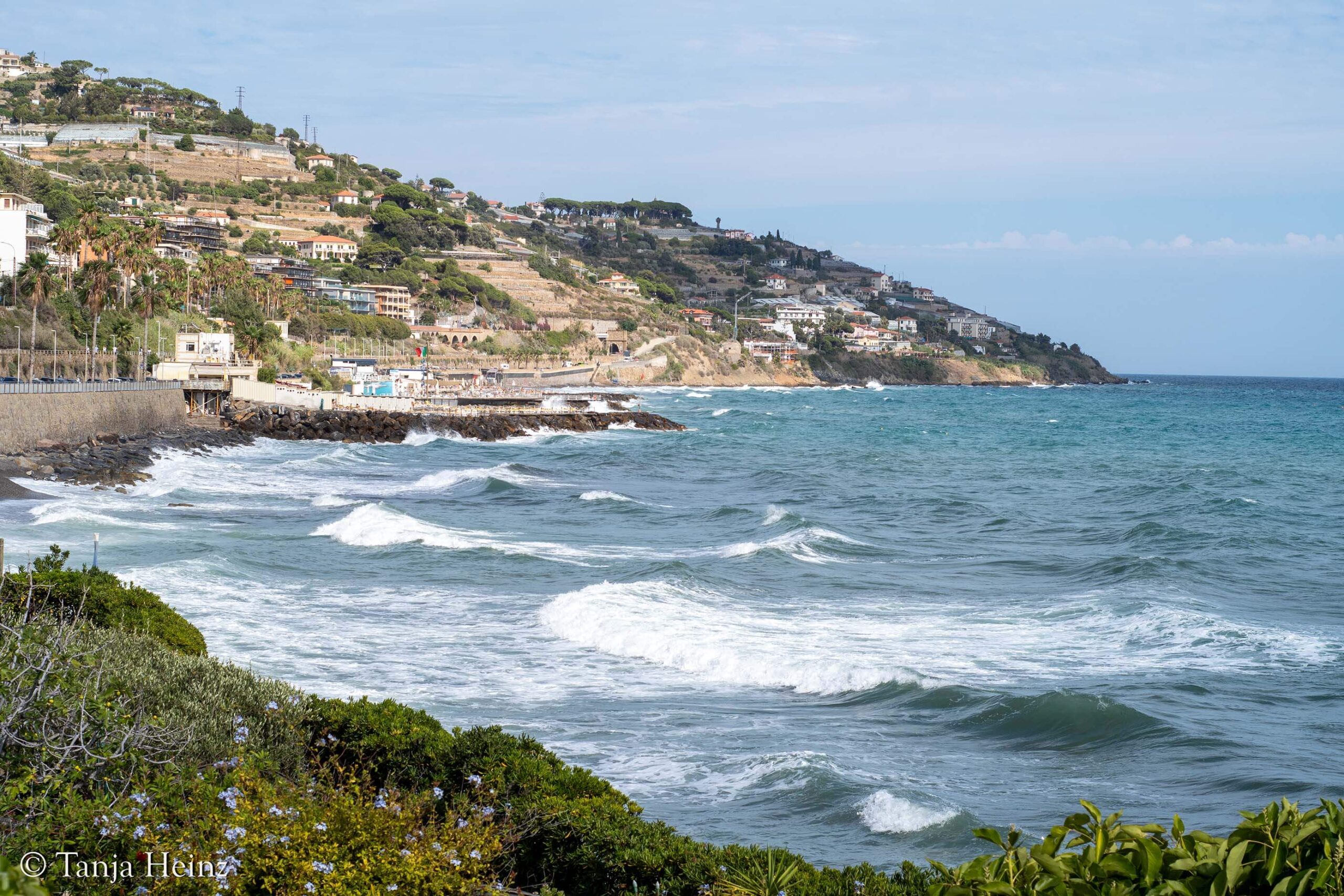
Information: If you're also interested in exploring the French Riviera, I can highly recommend a visit to Nice. It’s a beautiful and vibrant city with a lot to offer. From there, I took a day trip to Monaco to visit the famous Oceanographic Museum — a fascinating place for anyone interested in marine life. If you’d like to know more about that part of my journey, feel free to check out my other blog post where I share more impressions and information.
Practical information
How to get there
Since I stayed in Nice (France) before watching whales and dolphins in the Mediterranean Sea, I took the train from Nice to Sanremo. First, I bought a ticket from Nice to Ventimiglia, which cost around 10 euros and took about one hour. Then, in Ventimiglia, I had to change trains and buy a new ticket for the route from Ventimiglia to Sanremo. This ticket cost me 3.30 Euros, and the journey took only about 15 minutes.
Accommodation
During the excursion with the Tethys Research Institute, we stayed overnight on the boat, so I didn’t have to worry about finding accommodation. However, I spent the night before the tour in a guesthouse, just in case of any delays or unexpected issues. After the five-day excursion, I took a bus back to Germany on the very same day.
More information
CEAM: Mediterranean Sea Surface Temperature
June 2025 Marks Third Warmest June on Record Globally
European Sea Surface Temperature
Wikipeadia: Mediterranean Sea
Wikipeadia: Ligurian Sea
Facts about the Mediterranean Sea on Britannica
Official website of the Tethys Institute
Study area of the Tethys Institute
Pelagos Sanctuary in the Ligurian Sea
More information about the Pelagos Sanctuary
Cetacean species in the Pelagos Sanctuary
Have you ever seen whales and dolphins in the Mediterranean Sea? If yes, which species have you seen? Please let us know in the comments.
